
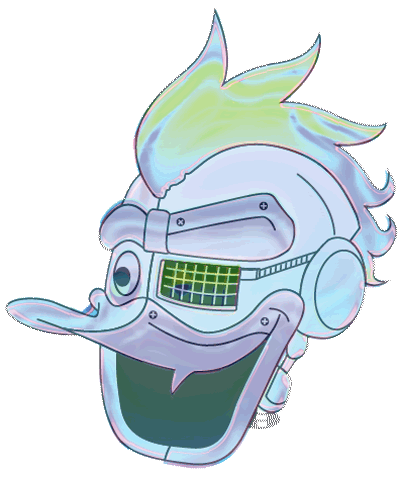

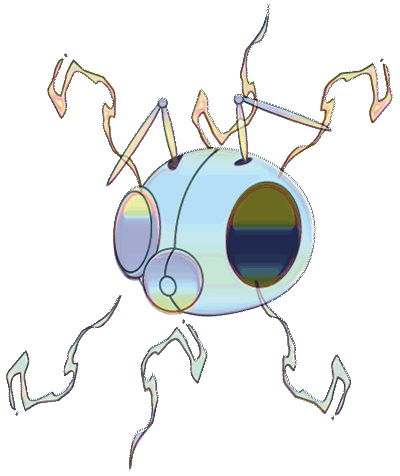
7 – 8.30pm – Introduced by Ruth Catlow and Janez Janša
We invite you to join us for the screening of the documentary film My Name is Janez Janša (2012) as part of Identity Trouble (on the blockchain) the second event in the DAOWO blockchain laboratory and debate series for reinventing the arts. The film will be introduced by Ruth Catlow and Janez Janša, director of My Name is Janez Janša.
“The system of reference of names started to crack … This made me reflect on issues such as identity vs identification, multiplicity vs multiplication, the name as an interface between the private and the public, and the personal name as a brand.” – Janez Janša, Director of My Name is Janez Janša.
Following the second DAOWO workshop, we present this film about names, identity, and pseudonymity in a long history of academic, artistic and popular identity play for political and personal reasons. In 2007 three artists changed their names to that of Janez Janša, the then Prime Minister of Slovenia, whilst remaining ambiguous about their reasons. This documentary film reflects on the subjective and public meaning and utility of a person’s name and documents the interpretations and responses provoked by journalists, the general public and the “original” Janez Janša.
The Janez Janša® exhibition is on display at Museum of Contemporary Art Metelkova, Ljubljana, 18 October 2017 — 08 February 2018
The DAOWO programme is devised by Ruth Catlow (Furtherfield) and Ben Vickers (Serpentine Galleries & unMonastery) in collaboration with the Goethe-Institut London, and the State Machines programme.
This project has been funded with the support from the European Commission. This communication reflects the views only of the author, and the Commission cannot be held responsible for any use which may be made of the information contained therein.
It was not the cyberpunk universe you were looking for.
Our nostalgia centres were lit up with a cut from a flying car to a full screen eyeball staring across the opening scene, synchronized on the script and musical score of its 20th century precursors’ timing. From there, audiences of the Blade Runner sequel were dropped into a pale California wasteland blanketed with conglomerate agricultural biofarms, an antithesis to cyberpunk’s damp, urban hybridity. The green, utopic space beyond the city– only glimpsed at the end of the 1982 original theatrical release and removed entirely in the director’s cut– was where we started from in Blade Runner 2049, and (surprise) there’s nothing but the dystopia of the anthropocene to look forward to there either.
Times change.
The recently post-industrial, 20th century cyberpunk rebellion of bodily sensuality: the noir lighting, the baroque candelabras burning, the lingering fingers stroking out haunting piano music; these were relics now, hinted at, ghosts of a genre in its past moment. Even the endless rain characteristic of the cyberpunk genre was repeatedly replaced with snow in Blade Runner 2049. A borrowed soundtrack teasing the familiar bridge to a heroic death scene came without poetic dialogue or even a witness. Rogue replicants were not criminals, but escaping criminality. Even memories were no longer stolen in this world, but legally manufactured, a convention stripping the typical cybernetic plot of bioharvesting found in cyberpunk down to a more contemporary, bioengineered ethics of classed and raced co-humanity if ever there was one. No, this ethical failure was smoother, blended into liberal values and legal structures, more sanctioned somehow.
The 80s cyberlibertarian world of the white lone wolf, struggling for autonomy in a hybrid, post-globalized world of orientalist economic takeover, had passed by in the great data “black out” of 2020 apparently, and Denis Villeneuve didn’t care about your need for consistent genre romance. Sort of. Rather, the director brought the audience’s need for Blade Runner nostalgia in and out of the sequel like a tool, cuing our attention to wait for it, partially rewarding us with a sensory, semi-nostalgic moment, only to glitch before nostalgic completion. Again and again, it was invitation and estrangement from our own expectations. Blade Runner 2049 was a highly self-aware remix of its own postmodern references and refusals in a predetermined world.
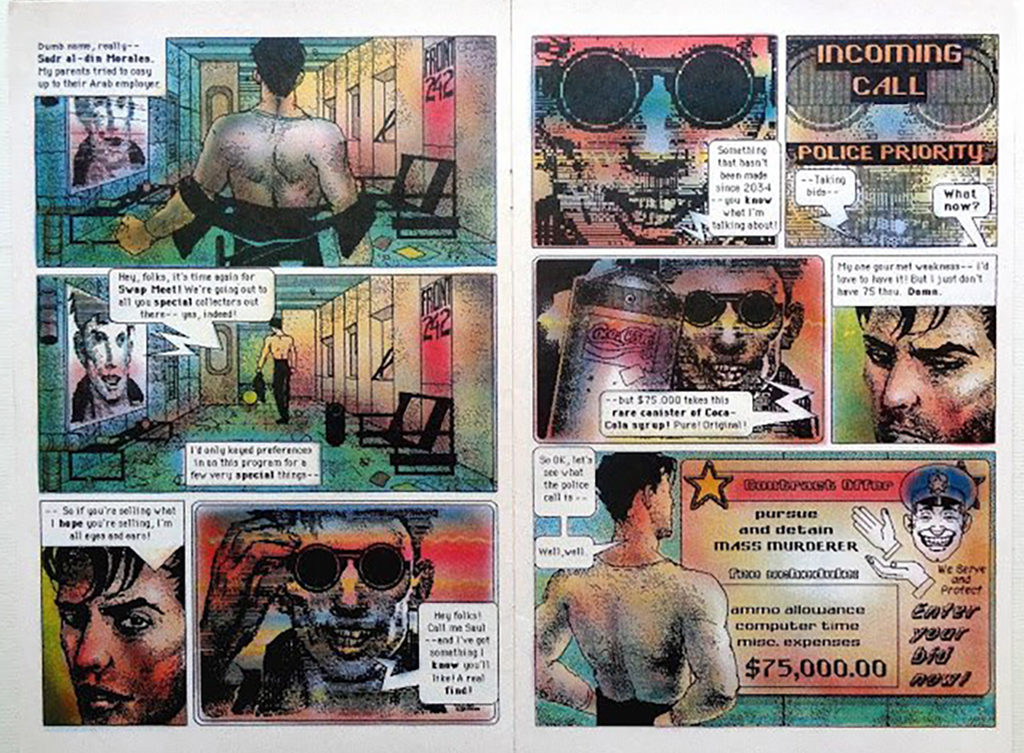
Perhaps a hybridity across two cyberpunks of historical time and cultural change was apropos. Ridley Scott’s genre critique of the corrupt corporation had evolved since its 20th century take in the Alien franchise, expanding to consciously address our own implication in the techno-dystopian social narrative. It turns out that we are no longer universally laboring blue collar victims in the secretive horrors of impending biopolitical technocracy. Rather, we are eager and satiated participants in its isolating ubiquity; high tech consumers implicated in all of the attendant social stratification, inequality, and suffering that its warm glow of access masks and accelerates, from facilitated gentrification and casualized labor, to the toxic, extra-legal wastelands of dead electronics processing.
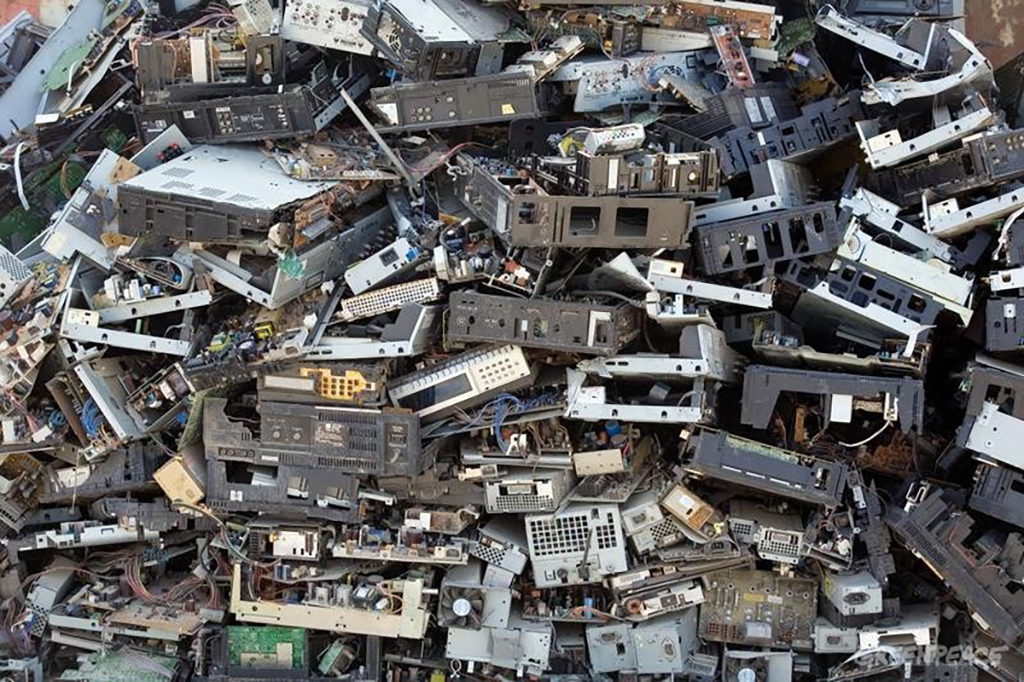
Disruptive innovation has predominantly benefitted the 21th century, western, science fiction audience. Our classic cyberpunk desire for the vindication of the social outlier– the androgynous Sigourney Weaver in a corporate-threatened future of full equality and bodily autonomy, or the replicant who can reclaim a subjectivity beyond his or her social paradigms and slave programming– has since been turned on its anti-establishment head. Scott’s film Covenant saw this come to fruition when the Menippean Anti-hero, Bakhtin’s rebellious, paradigm-questioning literary figure cloaked in the absurd eloquence of language, is fledged into a full sociopath. We saw this in the philosophical and intellectual character of David and his calculated experiments to replace the evolutionarily inferior human species. If Menippean satire is “a genre for serious people who see serious trouble” (Howard Weinbrot), than what is this?
By Covenant, our anti-hero no longer presented the humanistic redemption narrative of the Menippean Nexus 6 leader, Roy Batty, in the original Blade Runner. Instead, Covenant gave its inverse: a regressed society being shown the mainstream values it has come to love and endorse in a world of neoliberal anti-establishment leadership. So much for the underground resistance crouching in the street garbage. The 21st century universe of cyberpunk has been one of well-mannered disruptive innovators of the species, philosophically visionary proponents of transformative wealth models built on slave bodies, and the “technê-Zen” veneered (R. John Williams) institutionalization and naturalization of technological sociopathy. Here is a social darwinist instrumentalism for our post-human age of market-driven measures of social success and impending climate change. In this universe, androids can be humanist while humans can be androids in an inhuman system, conveying either ‘progress’ by any means necessary or a losing sense of civilizational duty. Whose side, Covenant asked of us, before its devastatingly feel-bad ending, were you hoping would win anyway?
David, it turns out, was the only anti-hero we deserved now.
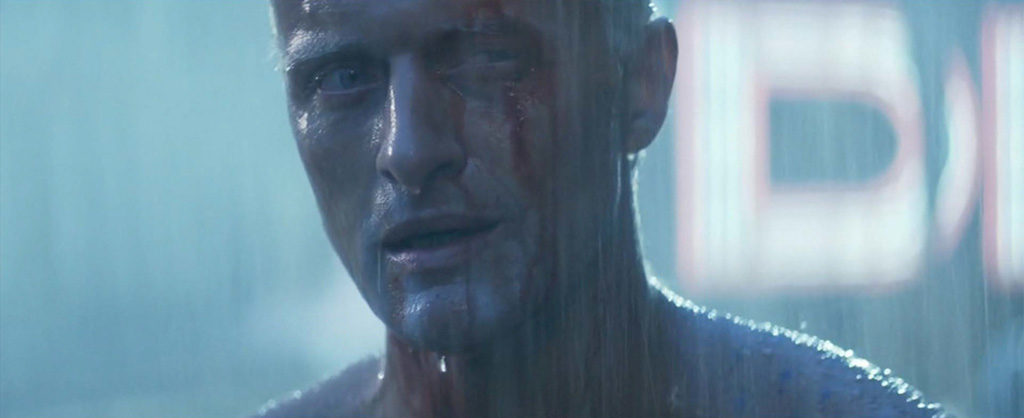
Denis Villeneuve’s sequel fits surprisingly in this updated cyberpunk universe. Like Walter in Covenant, the replicant hero who becomes Joe in Blade Runner 2049 (in contrast to Roy Batty) clearly lacks the eloquent language and especially satire of the subversive, Menippean Anti-hero character. Surprisingly, we find his strain of articulate stream-of-conscious in the tech empire guru played by Jared Leto, drained of all the feeling and trickster-like ability of Roy Batty. Joe, however (like Walter), is simple and humble in his speech, seemingly able to feel but dying suggestively in silence off screen. Robbed of the poetic dialogue expected of the death scene, only a soundtrack bite nostalgic of Roy Batty’s final scene signals a death of redemption for Joe in Blade Runner 2049. Yet the unsentimentally raw, blank slate of Joe’s expression asks of his audience: What do we see through his eyes? What language could possibly be used here to convey the gravity of a moment when power so regularly denies and manipulates the language of our experiences? In this silence, we are perhaps left to only wonder what we would be feeling.
What if it had ended differently? Would Roy Batty’s eloquent speech achieve the same humanizing disjuncture today, or does it really belong now to Niander Wallace, our tech monopoly visionary of the neoliberal age, emptied of any contradiction with the smooth flow of progress rhetoric and sociopathic public morality? Niander Wallace as foil who cannot stop talking makes Joe’s uncharacteristic silence all the more uncanny. According to Jonathan Auerbach, the uncanny involves a “trespassing or boundary crossing, where inside and outside grow confused… reveal(ing) dark secrets hidden within.” Auerbach is talking about film noir here– a highly unsettling sensory genre metabolized into the late Cold War aesthetics of the Blade Runner world. But perhaps we can relate this psychic role of the filmic uncanny to other hybridities explored through expressionist media, where the formal manipulations of sight and sound once conveyed the uneasy clashing of two worlds affectively.
Is Villeneuve’s silent denial of a hero’s dialogue in a death scene, for a Blade Runner audience, purposely estranging? Does it achieve the same, disorienting “uncanny bodies” (Robert Spadoni) that silent film audiences, unaccustomed to sound in their movies, reported with the introduction of Talkies? Film scholar Shane Denson describes how post-Talkie movies of the Thirties like Frankenstein (1931), were created in a period of transition and between the old and new ontologies of silent and sound film media. Denson argues that such films, working after the initial novelty of Talkie exposition wore off, played affectively with the new hybridity of films formalist storytelling qualities. In doing so, these films drew attention to our participation in media: “sight and sound conspire(d)…to encourage the viewer’s medium sensitivity, to coalesce with the perception of a constructed monster.” And what is a sequel, after all, if not a constructed monster of narrative to become conscious of?

“Questions.”
We live in a time of the seductive post-human technologization and normalization of very inhuman institutions, public policies, and person-like entities whose social impacts are all too often screened over with ‘alternative’ narratives of language. Glitches in this flow of mainstream mediated ways of knowing can be more than anti-nostalgic; they can be disruption to the alt-fact hyperreality in the neoliberal 21st century. Are uncanny bodies of the sensorily unexpected (or, even, dissected) what we have left to successfully slow down and stutter our neoliberal ubiquity for hearing chasm-filling speech? Can such estrangements allow us the conscious relationality to once again actually hear and see how we are hearing and seeing each other?
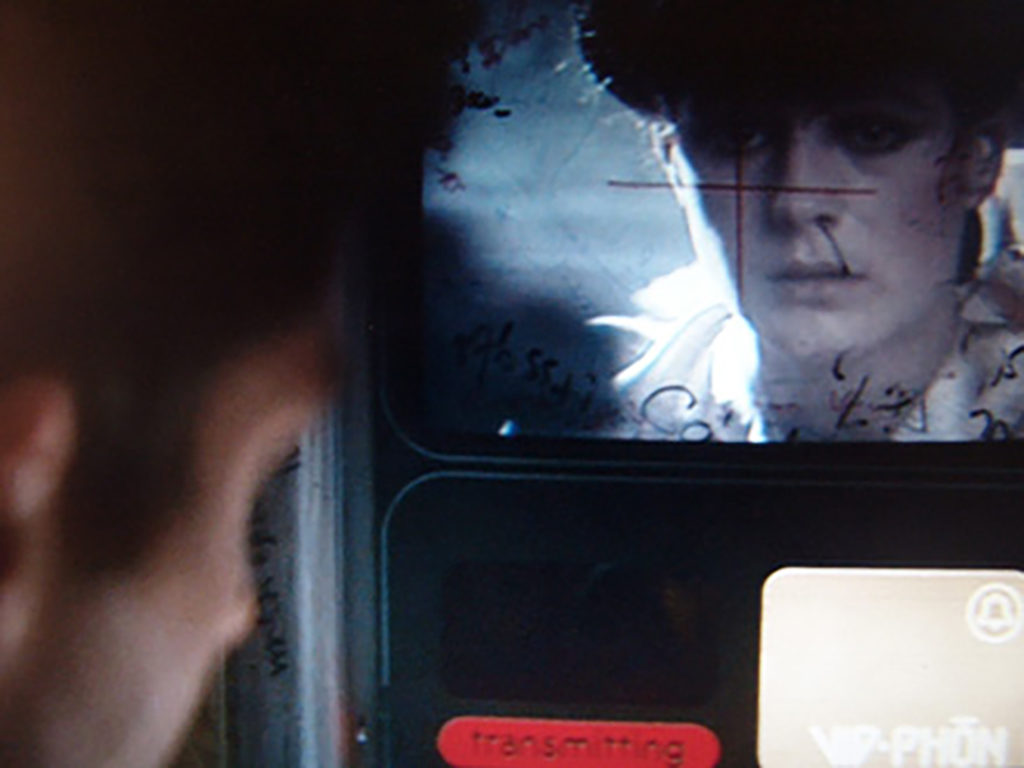
It is convenient to note here that the technological imaginary of the first Blade Runner movie refused ubiquitous surveillance. Blade Runner 2019 even refused a conception of the personal communication device so often credited with fracturing collective sociality in both sci-fi and reality. Decker, for example, calls Rachel from a public videophone in a bar. Whether human or replicant, technological worlding of the original Blade Runner insists on the communications scale of face-to-face human relationality. By the end of Blade Runner 2049 this same scale of technological imaginary in the original film returns. It is the death of one body, the replicant called “Luv”, that seems to end the limitless reach of panopticon technology that helps advance the plot.
Some kinds of love can destroy. Scene from Blade Runner 2049
This act leaves the future of Blade Runner’s Earth yet again to the relations between two, individual physical bodies. With the 1% most likely afloat in the outer world colonies, we might assume this means that it’s up to Us to cross the interface of hyberbaric differences. At a time when love has become perverted with neoliberal logic– instrumental, utilitarian, stripped of its greater sense of equality or duty– it seems that Villeneuve graciously gives us an answer here, if not a fantasy to hold on to. Perhaps one consistency in the Blade Runner franchise is the argument, like that of Junot Diaz on neocolonial oppression (as if it ever ended) and the uptick of white supremacist domestic terrorism, that it is ultimately intimacy with the Other and rejection of the glorified “lone wolf” mentality that must be revolutionary: “Vulnerability is the precondition to contact.” What if being in our present moment requires the vulnerability of silence?
“Listen:”
Nostalgia has come unstuck in time. In Ghosts of My Life, the late Mark Fisher wrote extensively of the threat of nostalgia in postmodern cultural production. Building on theorists Frederic Jameson and Bifo Berardi to explain the bending of new technologies to recycle comfortable and profitable cultural forms for capitalism, Fisher explains how “…the nostalgia mode subordinated technology to the task of refurbishing the old”, not of specific past styles, or periods, but forms of never-fully-present time asynchronicity. Consider it like another outdated, self-reproducing model, ever expanding all around you to stay relevant. Perhaps you can finally see its now, like a loose eye, engineered, removed from its familiar socket.
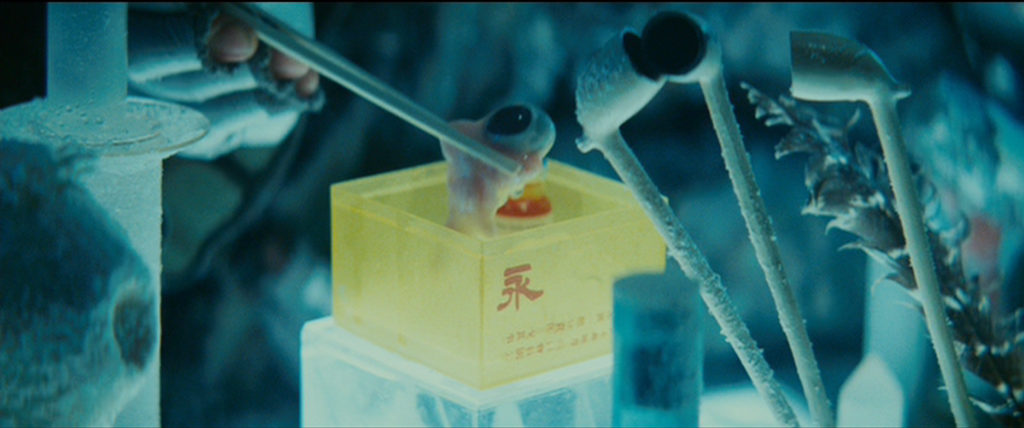
Transgressive fiction has this way of making our boundaries visible in the crossing. The reader may resist its dehumanization, suddenly queasy. Barthes once wrote about the surrealist Georges Bataille’s Story of the Eye, a modernist novel from the early mid-20th century which indeed involves a plucked eye and its “metaphorical journey” across other eye-like images. An object, he wrote, “can pass from hand to hand… or alternatively it can pass from image to image, in which case its story is that of a migration, the cycle of the avatars it passes through, far removed from its original being, down the path of a particular imagination that distorts but never drops it” (his emphasis). Barthes felt The Story of the Eye was less a novel and more like poetry. Through its avatars and crossing of sensory metaphors, the eye simultaneously “varies and endures.” Consider the following example of crossing sensory metaphors from the Blade Runner sequel: eyes, cells, tears, rain, leaking, bleeding, blinking, seizing, splashing, drowning, watching, “cells”. And what if this thing we now strangely see so differently is neither naturally born nor autonomous, but a constructed thing?
How eerie.
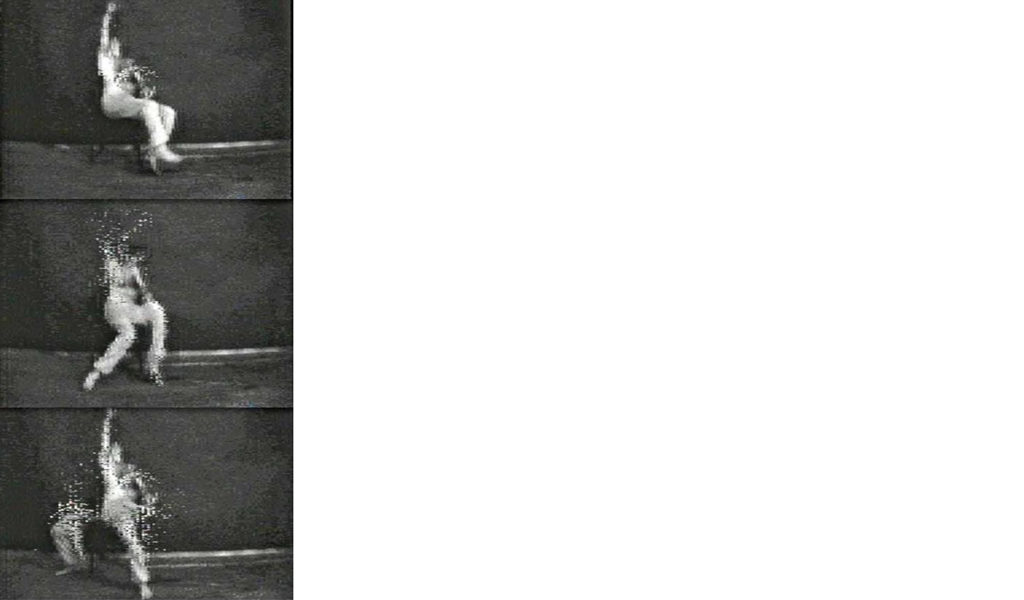
Eerie like the absence of “future shock” in the futuristic. According to Fisher, nostalgia mode production is an aspect of the “cultural logic of late capitalism” that “…disguise(s) the disappearance of the future” and prevents any real possibility of innovative “rupture”. Nostalgia in our entertainment helps stabilize the “cultural deficits” created under globalization, soothing the simultaneous “exhaustion and overstimulation” of instantaneous and transactional relations we can’t seem to deal with. It fills a high-speed chasm of emotion, truth, and meaning. It denies us the “uncanny” recognition of our temporal futurelessness, left teetering on neoliberalism’s precarity of resources “despite all its rhetoric of novelty and innovation…”
Let’s just be honest here: by the time the Coke commercial hologram showed up in Blade Runner 2049, it was a joke on our desire for even nostalgic product placements.
Nothing changes.

Dipping into the media art world at this borderland, theorist and filmmaker Hito Steyerl writes in “A Thing Like You and Me” about the video that David Bowie put out in 1977 for “Heroes”:
He sings about a new brand of hero, just in time for the neoliberal revolution. The hero is dead—long live the hero! Yet Bowie’s hero is no longer a subject, but an object: a thing, an image, a splendid fetish (…) the clip shows Bowie singing to himself from three simultaneous angles, with layering techniques tripling his image; not only has Bowie’s hero been cloned, he has above all become an image that can be reproduced, multiplied, and copied, a riff that travels effortlessly through commercials for almost anything, a fetish that packages Bowie’s glamorous and unfazed postgender look as product. Bowie’s hero is no longer a larger-than life human being… but a shiny package endowed with posthuman beauty: an image and nothing but an image.
What are we to do when no degree of protest or declaration can make an exploited object be seen as a subject? Where is one to find anti-heroism in all of this? Let us be objects of severe agency then. Models that are perhaps transferrable, but unobtainable. One of a kind and replaceable. Constructed yet autonomous.
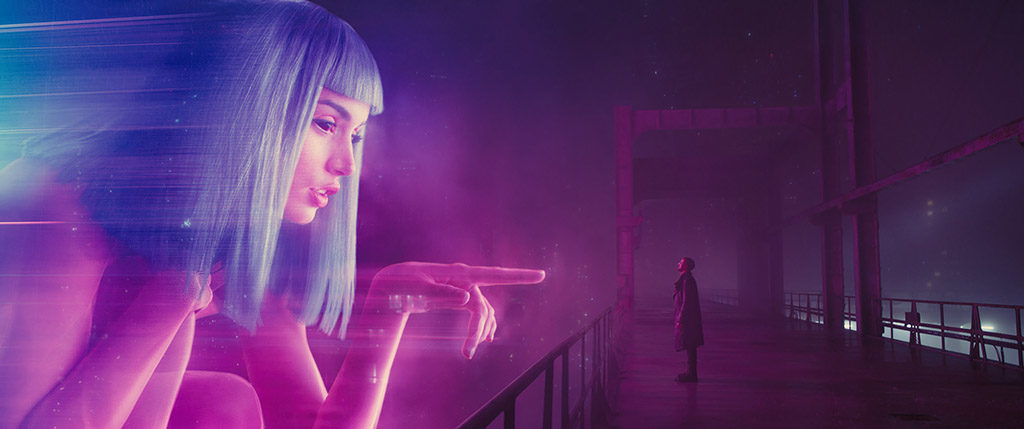
Perhaps then we can only view these things in suspension: the need and refusal of nostalgia as liberating human process, the uncanny increments of our cultural evolution to product and media-focused estrangement, the will to see one’s own familiar pixels blown wide open. “Digital information is … characterised by transformation, degradation, circulation,” explains Hito Steyerl in an interview in Rhizome, “but also by its surprising ability to mutate and produce unpredictable results. The glitch, the bruise of the image or sound testifies to its being worked with and working; being passed on and circulated, being matter in action.” Futureless. As futureless as staring into a present ruin, expansive but without destination, the destination without purpose.
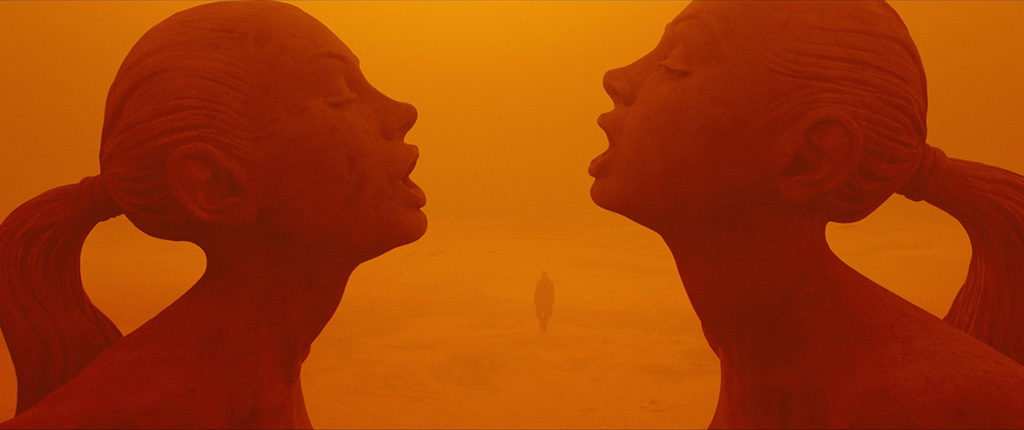
Apropos, then, how our old and new heroes meet in that ruined casino scene, outcasts of white difference (by the future racialization of the synthetic) in an atemporal Las Vegas, framed by primordial Seven Wonder monuments to the our foundational schisms of misogyny (yes I’m also talking about me).
In this incarnated ruin of our stubbornness for cultural mythologies, I was struck by the brilliance of the fight scene, the director literally exploding our pixel expectations of 20th century nostalgia as soon as Harrison Ford makes his long-awaited appearance. The sonic build-up of Decker’s familiar piano in the distance was dissolved by the strange sound of his disembodied voice un-cueing an upcoming appearance in the scene, his visual reveal in that moment of our auditory let down, confusing: Desire misfiring. The ensuing cyberpunk clash-as-fight-scene of 20th century romantic and 21st century post-romantic dystopic characters corresponds to the casino’s hologram interface of an imagined, mid 21st century entertainment technology; all of the expected glamour and nostalgia is allowed to barely seduce us before sputtering and malfunctioning as filmic metascene. Within the plot, these post-apocalyptic hollywood holograms are also a sign of the future sentience to come in the character of Joe’s AI wife, Joi, and a warning that all technology rebels and mutates from initial human intentions, no matter how superficial the design intentions.
My interpretation of this violent casino stage scene in light of a more recent American mass shooting of an ever-expanding, historically singular, and self-containing statistic of “largest ever” is not lost on me. Neither is the choice of mid 20th century entertainers like Elvis and Monroe who notoriously performed like automatons with post-human qualities, their movements in time-space of perfect bodies turning on the master clockwork of a still-industrializing cultural machine before blowing apart, fragmenting. Their avatars echo of consumer-creator bodies in our postindustrial world of 2.0, gig labor, automated economic transactions feigning meritocracy, and a model of precarity demanding the inhuman perfection of individual responsibility for every movement which can shudder, glitch, and explode on other people all too frequently.
This failure is that of speculated, plotted, rationalized, and technologized courses whose error cannot be properly imagined, only realized and refused in the ruins of a short-sighted economic-cultural imaginary. Our looking back on dystopia hints at our present expectations only.
“Irreversability.”
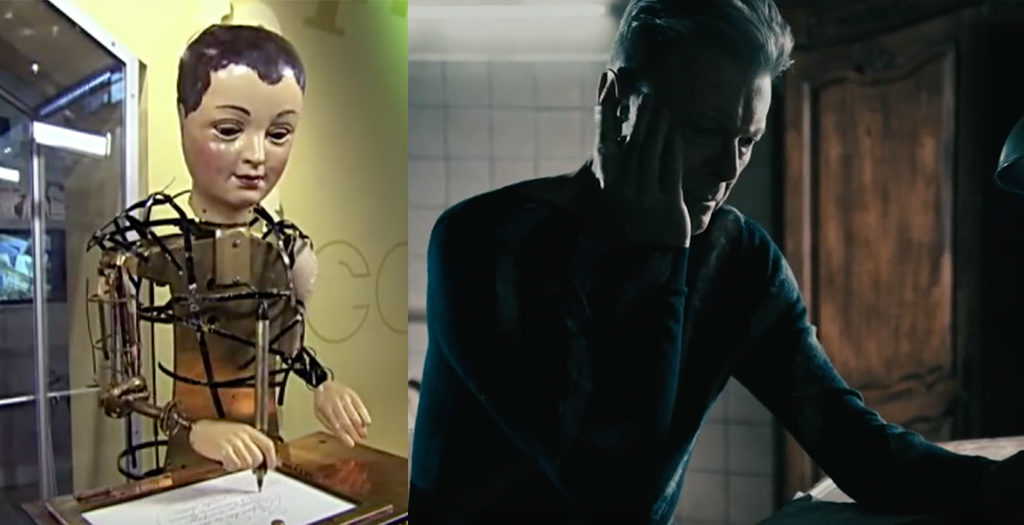
“It’s difficult for someone of my generation to break free of the intellectual automatism of the dialectical happy ending”, writes Bifo Berardi about irreversability. He compares this “taboo” concept to the “silent” apocalypses of our endless growth mentality, like Fukushima, corporate disaster unaccountability, socialized scarcity adjustments, and our silence on fellow human suffering. His book, The Uprising: On Poetry and Finance, speculates a “process of subjectivization” for the return of solidarity to a “social body”. This is the social body being culturally reprogrammed away under our collectively isolated movements of relentless market-driven consumption and precarity (individualist and systemic, like the fascist choreography of Kracauer’s Mass Ornament, or the Las Vegas showgirl spectacle). We might consider these grinding automaton gears of consumption and precarity the logics of late-terminal capitalism for clarity, it’s refusal a glitch in our clockwork performance. What is one to do for a postmodern exit other than to shudder, to write off the page? Ultimately, Berardi’s book leaves us more with a hope for our relational redemption from neoliberal culture through “sensibility” than it does with answers.
Blade Runner 2049 may not have been the sequel people wanted, but its confrontations with its own expectations provided a little of the things we need: a vision of the finite and anthropocene, a postmodern exit to the endless technologized avatars of getting what we think we want, our profound silence of the awful price. The film’s self-aware, nostalgic ruin leaves us with a little less of the typical sequel’s fourth wall, and an identification with its lonely bodies, caught in action between clockwork cultural predictability and its refusal. These bodies may or may not have the capacity for real love, but they are vulnerable at least to a larger sense of duty that Humanism, in all its universalizing failures, really needs. In this hybrid space of ontological awareness of the facets of knowing, experience and process, Blade Runner 2049’s success was inbetween all the things it could never definitively be. We too might realize that ‘doomed to fail’ may only be our insistence on choosing from a predetermined relational binary.
A distant song floats into the scene.
…“Though nothing, nothing will keep us together…”
When I saw Blade Runner 2049, in was at one of the remaining four hundred or so drive-in movie theaters left in the United States. I went back in memory to my kindling college interest in what I study and consider Avantpop, surveying the changes, considering its meaning and meaningless in my social development as a scholar: working class, woman, white, heterosexual; accepted and refused and abused entrances. The sequel came less than thirty years later in the revolution of a world for me, but I travelled farther to get there, out to a dark semi-rural drive-in beyond the city, and a memory of popping in a VHS tape almost 20 years ago simultaneously. I time-traveled mass media ontologies. I posted an instagram picture. It was semi-romantic nostalgia for me. But I still see that there is only now to change what we’re doing. And it is terrifying.
It’s quite an ending, to just die in silence, isn’t it?
But the fourth wall was always part of this, you know.
14.00-17.30 – Workshop devised and hosted by Ruth Catlow and Ben Vickerswith Ramon Amaro, Ed Fornieles Thor Karlsson & Emily Rosamond
19.00-20.30 – Screening of the documentary My Name is Janez Janša (2012) Introduced by Ruth Catlow and Janez Janša
Identity Trouble (on the blockchain) is the second event in the DAOWO blockchain laboratory and debate series for reinventing the arts.
Identity is considered one of the hardest problems in the blockchain space, as it is here that it really matters how human and machinic systems connect. With the potential to fix and potentially impinge upon the relationship between our subjective sense of self, freedom to use multiple identities and our machine-assigned identities.
These difficulties span personal, social, technical and political domains. From a global perspective, blockchains have begun to be put forward as the most efficient and secure solution for providing identification to refugees and with it, access to basic social infrastructure such as healthcare, voting, financial and legal rights and services. As steps towards both national identity and global identity systems are being accelerated, perhaps most notably in Goal 16 of the UN 20 Global Goals, as being; “By 2030, provide legal identity for all, including birth registration”.
These drives sit in tension with fears about the increasing convergence of political and commercial control through identity technologies, tensions between: name and nym; person and persona; privacy, transparency and security; and the interests of the private individual and public citizen. All of which run counter to the proclamation that “Having two identities for yourself is an example of a lack of integrity”.
At the first DAOWO workshop we discovered more about current developments for blockchain application within the arts. At this event we seek to further challenge and reconsider the identity question in the context of the arts-blockchain ecosystem.
This workshop will be opened with a keynote by developer Thor Karlsson who will present Authenteq, an automatic identity verification platform and discuss his company’s approach to design for “trust and transparency in communications and transactions between users”.
This will be followed by a series of provocations by theorists and arts practitioners on cultural identity jamming, dangerous bias in the datasets that inform machine learning, and decentralised reputation management.
Laying foundations for the workshop in which we will work together to develop new stories about a set of characters living in the arts. How they operate and feel differently as the impact of blockchain technologies takes effect on their personal and professional role within the artworld.
Join us to describe what will go wrong? And what might just work?
“The system of reference of names started to crack … This made me reflect on issues such as identity vs identification, multiplicity vs multiplication, the name as an interface between the private and the public, and the personal name as a brand.” – Janez Janša, Director of My name is Janez Janša
Following the second workshop of the DAOWO series we present this film about names, identity and pseudonymity in a long history of academic, artistic and popular identity play for political and personal reasons. In 2007 three artists changed their names to that of Janez Janša, the then Prime Minister of Slovenia, whilst remaining ambiguous about their reasons. This documentary film reflects on the subjective and public meaning and utility of a person’s name and documents the interpretations and responses provoked by journalists, the general public and the “original” Janez Janša.
The Janez Janša® exhibition is on display at Museum of Contemporary Art Metelkova, Ljubljana
18 October 2017 — 08 February 2018
Ramon Amaro
Ramon Amaro is a Lecturer in Visual Cultures at Goldsmiths, University of London; Research Fellow in Digital Culture at Het Nieuwe Instituut in Rotterdam; and visiting tutor at the Royal Academy of Art, The Hague. Ramon has worked as a former Assistant Editor for Big Data & Society (SAGE), quality design engineer for General Motors, and programmes manager for the American Society of Mechanical Engineers (ASME). His research interests include philosophy, machine learning, and black study.
Ed Fornieles
Ed Fornieles is an artist whose works are responsive to the movement of information. Fornieles uses film, social media platforms, sculpture, installation and performance to express the interaction of family, relationships, popular memes, language and the subcultures of 21st century experience. His work operates within the logic of immersive simulations, which construct and enact alternative political and social spaces. His projects often involve cultural, social, and infrastructural production, making interventions that reconfigure the viewer’s position and sense of self.
Thor Karlsson
Thor Karlsson is the lead backend developer at Authenteq, a privacy tool and identity verification platform for online services. With over six years of professional experience in .NET and Java, Thor works in backend systems with an emphasis on clean code, testability and optimization. Thor is currently focused on implementing core backend systems used for the Authenteq ID verification and face recognition platform.
Emily Rosamond
Emily Rosamond is a Canadian artist, writer and educator. She completed her PhD in 2016, as a Commonwealth Scholar in Art at Goldsmiths, University of London. She is Lecturer in Visual Cultures at Goldsmiths, and Joint Programme Leader on the BA Fine Art & History of Art. She exhibits individually and with the collective School of The Event Horizon.
The DAOWO programme is devised by Ruth Catlow (Furtherfield) and Ben Vickers (Serpentine Galleries & unMonastery) in collaboration with the Goethe-Institut London, and the State Machines programme.
This project has been funded with the support from the European Commission. This communication reflects the views only of the author, and the Commission cannot be held responsible for any use which may be made of the information contained therein.
The word speculation is defined as ‘the forming of a theory or conjecture without firm evidence’. The act of speculating was predominantly popularised with the rise of the stock market, however, recent environmental destruction and technological advancements have prompted a rich pool of speculation about the future of our planet, our species and our connection to other facets of life. Tomorrows: Urban Fictions for Possible Futures is such an exhibition, compromised of imaginative narratives speculating the future of our cities – how they will look, how they will function and the degree by which these cities will form new types of citizens directly operating within the network of that future city. In the context of the exhibition’s content, fiction is transformed into mighty medium, utilised to share the ideas of thirty-two individual and group projects. These projects envision and share their anticipation for the future as a means of addressing socio-economic, environmental and other issues we face today with a goal to reassess of our presence on the planet.
Tomorrows was curated by Daphne Dragona and Panos Dragonas, and organised by the Onassis Cultural Centre in Athens – a city experiencing continual fluctuations since the end of World War II. The location itself, Diplarios School (a place of former learning and listening), stresses the aspect of sharing and the telling of important narratives determining the shaping of the future. The exhibition begins with a didactic, yet absolutely accessible approach to understanding the notion of developing a future city. As a starting point, the exhibition borrows and advances the ideas of Doxiadis’ speculative plans of an Ecumenopolis from 1959-1974. More particularly, we must take into consideration the term ‘ekistics’ which was coined by Doxiadis in 1942 as derived from the ancient Greek noun οίκιστής, meaning a person who installs settlers in a place or creates a settlement.

In order to create the cities of the future, we need to systematically develop a science of human settlements. This science, termed Ekistics, will take into consideration the principles man takes into account when building his settlements, as well as the evolution of human settlements through history in terms of size and quality. – Doxiadis
Doxiadis was a visionary and the decision to reinstate his work within the framework of the exhibition was incredibly rewarding for visiting audiences. He anticipated that cities were to become more than global in order to accommodate an ever changing human and non-human environment – as one huge network perhaps out of the control of human capacities. Ecumenopolis is installed on large hanging panels in the first room of Tomorrows and acts as a reference point to the five themes developed: Post-Natural Environments, Shells & Co-Habitats, Networks & Infrastructures, Algorithmic Society and Beyond Anthropos. These themes resonate to the acceleration of our urban development hybridising the natural with the artificial, future network infrastructures of our habitats becoming dependent on inhuman mediation, the possibility of an omnipresent and undemocratic structure within the city through the interdependence of economy, ecology and technology, possible forms of organisation to encourage modes of co-existence within the city, and technological singularity as challenging human sovereignty within our future cities. Doxiadis work gives way to the participants who are primarily artists, architects and designers, to explore these imminent futures of our present planet’s landscape.
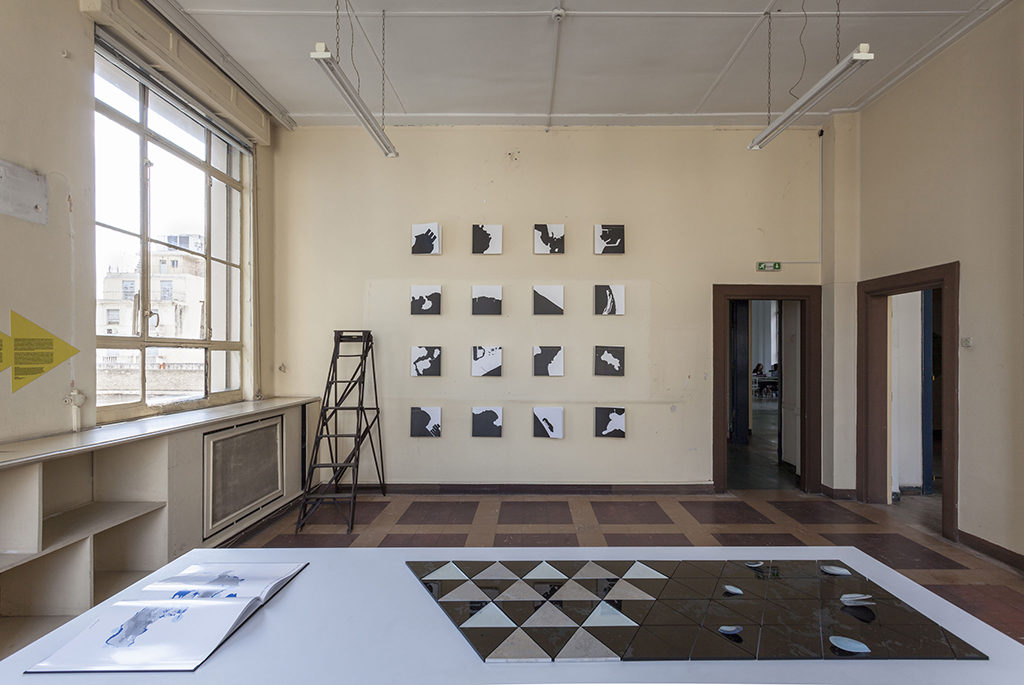
Coastal Domains is an on-going research project exploring the future landscaping of coastal territories in the Northeastern Mediterranea facilitated by Demetra Katsota along with 4th and 5th year students at the Department of Architecture, University of Patras. The installation Coastal Domains was made up of sixteen books, acting as case studies, secured on the wall and a ladder to reach them, encouraging brave visitors to climb and read them – a curatorial decision simultaneously inspiring participation and learning as it is explicitly reminiscent of old archival libraries. The 7th book in the series of sixteen engaged with the coast land of Kanoni and its Sea Lane on the island of Corfu, the research undertaken by Stella Andronikou and Iasonas Giannopoulos. As with each book in the series, the research was made up historically archived material, such as cartographical maps from different centuries and topographical material including the arrangement of roads and different fauna on the island thus unveiling issues of coastal development, the implications of an upsurge of tourism in the 1970s and possible environmental issues. Coastal Domains speculates and designs possible structures for the reinforcement of sustainability, devising various strategies that can protect the coasts of the Mediterranean Sea.
Tomorrows is particularly involved in engaging its locality of the Mediterranean, treating it as a microcosm for observing the implications of the future’s development. Silo(e)scapes by Zenovia Toloudi envisages a hybrid of a seed bank and museum for Mediterranea plant species as a tool inspiring a sharing economy. The installation of Silo(e)scapes required the audience to cradle themselves into the centre of the structure in order to experience the transparent silos-displays of the community LEGO labourers sharing their local seeds at the seedbanks. The audience suddenly find themselves in a possible future reality, all encompassing of agrarian sounds and 360 views of kaleidoscopic mirrors that trick perception of your depth of field. Almost theatrical, Silo(e)scapes is immersive and constructs a space where the audience is directly in conflict with the imminent shortage of supplies due to harmful environmental issues and increasing urban development. The audience becomes entirely physically encased in Silo(e)scapes, as a result inciting the plausibility of this future reality.
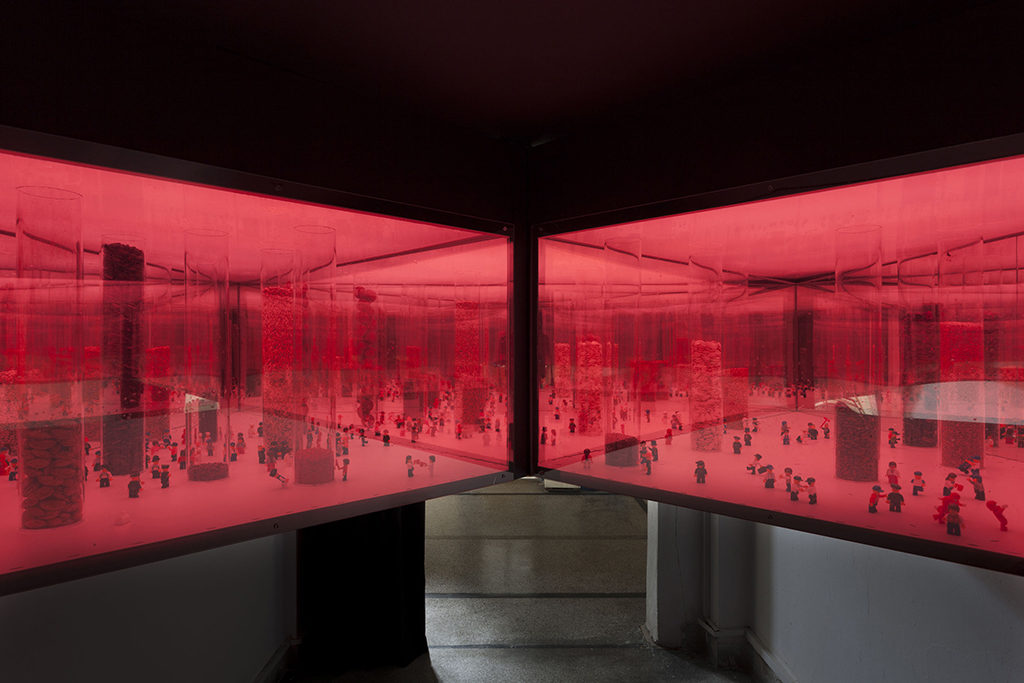
A Cave for an Unknown Traveler by Aristide Antonas introduces another form of habitable landscape for the possible future. The installation is structured like a ‘fake archaic cave’ that is buries inside it a structure as luxurious as a modern hotel room, invisible to the eye from the outside. The installed structure of the cave is complimented by a large sketchbook denoting the various features of the Cave for an Unknown Traveler. Antonas’ work brings to mind the concept of Plato’s Allegory of the Cave. The infrastructure and services within Antonas’ cave can be taken in context of the prisoner’s in Plato’s cave perceiving shadows as objects when in fact they are a mere representation of their physical form grasped by our mind. In this context, Antonas’ invisible cave begins to resemble an imagined safe haven for a traveling passer-by.

The highlight of Tomorrows is undoubtedly Liam Young’s commissioned work Tomorrow’s Storeys – a two-channel video installation isolated in a dark room with modular seating. The title of the work acts with a double meaning as in storeys of a building and the stories being told through them. The content, or stories, narrated in Tomorrow’s Storeys were first conceived in a workshop in mid-March as part of the programming to the run-up of the exhibition opening in mid-May. The workshop of visual artists, authors, photographers, directors and architects produced an abundance of local stories in the future city of Athens, particularly a future Athenian apartment block. In Tomorrows Storeys all apartments blocks have the ability to reorganise themselves automatically – modular entities like seating in the installation. The videos convey intricately detailed shots of the façade of these apartments as well as its contents recalling film shot by aerial drones and ads for IKEA products. The audience act as omnipresent eavesdroppers drifting from storey to storey into the conversations and local happenings in these apartment blocks. These apartment blocks of the future have found a way to reorganise themselves where Athenians are not given a minimum basic income but instead a minimum basic floor area – the occupants do not own an apartment but a specific volume of space which does not have a fixed location. Amongst these stories of shifting permanence and impermanence one stood out: that of an old grandmother dying and the family arguing about who takes over her volume of space as one character cries quite humorously “Can’t you wait until the funeral?!”. Tomorrows Storeys are part of a city where bots constantly reorganise your living in a form of urban computation according to best fit the needs of its citizens. In this way, a living space becomes a temporality, alluding the audience to question if their home is real if it always available for smooth transition to another space.
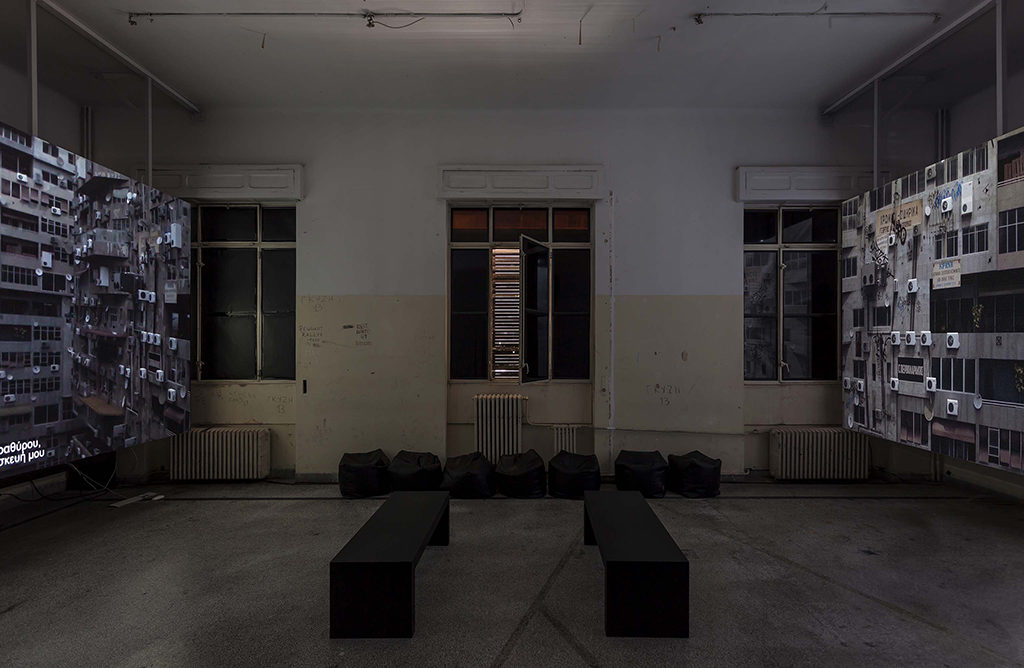
Within urban infrastructures are the human entities contained within them, as Young’s work emphasises, however some of these are becoming increasingly inhuman as the theme of ‘Beyond Anthropos’ suggests. The notion of inhuman or machinic entities being able to replicate human form and intelligence is common and highly popularised since the 1980s as films such as Bladerunner introduced global audiences to ‘replicas’. Today, AI is becoming so intelligent that it urges inventors such as SpaceX and Tesla CEO/founder Elon Musk to warn for correct precautions to be taken when engaging with AI, in fact comparing it to ‘summoning the demon’ and naming it ‘our biggest existential threat’ in the 2014 AeroAstro 1914-2014 Centennial Symposium by MIT. The work of !Mediengruppe Bitnik, coming only a couple of years after Musk’s interview, exemplify the relationship between human and machine. Ashley Madison Angels at Work in Athens is a research project initiated after the data of the Canadian online dating service was leaked in 2015. The leak revealed that Ashley Madison had created 75,000 female chatbots that catered to 32 million mostly male users, engaging them in costly internet intimacy. In Athens, there were 165 fembots for around 22,910 registered users. The installation was comprised of seven of these 165 fembots active in Athens, and were installed in a room dimmed by a fluorescent pink light with screens on tripods similar to average human height and alluding to a physical form. The fembots, programmed to be of different ages, utter pick-up lines they are allocated from a predetermined list to the 22,910 registered users who could not distinguish that they were talking to a machine and not a real person.

Tomorrows does not wish to present us a future as a prediction or as a form of critique of these technological, environmental and urban developments. Rather, it presents the future as an on-going participatory project, as a tool that can be utilised to examine who we are and where we are at in present tense, as well as where we could be potentially going. These urban fictions of our possible futures, are a speculative activity with the capability of making us more aware of the changes that have taken place whilst simultaneously illustrating the changes that are afoot. Tomorrows was a show that took place over six months ago, but its value to the discourse of the future will remain timeless for decades to come.
This is the third of three pieces on people who are posting work to the photography sharing site Flickr [1].
In this final article I look at the work of Karin Rudolph
. Rudolph is a Belgian photographer, currently living in Athens, where she works as a wedding and event photographer and raises two teenage sons. In addition to her work for pay she makes an ongoing series of ‘personal’ images which she regularly posts to the photo sharing site Flickr.
I ask her to send me some images from a wedding job and she does.
It is a job she is clearly good at—everything is beautifully shot, nicely framed, sharply in focus (when sharp focus might be thought necessary), but there is that extra something that comes with a good portrait photographer, which I can only describe as fellow feeling. A fellow feeling which elicits transparency and a willingness to risk vulnerability from the subject. I’ve never met Rudolph but it’s clear that her personality, her way of being, is a player here.
There’s also a sharp curiosity at work—a hunger for the way the world looks and with Rudolph this seems to become attached to particular objects, creatures (some human, some not) and roles. There was a dog at the wedding in the images she sent me. The wedding took place outdoors and the clearly much loved animal figures in a number of the shots. It’s as if at one point R becomes fascinated by it and we get shots where the all humans are cropped (in the shooting; she doesn’t crop after the fact) down to the waist and the dog becomes central (although a small child has a supporting role here too since he necessarily evades the crop/frame wholesale). We get a dog narrative. Then a bouquet catches her eye and we get a bouquet narrative, the wedding filtered through a non-human being or an object. Motion—a sense of the moment before and the moment after being necessary, if hidden, components of this still image—is a key underpinning of so many of these images, particularly in relation to these micro-narratives.


In a photographer less manifestly gripped by the facts of our fragile human being and ways in the world one might call some of her approaches formalist. It is certainly true that rhyme, echo, geometry, continuities and disruptions of line, shape and colour play a highly significant role in the structuring of her images but one of the driving forces of R’s work is that it constantly moves to dissolve any artificial divide between content and form. Yes, her eyes seek pattern; yes, this or that organising device might order an image but this never obscures our awareness of the facts, feelings and relationships portrayed or implicit there. Also—we humans are formalists, aren’t we? We’re pattern seekers. We play. Were you never fascinated as a child by mirrors, by the world turned upside down by hanging from your legs or by the cropping or heightening, or focus) achieved by looking through the cracks in your fingers? Of course you were. As we grow we perceive the whole world through a complex dialectic of what is presented to our senses on the one hand and our burgeoning sorting and structuring principles on the other. We are of necessity creatures of content and form together and one surmises that this is what makes us creatures of art too.
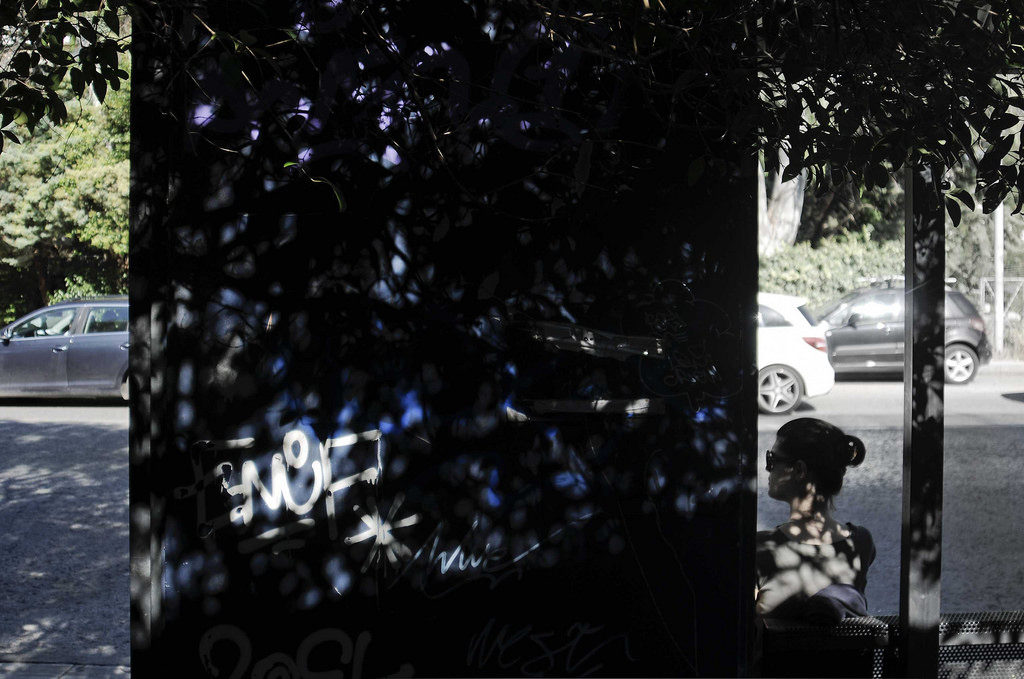
I’d been writing and thinking about this piece for a few months, on and off, and I’d got to a second or third draft when it hit me with a thud, a jolt, that hardly any of the recent images have titles.

The fact had just sailed under my radar, curiously, since I’ve argued and will again, that insofar as we can talk about meaning in a photo (or any visual artwork) this possibility lies in a network of references and comparisons which ineluctably involves talk, writing or both. Language. Further, that visual art is best seen as something humans do (emphasis on both words) than as the usual set of isolable ‘in and of themselves’ objects (which isolation is a fiction, at best an analytical convenience). And then it struck me ( I was being struck a lot that day) that there is something about these images that fights back against language—they’re often cross genre and resist categorisation and there’s a sense in which the easiest approach to what’s in them is simply to list it, and finally to say that this image had these things in it under this kind of light from that angle but, of course, this is far from satisfactory and at root there is something far transcending taxonomy or description going on. But –dammit! –I can’t help feeling it is as if the images (placed as they are in the sequence formed by Flickr) are calling out, hailing each other. I don’t know why, but forced rhubarb, a most unlikely image, is the one which springs to mind and persists, as if the absence of the immediately adjacent language of a title somehow forces the set of glorious but hitherto mute images to invent speech.
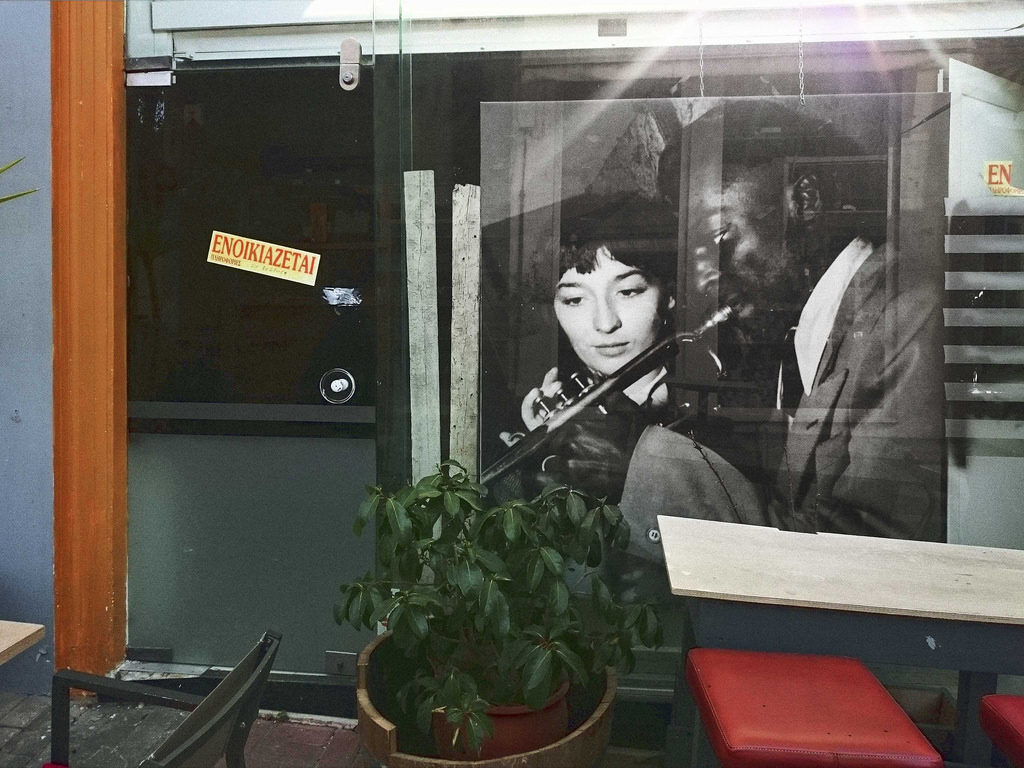
Anyone who has ever taken an un-posed image of a human being on a fast shutter speed will be cautious about ascribing emotions or characteristics to the subject on the basis of what is revealed. As in so many other ways, the very small, the very distant or unreachable, animal locomotion, the photograph reveals things beyond our normal ability to see or grasp them. One of these things is the curious plasticity of the human expression and how in our interactions we read this in sequence, in time, together with a host of other clues, aural and visual, to make sense of what is going on, to try to understand both what a person is doing and to surmise what they might be feeling . (Of course the opposite of this, the posed image, brings its own problems too.)

When we think hard and soberly we cannot but be convinced that the photograph alone, an impossibly small fragment of time, does not allow us enough evidence, that it is somehow unanchored in the world.
And yet, the desire to draw conclusions, to make comment, is certainly strong in us and each photographic image of a person, especially the striking and affecting ones, comes with a very strong sense that we are able to do so.
What can we actually say about the still photographic portrait, both in general and in particular cases?
One thing we might say is that the single image’s apparently complete account of a human being, based upon a fleeting expression (and perhaps the fleeting expressions in response of others and maybe also the presence of contextualising objects or other clues) suggests at best, a class of possibilities. This single image evokes a range of other possible images and moments in the world at least one of which must correspond to our strong intuitions about it. So even if we were able to establish the facts of the matter in this particular case and it made a lie of our emotional response , nevertheless that response represents a truth and somewhere, perhaps quite often, in the world, situations occur, have occurred, will occur, which correspond to this truth.
And it seems to me that it is this instinct for general human truth, allied to the particularity of light, line, composition, of other things depicted, which manifests in the eye-and-heart-catching-ness of the resulting final image.

A strong way of putting it would be that any portrait is just as much a work of fiction as a novel but that as we would not wish to deny something called ‘truth’ in the novel ( you might—I see no point to the thing otherwise) in the portrait we work our way back to truth.
And at least for me it is the photographer’s—and here, now ‘the photographer’s’ means R’s—capacity for empathy, for narrative, for understanding of the world and the wonder and the oddness of its inhabitants that makes her such a good portraitist (and let’s not forget, too, simply having done the thing a lot —this is often underrated nowadays.)
Do I know whether the Orthodox priest at the wedding table was a kind man? No. I don’t. I cannot. Is kindness manifest in the photo, is the possibility of kindness in the world reasonably asserted in it? Do I know more about kindness thereby? Absolutely.

There’s a black and white image, taken, I think, at the place where her teenage sons practice their footballing skills which feels like a short story or perhaps a collection of short stories, each cued by the various human presences which form at one and the same time a large (in how they capture our attention) and a small (in how much actual area of the image they occupy) part of the entire image.
It also has a most clearly defined geometry—three strips, the topmost being the practice field itself, the middle appearing to be a road like depression running between the photographer and this field and the lowest a pavement of some sort on the other side of that ‘road’. The almost bizarrely long evening shadows of R and a companion (and the horizontal distance between shadows is nicely ambiguous on the exact relationship between those shadowed) stretch forward into the image. The vertical grid adjacent to them, with a gap in the centre picked out in shadow too, suggests they are standing at a pedestrian gate to the place. I imagine the figure at the viewer’s right is R as the arms appear to be raised in a photo taking action.
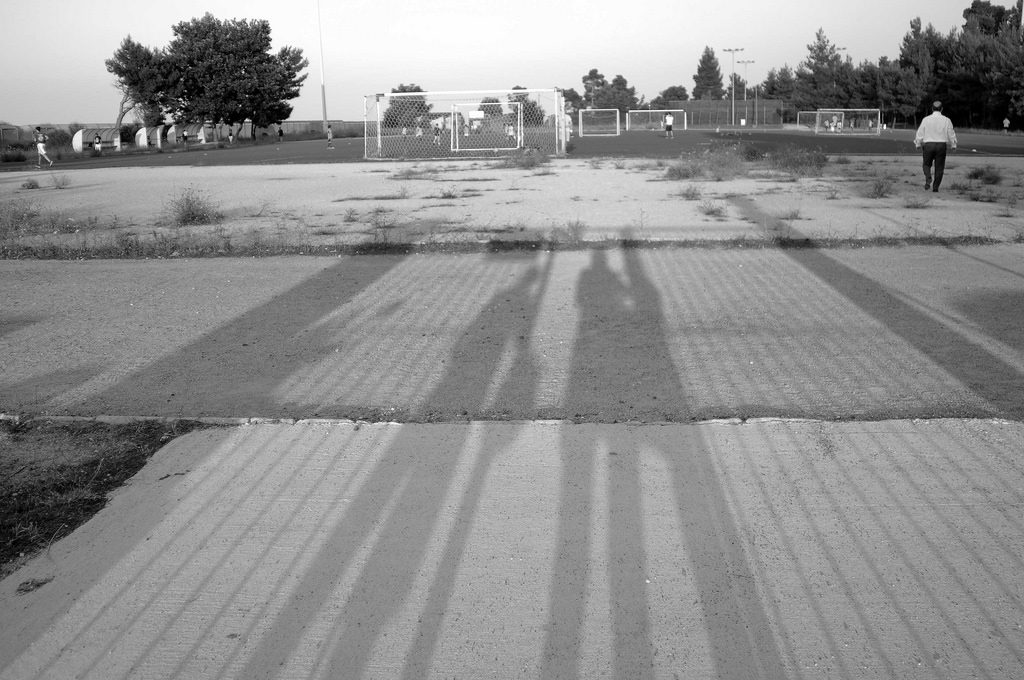
(The image thumbs its nose at genre—it is oblique self-portrait, landscape, social history, portrait and exploration of geometry and structure all at the same time.)
Shadows aside, the figures which catch my eye (what about you, so much to choose from or are you constrained in a similar way to me by something in the way the image is structured?) are the short stocky man in motion, walking away from us at the image’s far right top strip foreground. There’s a delicious swagger and confident openness about him.
Has he passed through the gate where R stands? Did he greet her?
The second key (perhaps because nearest?) figure is the young man, top strip, viewer’s far left, again in movement, this time almost certainly certainly sports related. Is he pursuing a stray ball? Running to greet a friend? Engaged in some sort of running warm up/exercise? As we strain to see, our relationship to the image’s scale shifts and we begin to realise just how many other figures he opens up to us—there are at least six either standing or seated in those little sheds at the field’s side between him and the left edge of the nearest goal net—each an enigma of a small but definite kind—and when we move rightwards from them we realise (and we have to move closer in, look differently, at the image to see this) just how many people there are in some sort of action here. As we move out again we are stuck by the contrast between the contemplative calm of the giant shadows and the anthill busyness of the young men. And here’s another thing. This is such a male photo. (With the exception of the photographer and I think it’s only because I know she is female that I read her as such. Then even as I write this I notice the slight head-cocked-to-one-side quality of aficionado-like attention in the head of the left shadow—and why do I think that might clue maleness? What does that say about me?) Oh! Layers and layers of fact, of presence, of things to enumerate and puzzle over. So much! And this before we take the thing as a totality—geometry, inhabitants, shadows, activity, motivation, time of day, distant trees, weeds and barren ground, a sky whose colour we can only guess from the fact we know there is evening sun. And that totality is the hardest thing to compass in any way other than an intake of breath or shiver down the spine. Enumerating the contents helps (although it’s not essential to the immediate affective apprehension of the whole—that just happens) but it’s the inexplicable (not a value judgement—literally inexplicable—simply, ‘This is what R did’) decision to frame those contents in that way—the bit of the process which defies words—that makes this and so many other pieces by her so powerful.
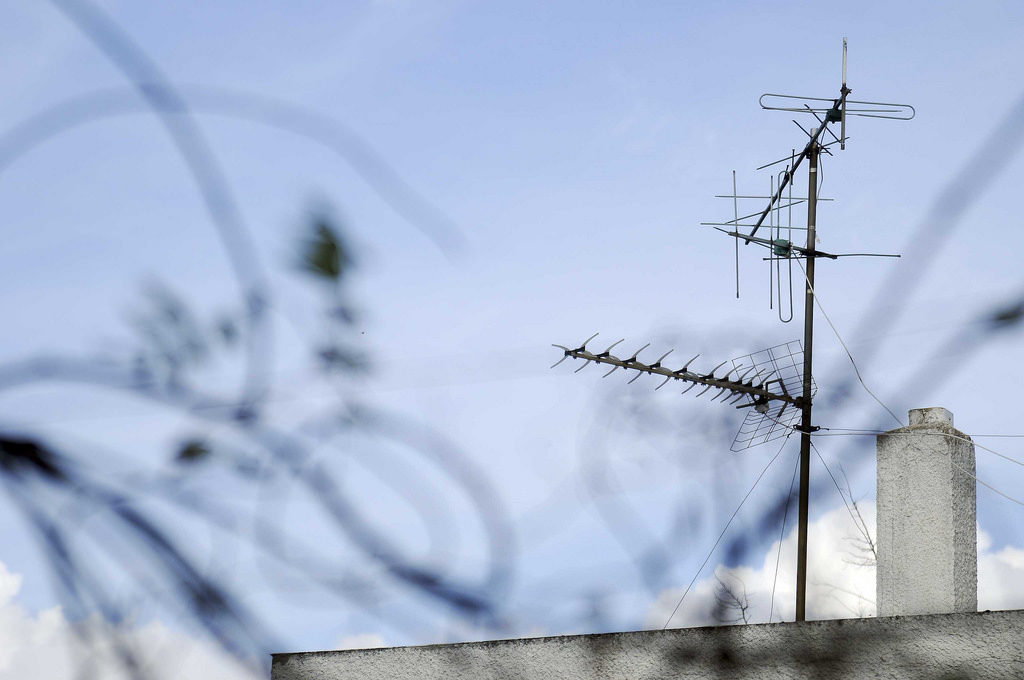
5.
A ravenous eye.
She has a ravenous eye, constantly tracking the scene in front of her and hungry for detail. This hunger does not distinguish between content and form. Whatever is human, whatever stirs affect or curiosity—whether pattern, rhyme or echo, or ethics, or suggested human warmth or frailty, this is swallowed up and processed by heart and mind in turn
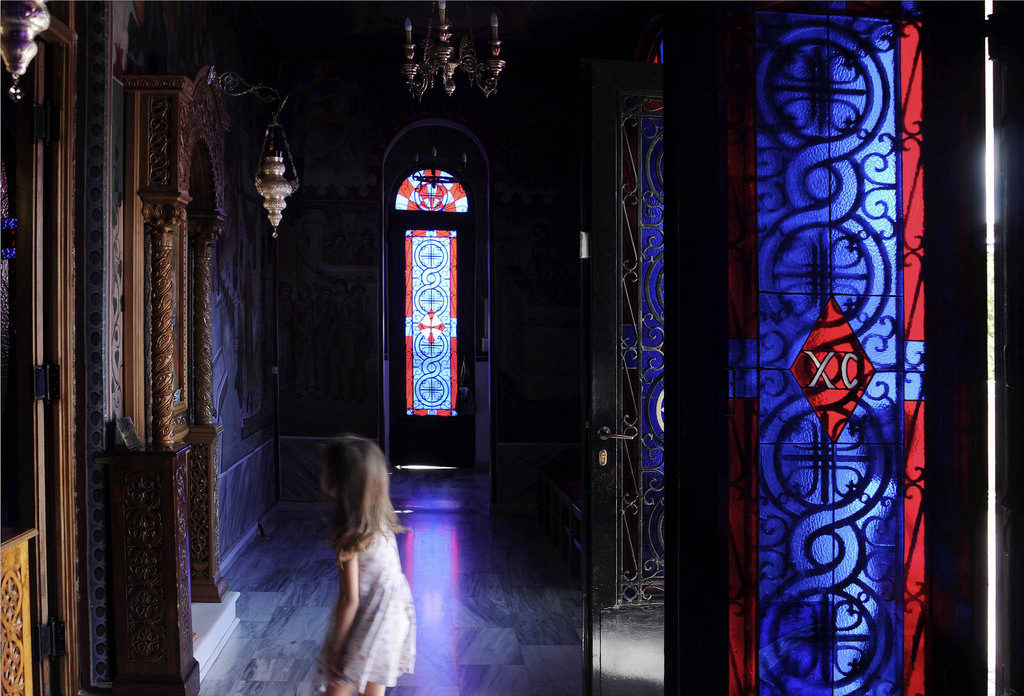
The resulting images bear the strong feel of certain, almost objective, structuring principles—that following of object or creature within a scene, the use of rhyme and echo. Two further categories are geometry and colour (and nothing here is pure, there are no essences, sometimes blocks of colour impose an extra, parallel geometry upon a scene whose first order sense—whether it be human beings in action or traces of interpretable human activity; buildings, signs, the street —apparently lies elsewhere.) The key thing about all these structuring principles is that they are found, excavated, discovered, seen—not made. They happen in parallel with, arise out of the actions and feelings of, human beings in this world, the only one we have.
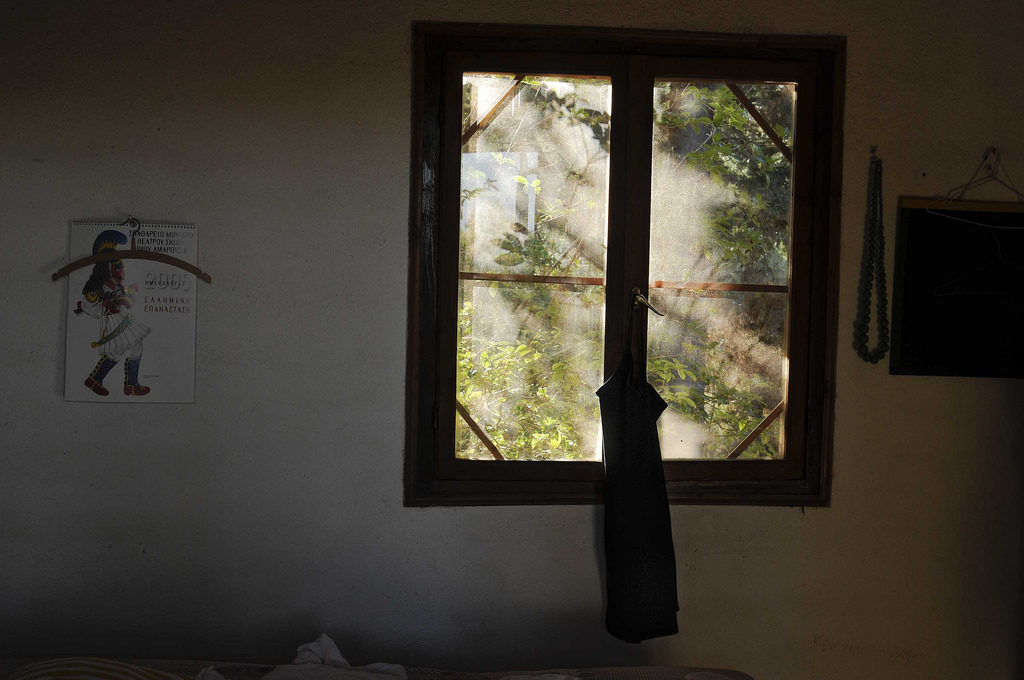
Because she is someone who has lived, fully, in that world, for a fair time, because her hunger extends beyond the visual (she always has a book on the go and the range of these is impressive), because she has a number of languages and is at home in at least three cultures, she makes images which are connected and re-connected by hundreds of threads to things we ourselves might have read and thought or experienced and talked about. Further, it is impossible to imagine that the fact she is a woman living in a country not of her birth, where she has learned a different script, different ways of talking and being, where she works in part as an image maker for hire and constantly both connects and holds separate that work for pay from own ‘own’ work, at the same time as raising children by herself, that these facts are not also somehow foundational.
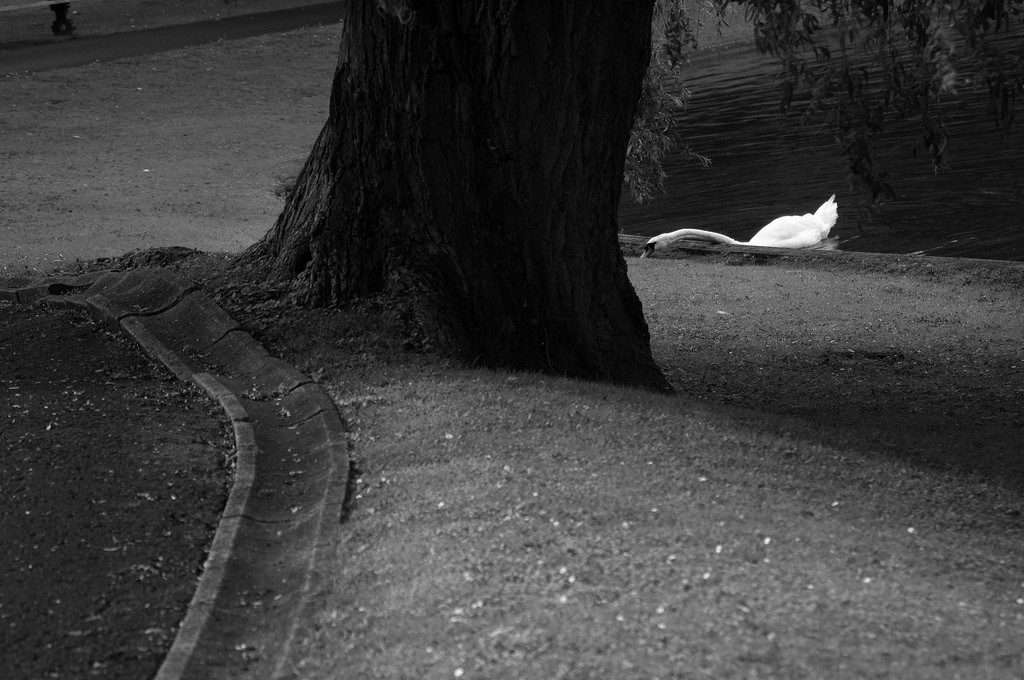
For a long time I have struggled with how to attach the word meaning to image. It is too easily and glibly used. An image never ‘means’ a single thing (unless it is the poorest of images and even then the human capacity for/delight in ambiguity sets to work to disrupt this) What is evident in Rudolph’s work is networks of evoked meaning, memories, feelings.

Her way of being in the world, this following her eye and nose, means that there is a kind of metonymy purged of any attempt at system—here is a dog or child or chair or window. Here are the things which necessarily were near it at a moment in time and this is how they were disposed. There was reason and there was randomness. Parts of the disposition were beautiful. (What do I mean by beautiful? They move me, they fill me with a joy that cannot be reduced to words though it perhaps can be limned by various combinations of words, combinations potentially infinite which always nearly but not completely fail.) Parts of the disposition were stark or threatening or at least worrisome. The bringing together of all these parts—worry, beauty, pattern, action—into an image framed, bounded, lit, by the laws of the heart and the laws of the intellect now pulling one way, now the other. The work about the world is itself part of the world. We are not alone. No person is an island. We can read each other’s thoughts. We can feel each other’s feelings.
The words and the image and human heart and human history dance ever outwards and outwards. What does an artist do but always start to write the whole history of humanity in the world?
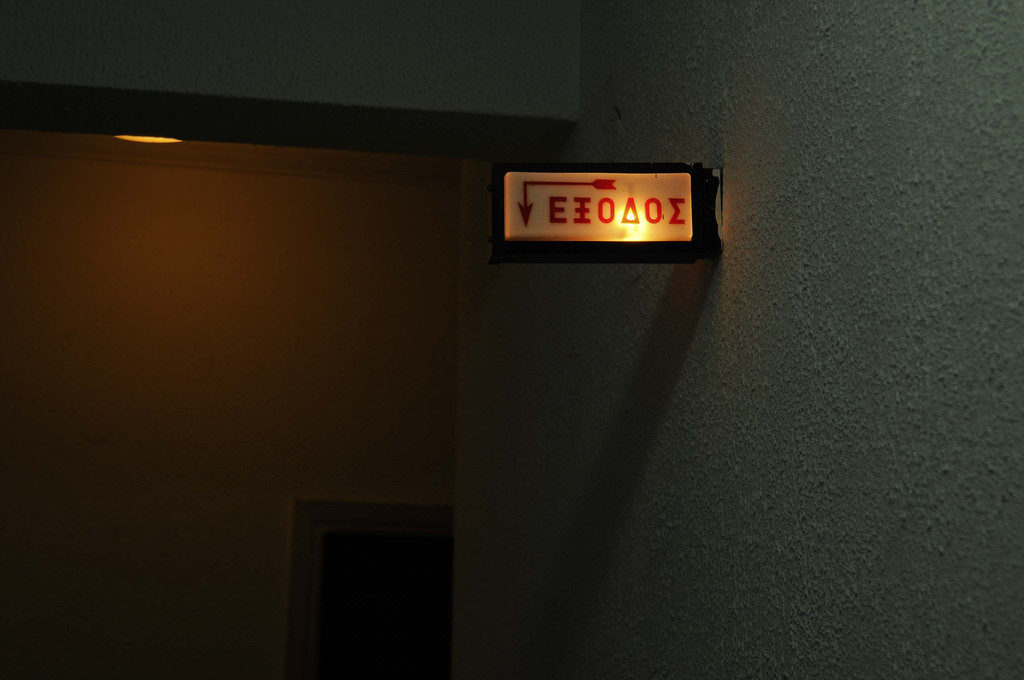
This series brings together artists, musicians, technologists, engineers, and theorists to join forces in the interrogation and production of new blockchain technologies.
Our focus will be to understand how blockchains might be used to enable a critical, sustainable and empowered culture, that transcends the emerging hazards and limitations of pure market speculation of cryptoeconomics.
Intended as a temporary laboratory for the creation of a living laboratory, the inaugural workshop in the series takes a pragmatic approach towards building technical and economic capacity in the arts.
As the DAOWO series unfolds, each lab will work across a spectrum of themes and domains of expertise, breaking down silos and assumptions about what blockchain technologies might mean. The aim is to birth a new set of experimental initiatives which can reinvent the future of the arts as we know it.
Thu 26 Oct: Reinventing the Art Lab (on the blockchain)
Venue: Goethe-Institut, London | BOOKING ESSENTIAL
2-5.30pm Workshop devised and hosted by Ruth Catlow and Ben Vickers
7-8.30pm Panel discussion with Hito Steyerl, Helen Kaplinsky, Julian Oliver
The Subsequent DAOWO Programme of Labs and Debates
Thu 23 Nov: Identity Trouble (on the blockchain)
Thu 25 Jan 2018: Doing Good (on the blockchain)
Fri 16 Feb 2018: Artists Organise (on the blockchain) (special event with Clubture at Drugo More, Rijeka)
Thu 22 Feb 2018: The Decentralised Music Society reforming music (on the blockchain)
Thu 29 Mar 2018: What Will It Be Like When We Buy An Island (on the blockchain)?
This programme is devised by Ruth Catlow and Ben Vickers in collaboration with the Goethe-Institut London, and the State Machines programme. Its title is inspired by a paper by artist hacker and writer Rhea Myers called DAOWO – Decentralised Autonomous Organisation With Others.
Events will be hosted at the Goethe-Institut, London and Drugo More, Rijeka.
About Ruth Catlow
Ruth Catlow is an artist, writer and curator working with emancipatory network cultures, practices and poetics. She is the co-founder, co-director of Furtherfield.
About Ben Vickers
Ben Vickers is a curator, writer, explorer, technologist and luddite. He is CTO at the Serpentine Galleries in London and an initiator of the open-source monastic order unMonastery.
This project has been funded with the support from the European Commission. This communication reflects the views only of the author, and the Commission cannot be held responsible for any use which may be made of the information contained therein.
This short (20 minute) film has been made by artist Michael Szpakowski working with two classes of year 4 pupils at Southwark Park school in Bermondsey.
Freely adapted from King Hrolf Kraki’s Saga it is a grim tale of internecine bloodletting in Viking times told in the childrens’ own words and acted out by them.
“Of all the pieces of “outreach” – I’d rather call it co-constructed – work I’ve done over the last thirty years, this piece comes closest to satisfying both the most important requirements of such work. The young people are totally engaged in the process and proud of the final product. Also and more importantly, I feel that it is aesthetically satisfying as any work I make entirely alone; so the finished piece is both a universal fable which tips its hat in homage to Brecht, Bresson and Straub-Huillet and also a hymn to the energy, wit and resourcefulness of the eight to nine year old and to an inner London multicultural school community at its best.”
Public screening at BFI- NFT2 4pm Thursday 25th June 2011
http://www.bfi.org.uk/
Seats are limited. Please contact ale[AT]furtherfield[DOT]org
A Furtherfield Outreach Project
Partners: Creative Partnerships, A New Direction, Southwark Park Primary School
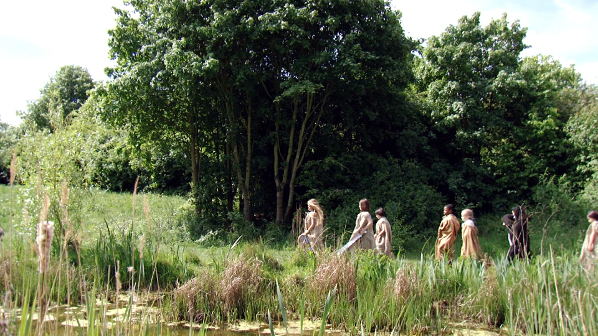
DOWNLOAD PRESS RELEASE
FREE DOWNLOAD OF EXHIBITION DOCUMENTATION
SEE IMAGES FROM THE PRIVATE VIEW
Featuring Katriona Beales and Fiona MacDonald.
The exhibition and research project Are We All Addicts Now? explores the seductive and addictive qualities of the digital.
Artist Katriona Beales’ work addresses the sensual and tactile conditions of her life lived online: the saturated colour and meditative allure of glowing screens, the addictive potential of infinite scroll and notification streams. Her new body of work for AWAAN re-imagines the private spaces in which we play out our digital existence. The exhibition includes glass sculptures containing embedded screens, moving image works and digitally printed textiles. Beales’ work is complemented by a new sound-art work by artist and curator Fiona MacDonald : Feral Practice.
Beales celebrates the sensuality and appeal of online spaces, but criticises how our interactions get channeled through platforms designed to be addictive – how corporations use various ‘gamification’ and ‘neuro-marketing’ techniques to keep the ‘user’ on-device, to drive endless circulation, and monetise our every click. She suggests that in succumbing to online behavioural norms we emerge as ‘perfect capitalist subjects’.
For Furtherfield, Beales has constructed a sunken ‘bed’ into which visitors are invited to climb, where a glowing glass orb flutters with virtual moths repeatedly bashing the edges of an embedded screen. A video installation, reminiscent of a fruit machine, displays a drum of hypnotically spinning images whose rotation is triggered by the movement of gallery visitors. Beales recreates the peculiar, sometimes disquieting, image clashes experienced during her insomniac journeys through endless online picture streams – beauty products lining up with death; naked cats with armed police.

Glass-topped tables support the amorphous curves of heavy glass sculptures, which refract the multi-coloured light of tiny screens hidden inside. Visualisations of eye-tracking data (harvested live from gallery visitors) scatter across the ceiling. On the exterior wall of the gallery, an LED scrolling sign displays text Beales’ has compiled, based on comments from online forums about internet addiction.
Where Beales addresses the near-inescapability of machine-driven connection, Feral Practice draws us into the networks in nature. Mycorrhizal Meditation is a sound-art work for free download, accessed via posters in Furtherfield Gallery and across Finsbury Park. MM takes the form of a guided meditation, journeying through the human body and down into the ‘underworld’ of living soil, with its mycorrhizal network formed of plant roots and fungal threads. It combines spoken word and sound recordings of movement and rhythm made in wooded places. Feral Practice complicates the idea of nature as ‘ultimate digital detox’, and alerts us to the startling interconnectivity of beyond-human nature, the ‘wood-wide-web’ that pre-dates our digital connectivity by millennia. (Download Mycorrhizal Mediation here)
Are We All Addicts Now? has been developed in collaboration with artist-curator Fiona MacDonald : Feral Practice, clinical psychiatrist Dr Henrietta Bowden-Jones, and curator Vanessa Bartlett.
Glowing light of screens makes us #addictsnow – they are the mini-suns we bask in to keep away the dark https://t.co/jedrDUE2ZWpic.twitter.com/BmTTbFckFp
— furtherfield (@furtherfield) July 27, 2017
View more of the comissioned gifs and tweets here
In the run up to the exhibition, artists Charlotte Webb and Connor Rigby have been commissioned to produce a series of gifs and tweets to stimulate debate around the designed-for-addiction nature of digital devices, and the ethics and politics that surround this. Join the conversation @furtherfield on Twitter and Instagram using the hashtag #addictsnow
Accompanying the exhibition, a book designed by Stefan Schafer and edited by Vanessa Bartlett and Henrietta Bowden-Jones, brings together Beales’ and MacDonald’s artwork and writing with essays from contributors in the fields of anthropology, digital culture, psychology and philosophy. This book is the first interdisciplinary study of the emerging field of internet addiction. Contributors will discuss their essays at a symposium convened by Vanessa Bartlett at Central Saint Martins in November 2017. Advanced copies of the book are on sale at the Liverpool University Press website https://liverpooluniversitypress.co.uk/products/100809
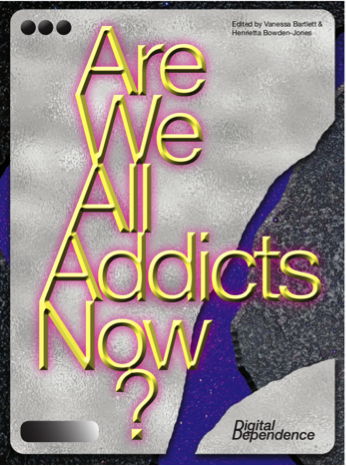
Beales’ work ‘Entering the Machine Zone’ has been co-commissioned with Science Gallery London. An iteration of the work will be presented as part of HOOKED, the opening season of the new Science Gallery London, curated by Hannah Redler.
Exhibition Tour of Are We All Addicts Now? with Ruth Catlow and Katriona Beales
Saturday 16th September 2017, 2-4 pm
Furtherfield Gallery
Join Furtherfield co-director Ruth Catlow and artist Katriona Beales to find out more about the works featured in the exhibition Are We All Addicts Now? and to discuss the issues that it raises around digital addiction and online behaviour.FREE | booking essential
Late Night Opening & Film Screening
Friday 29th September 2017, 5 – 8.30pm
Furtherfield Gallery & Commons
A late night opening of the Are We All Addicts Now? exhibition, followed by a screening of artists’ moving image work that has informed the development of the exhibition.
Gallery Open: 5 – 7pm
Screening: 7 – 8.30pm
FREE | booking essential
Mycorrhizal Event with Fiona MacDonald : Feral Practice
Saturday 21st October 2017, 2 – 4pm
Furtherfield Commons
Fiona MacDonald: Feral Practice presents a lecture, a performance, and a fungi walk. Informed by the history, art and science of human-fungal relations, these experiences explore themes of reciprocity, intuitive and nonverbal interconnection between people, psychedelic consciousness, fungal songs, shamanic journeying, and plant communication.
FREE | booking essential
Visual Matrix Workshop with Vanessa Bartlett
Thursday 2nd November, 4 – 6.30pm
Furtherfield Commons
Join curator Vanessa Bartlett for a research workshop responding to works in the Are We All Addicts Now? exhibition. The visual matrix is a new psychosocial research technique that we are using to generate audience response to this project. Content generated during this session will inform our evaluation of the exhibition.
For more information and to book your place contact info [at] vanessabartlett.com
FREE | email v.bartlett [at] unsw.edu.au to book your place.
Are We All Addicts Now? Symposium and Book Launch at CSM
Tuesday 7th November, 6.30-9pm
Central Saint Martins, University of the Arts London, 1 Granary Square, London, N1C 4AA
This event celebrates the publication of Are We All Addicts Now? Digital Dependence edited by Vanessa Bartlett and Henrietta Bowden-Jones and will feature presentations from many of the book’s key contributors who include:
During the symposium, psychologists, philosophers and artists come together to discuss the emerging diagnosis of internet addiction. Taking into account our precarious economic and political climate, they will ask whether internet addiction should be understood as a form of illness, or simply a sensible adaptation to our current environment? As increasing numbers of people struggle to moderate their online behaviours, this event will also explore artists’ strategies for counteracting the seductive, addiction-making qualities of digital space.
Convened by curator Vanessa Bartlett
Presented in partnership with Central Saint Martins Art/Design and Science Research Group
The book, ‘Are We All Addicts Now?’ is available from Liverpool University Press: liverpooluniversitypress.co.uk/products/100809
See photos from the Symposium and Book Launch
See a recording of the Symposium and Book Launch – Part 1 | Part 2
£4 – £7 | booking essential
Katriona Beales is an artist who makes digital artefacts, moving image and installation, stressing the physicality of digital life. Are We All Addicts Now? develops Beales’ 2015 work ‘White Matter’ (a FACT commission for ‘Group Therapy: Mental Distress in a Digital Age’) which is showing at the University of New South Wales, Sydney as part of Anxiety Festival (Sept 2017). Beales’ received an MA from Chelsea College of Arts and has an artist profile on Rhizome.org
www.katrionabeales.com
Fiona MacDonald is an artist, curator and writer specializing in human-nonhuman relationship. As Feral Practice, she works in co-production with a collective of human and nonhuman persons. Current projects include Foxing, (see PEER London, 2017) Ant-ic Actions (see Ethical Entanglements, Bloomsbury Press, forthcoming) Homo Mycelium, and Wood to World (London, Kent, Aberdeen 2015-17).
www.feralpractice.com
Vanessa Bartlett is a researcher and curator based between Australia and the UK. She studies and teaches at UNSW Art & Design, Sydney where her research investigates connections between digital technologies and mental health through reflective curatorial practice. Her recent exhibition Group Therapy: Mental Distress in a Digital Age showed at FACT (Foundation for Art and Creative Technology), UK in 2015 and opens at UNSW Galleries Sydney in September 2017.
www.vanessabartlett.com
Dr. Charlotte Webb is an artist and deviant academic. She speaks and exhibits internationally, focusing on the web as a medium for creative practice, critical thinking and collective action.
Furtherfield is an internationally renowned arts organisation specialising in labs, exhibitions and debate for increased, diverse participation with emerging technologies. At Furtherfield Gallery and Furtherfield Lab in London’s Finsbury Park, we engage more people with digital creativity, reaching across barriers through unique collaborations with international networks of artists, researchers and partners. Through art Furtherfield seeks new imaginative responses as digital culture changes the world and the way we live.
“There is no other gallery like Furtherfield. Situated in the middle of Finsbury Park they attract people from all walks of life and focus on contemporary technology and how it affects the lives of people and the world we live in.” (Liliane Lijn, artist)
Furtherfield Gallery
McKenzie Pavilion
Finsbury Park, London, N4 2NQ
Visiting Information
Thanks to:
The Wellcome Trust
Arts Council England
Science Gallery London
Central Saint Martins
BF Skinner Foundation
Haringey Council
Bruce Marks (glass artist)
Rob Prouse (raspberry Pi and AV technician)
Part of the Are We All Addicts Now? exhibition at Furtherfield Gallery.
DOWNLOAD PRESS RELEASE
SEE IMAGES FROM THE SYMPOSIUM AND BOOK LAUNCH
SEE A RECORDING OF THE SYMPOSIUM AND BOOK LAUNCH – PART 1 | PART 2
This event celebrates the publication of Are We All Addicts Now? Digital Dependence edited by Vanessa Bartlett and Henrietta Bowden-Jones and will feature presentations from many of the book’s key contributors who include:
During the symposium, psychologists, philosophers and artists come together to discuss the emerging diagnosis of internet addiction. Taking into account our precarious economic and political climate, they will ask whether internet addiction should be understood as a form of illness, or simply a sensible adaptation to our current environment? As increasing numbers of people struggle to moderate their online behaviours, this event will also explore artists’ strategies for counteracting the seductive, addiction-making qualities of digital space.
Ticket price includes a drink *:
£7 full price | £4 concessions (UAL staff/student, external student unemployed, senior)
*ticket price covers a token for 1 alcoholic drink or 2 soft drinks, with a pay bar available for additional purchases.
BOOKING ESSENTIAL
The publication will be available to purchase on the night at the discounted price of £10 (cash only, RRP £14.95). The book, ‘Are We All Addicts Now?’ is also available from Liverpool University Press: liverpooluniversitypress.co.uk/products/100809
Convened by curator Vanessa Bartlett
Presented in partnership with Central Saint Martins Art/Design and Science Research Group
14.00-17.30 – Workshop devised and hosted by Ruth Catlow and Ben Vickers
19.00-20.30 – Panel discussion with Hito Steyerl, Helen Kaplinsky and Julian Oliver
Workshop participants who wish to also stay for the panel event should book for both events individually
Does Art need its own blockchain? Can blockchain technologies help create and retain value for artists and arts organisations? If blockchains are transforming all other industries and supply chains, how will it effect the arts? Is this technology at a stage now where we can begin applying it to our everyday processes and practices?
These are just a few of the questions we have been asking ourselves and others over the course of the last year. In the scheduling and convening of this workshop series we invite others to join us as we delve deeper into the pragmatics of applying these questions to specific scenarios.
Designed as a temporary laboratory for the creation of a living laboratory, the inaugural workshop in the series will take a pragmatic approach in mapping out technical and economic capacity for the application of blockchain technologies within the arts.
This workshop will open with an overview of current developments for blockchain application within the arts ecosystem, outlining the key opportunities and challenges. Serving as the background, this will lead into a series of short presentations by practitioners who have invested their time over the past years unpicking the treacherous complexity of the blockchain. Each of these areas will then be built upon through facilitated working groups – with the explicit objective of enabling initiatives to move into a new phase of development.
As the workshop series unfolds, each lab will work across a spectrum of themes and domains of expertise, breaking down silos and assumptions about what blockchain technologies might mean. The aim is to birth a new set of experimental initiatives with each lab, which can contribute towards rethinking and reinventing the future of the arts as we currently know it.
“If art is an alternative currency, its circulation also outlines an operational infrastructure. Could these structures be repossessed to work differently?” – Hito Steyerl
Following the inaugural workshop of the DAOWO series, this panel will seek to establish a public platform for the discussion of opportunities, dangers and complexity inherent in the very idea of applying blockchain technologies to the production and circulation of art.
Exploring both hands on practical applications and the theoretical long term impact of a technology that enables a vast array of unexpected new conditions, under which the artworld and art market may be forced to operate. From fractional ownership, strict provenance models, untraceable financial transactions, autonomous artworks to new fully automated organisational forms – this panel will seek to unravel and interrogate both the banality and the terror of blockchains future impact on the arts.
Hito Steyerl’s films, installations and writings come out of a systemic way of thinking and working, in which artistic production and the theoretical analysis of global social issues are closely linked. Steyerl investigates the interaction and synthesis of technological and artistic imagery, for example, at the level of visual mass culture – and its function within the overall dispositif of technocracy, monetary policy, the abuse of power, and violence.
Helen Kaplinsky is a curator and writer based at Res., a collaboratively programmed gallery and workspace in Deptford, South East London, currently working in partnership with nearby University of Goldsmiths. Specialising in collection and archive based projects, the thematics and strategies of her curatorial projects consider property in the age of digital sharing. She has contributed to programmes at Whitechapel Gallery, South London Gallery, Glasgow International Festival, ICA (London), The Photographers Gallery (London), and has ongoing programmes with Tate and FACT (Liverpool).
Julian Oliver is a Critical Engineer and artist based in Berlin. Julian has also given numerous workshops and master classes in software art, data forensics, creative hacking, computer networking, counter-surveillance, object-oriented programming for artists, augmented reality, virtual architecture, video-game development, information visualisation and UNIX/Linux worldwide. He is an advocate of Free and Open Source Software and is a supporter of, and contributor to, initiatives that reinforce rights of privacy and anonymity in networked and other technologically-mediated domains. He is the co-author of the Critical Engineering Manifesto and co-founder of Crypto Party in Berlin, who’s shared studio Weise7 hosted the first three crypto-parties worldwide. He is also the co-founder of BLACKLIST, a screening and panel series focused on the primary existential threats of our time.
The DAOWO programme is devised by Ruth Catlow (Furtherfield) and Ben Vickers (Serpentine Galleries & unMonastery) in collaboration with the Goethe-Institut London, and the State Machines programme.
This project has been funded with the support from the European Commission. This communication reflects the views only of the author, and the Commission cannot be held responsible for any use which may be made of the information contained therein.
Through our interactions with digital devices and systems us humans are now a diverse resource to other humans and machines. And we are changing in accordance with the processes and demands of contemporary, technological market systems, designed to extract as much data from us as possible. In his recent article Our minds can be hijacked, Paul Lewis of the Guardian revealed that those in the know, those who helped to create Google, Twitter and Facebook, are now disconnecting themselves from the Internet as, like millions of people in the world, they are feeling the effects of addiction to social networking platforms, and fear its wider consequences to society.
The hazards of this kind of tech-contagion have been the staple food of sci-fi for decades – a mysterious woman shares a strange but simple VR game in the 1991 episode of Next Generation Star Trek, The Game. It spreads like wildfire, taken up with enthusiasm by the crew, only later revealed to be a brainwashing tool invented by an alien captain to seize control of first the ship, and then all of Starfleet. Let’s look at ourselves for a moment – if we can tear our gaze away from our screens. How has our public behaviour changed – on the streets, on public transport, in buildings and parks? Our attention transfixed by our devices, online via our phones and tablets – bumping into each other, and even walking into the road endangering their own and others’ lives.
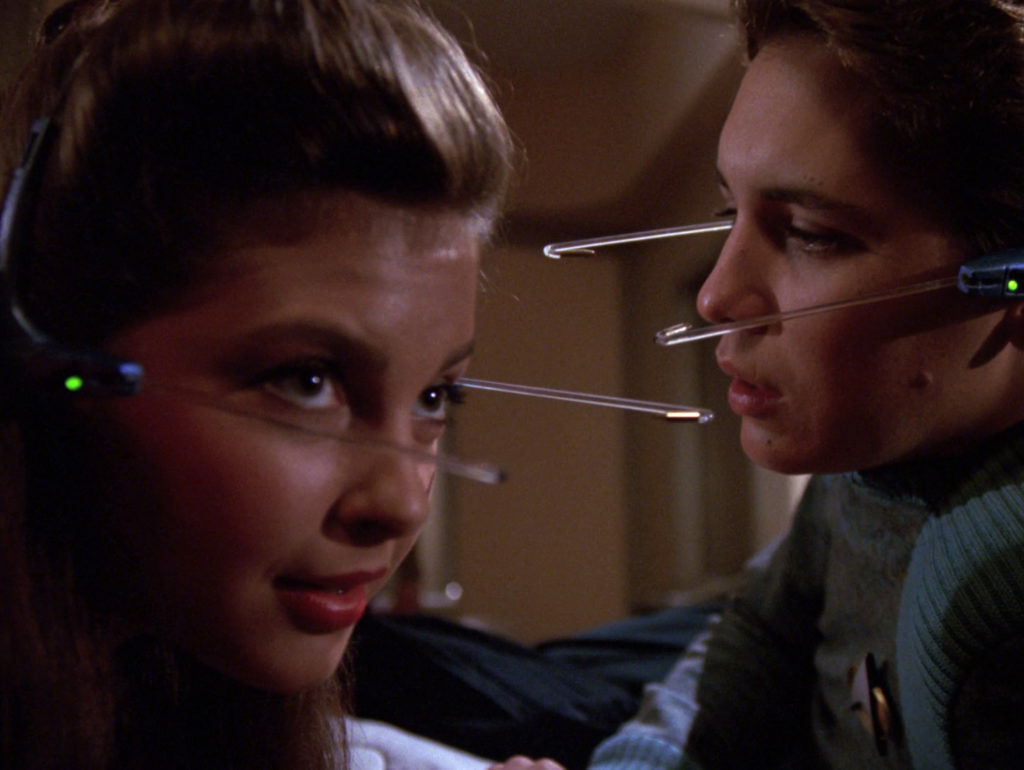
Professor of psychology Jean M. Twenge studies post-millennials and argues that a whole younger generation in the US, would rather stay in doors than going out and partying. Even though they are generally safer from material harm they are on the brink of a mass mental-health crisis. She says this dramatic shift in social behavior emerged at exactly the moment when the proportion of Americans who owned a smartphone surpassed 50 percent. Twenge has termed those born between 1995 and 2012, as generation iGen. With no memory of a time before the Internet, they grew up constantly using smartphones and having Instagram accounts. In her article Have Smartphones Destroyed a Generation? Twenge writes “Rates of teen depression and suicide have skyrocketed since 2011. It’s not an exaggeration to describe iGen as being on the brink of the worst mental-health crisis in decades. Much of this deterioration can be traced to their phones.”
Internet addiction is like having your head perpetually inside a magical mirror of hypnotically disembodying power #addictsnow pic.twitter.com/DFkl1jaKER
— furtherfield (@furtherfield) August 31, 2017
From the #addictsnow Twitter commission by Charlotte Webb and Conor Rigby, 2017
We offer three features as part of Furtherfield’s 2017 Autumn editorial theme of digital addiction, in parallel with the exhibition Are We All Addicts Now? at the Furtherfield Gallery, until 12th November 2017. Artist Katriona Beales has developed the exhibition and events programme in collaboration with artist-curator Fiona MacDonald: Feral Practice, clinical psychiatrist Dr Henrietta Bowden-Jones, and curator Vanessa Bartlett. She explores the seductive qualities, and the effects of our everyday digital experiences. Beales suggests that in succumbing to on-line behavioural norms we emerge as ‘perfect capitalist subjects’ informing new designs, driving endless circulation, and the monetisation of our every swipe, click and tap.
Firstly we present this interview with Katriona Beales* from the new book Digital Dependence (eds Vanessa Bartlett and Henrietta Bowden-Jones, 2017) in which she discusses her work and her research into the psychology of variable reward, “one of the most powerful tools that companies use to hook users… levels of dopamine surge when the brain is expecting a reward. Introducing variability multiplies the effect” and creates a frenzied hunting state of being.
Pioneer of networked performance art, Annie Abrahams, creates ‘situations’ on the Internet that “reveal messy and sloppy sides of human behaviour” in order to awaken us to the reality of our networked condition. In this interview, Abrahams reflects on the limits and potentials of art and human agency in the context of increased global automation.
Finally a delicious prose-poem-hex from artist and poet Francesca da Rimini (aka doll yoko, GashGirl, liquid_nation, Fury) who traces a timeline of network seduction, imaginative production and addictive spaces from early Muds and Moos.
“once upon a time . . .
or . . .
in the beginning . . .
the islands in the net were fewer, but people and platforms enough
for telepathy far-sight spooky entanglement
seduction of, and over, command line interfaces
it felt lawless
and moreish
“
And a final recommendation – The Glass Room, curated by Tactical Tech
Tactical Tech are in London until November 12 with The Glass Room, exhibition and events programme. A fake Apple Store at 69-71 Charing Cross Road, operates as a Trojan horse for radical art about the politics of data and offers an insight into the many ways in which we are seduced into surrendering our data. “At the Data Detox Bar, our trained Ingeniuses are on hand to reveal the intimate details of your current ‘data bloat’; who capitalises on it; and the simple steps to a lighter data count.”
*This interview is published with permission from the publishers of the book Digital Dependence edited by Vanessa Bartlett and Henrietta Bowden-Jones, available to purchase from the LUP website here.
The interview is taken from the recently published book Are We All Addicts Now? Digital Dependence edited by Vanessa Bartlett and Henrietta Bowden-Jones, Liverpool University Press, 2017, and published with permission from the publisher. Available from the LUP website here – the interview is published in parallel with the exhibition Are We All Addicts Now? at the Furtherfield Gallery, London 16 September – 12 November 2017.
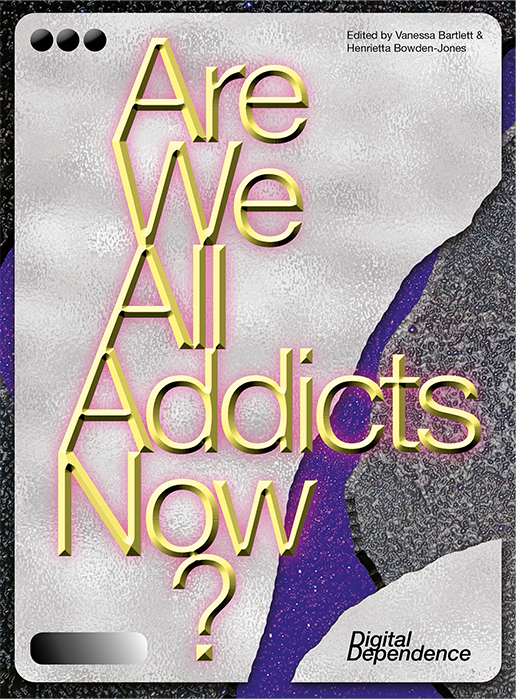
Ruth Catlow: In your exhibition Are We All Addicts Now? That opens at Furtherfield, Autumn 2017. You will be presenting a number of works and installations made in response to your research into online addictions. What prompted your interest in this matter?
Katriona Beales: I have insomnia on and off — like a lot of precarious workers. And to deal with being awake for long-stretches at night I go online, parse hundreds of hyperlinks, images, videos. It’s like an out of body experience: I detach, temporarily, from anxieties, pressure, claustrophobia via total preoccupation. Reflecting on these experiences caused me to question whether there was something inherently ‘addictive’ about the conditions of the digital. My research has developed to look at the burgeoning field of neuromarketing and how much online content is ‘designed for addiction’ (to borrow the title of Natasha Dow Schüll’s scorching analysis of machine gambling in Las Vegas). [
note]Natasha Dow Schüll, Addiction By Design: Machine Gambling in Las Vegas (Princeton: Princeton University Press, 2012).[/note] 1] Gamification strategies and various psychological techniques such as variable reward (originally employed in the casino) are now utilised to mass effect on social media platforms, search engines, email accounts, and news sites.
RC: Can you give us an example of digital content, an interface or a device that you personally experience as addictive?
KB: I find the infinite scroll function on sites like Instagram and Twitter very compulsive. It removes the natural breaks that are built into technologies like the book, with chapters starting and ending. Then again, I used to be a compulsive reader and now I am a compulsive scroller… But I keep circling back round to think about the specific qualities of the conditions of the digital. The infinite, hyperlinked and networked nature of online content means scrolling, scrolling, scrolling never needs to end. There is also a correlation between these repetitive physical actions and meditative type states.
RC: Yes, this connects with theories of flow employed in game design. The idea is to design activities that produce the fulfilling feelings of focus, and to minimise a questioning of the context or frame of play. And there is very little critical discussion in mainstream culture about the gamification of everything, which replaces individual agency with a kind of soft coercion. It’s problematic because the less we notice how our attention and experiences are being harnessed by external forces (commercial or state based), the harder it is to connect and collaborate with others outside the given frames.

KB: Totally. I like your phrase ‘soft coercion’ because I think that sums up nicely what I’ve found troubling. Take this quote from Nir Eyal: “Variable schedules of reward are one of the most powerful tools that companies use to hook users… levels of dopamine surge when the brain is expecting a reward. Introducing variability multiplies the effect, creating a frenzied hunting state… When Barbra lands on Pinterest, not only does she see the image she intended to find, but she’s also served a multitude of other glittering objects… Before she knows it, she’s spent 45 minutes scrolling.” [2]
RC: We initially had reservations about applying the concept of addiction to internet usage, partly because the addiction label is usually used to attach blame to individuals. However, after conversation it became clear that you are exploring a political question. Why is the concept of addiction important to you?
KB: Too much discussion about addiction is focused on the responsibility of people to help themselves. The fact that many can’t is often seen as a kind of moral failure. There’s also the disputed status of internet addiction in itself as documented by Mark D. Griffiths and his colleagues in their contribution to this book. We can’t pretend that there aren’t lots of people out there experiencing unhealthy and compulsive relationships to their technologies. But what kind of language is most appropriate to define this? What I am interested in is the phenomenon of what could be understood as addictive behaviours (including my own) being normalised in relation to digital devices. Kazys Varnelis [3] describes network culture as demanding connectedness, with power concentrated in nodes of hyper-connectivity. The more views, the more likes, the more power is accrued. Addictive behaviour is both normalised and valorised in late capitalism as it is associated with the public performance of productivity. Whilst these actions appear to be the choice of individuals, how much is due to the influence of mechanisms and systems of control? Ultimately, I am interested in the idea of the addict as a perfect capitalist subject. However, can we/I be both active-users and critical participants? I am concerned about how many of these platforms function as closed systems in which we contribute (without remuneration) our creative and emotional labour and yet can’t shape the conditions in which it is displayed, performed and monetised.
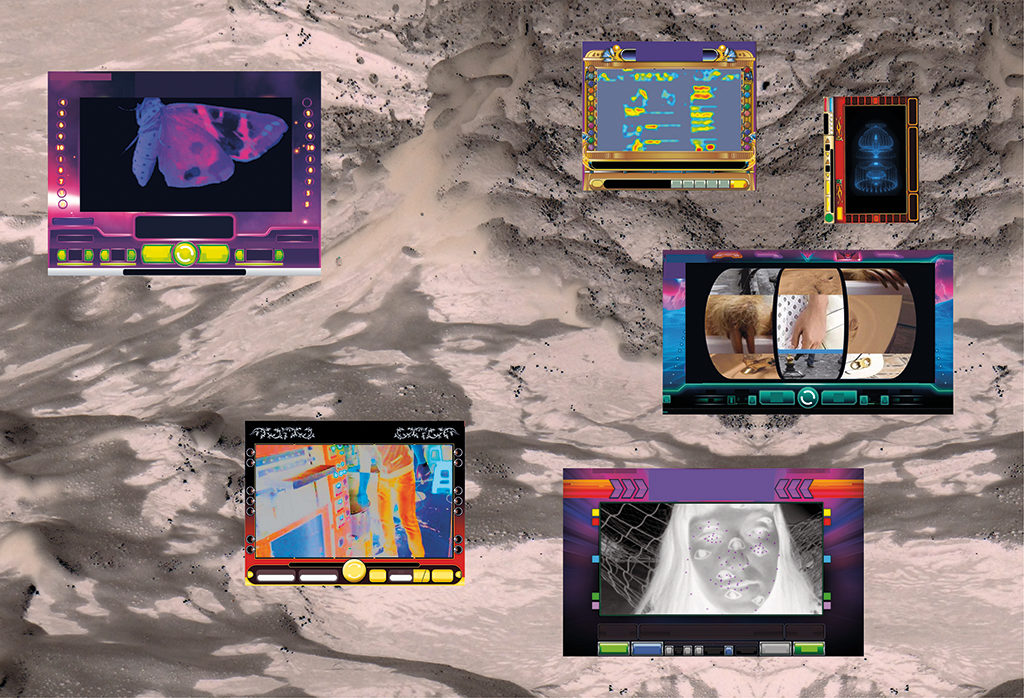
RC: You have collaborated with scientists as well as other artists and curators. How has this worked and what have these collaborations produced?
KB: The space of art offers an opportunity to tap into diverse fields of research, as a kind of (un)informed amateur. I find a Rancièrian strategy of ‘deliberate ignorance’ liberating. As an artist, I find myself in a position where I can turn my lack ofspecialist knowledge in fields like neuroscience into a kind of asset. I’m not answerable to a canon so can make unorthodox connections. In 2012, I started a conversation with clinical psychiatrist Dr Henrietta Bowden-Jones. Henrietta is fascinating as she started the first NHS clinic for problem online gambling and is now one of the leading experts in the field of online behavioural addictions. My collaboration with Henrietta has flourished, I think, because there is a recognition that there is a mutual benefit from the conversation but not an ownership or entitlement to each other’s outcomes.
RC: How does your work deal with the relation between physical and virtual presence?
KB: I am a tactile person, the sort who goes into a shop and strokes things with their face. I am fascinated by how digital devices act as portals into virtual worlds but often their own physicality isn’t dwelt on. Yet these devices connect us in a very tangible way to a globalised workforce and unethical labour practices. My iPhone has parts in it that were constructed by hand in an environment that resembles the Victorian workhouse more than the shiny aesthetics of the Apple store. These deeply dystopian factories create objects that seem so sleek, so smooth, so modern, as if they’ve arrived whole from outer-space. But they were created by workers who do compulsory over-time, sleep in triple bunk beds in small dorm rooms and aren’t even allowed to kill themselves. (I’m specifically referencing the suicide prevention netting that Foxconn put up around their buildings after a spate of mass suicides.)[note]‘Analyzing Labor Conditions of Pegatron and Foxconn: Apple’s Low-Cost Reality,’ China Labour Watch, 2015 http://www.chinalaborwatch.org/report/107, accessed 26 April 2017[/note] I’m emphasising physicality to connect my body lying in my bed to the body of someone bent over a production line; it is far too easy to dismiss the impact of our insatiable appetite for electronic goods.
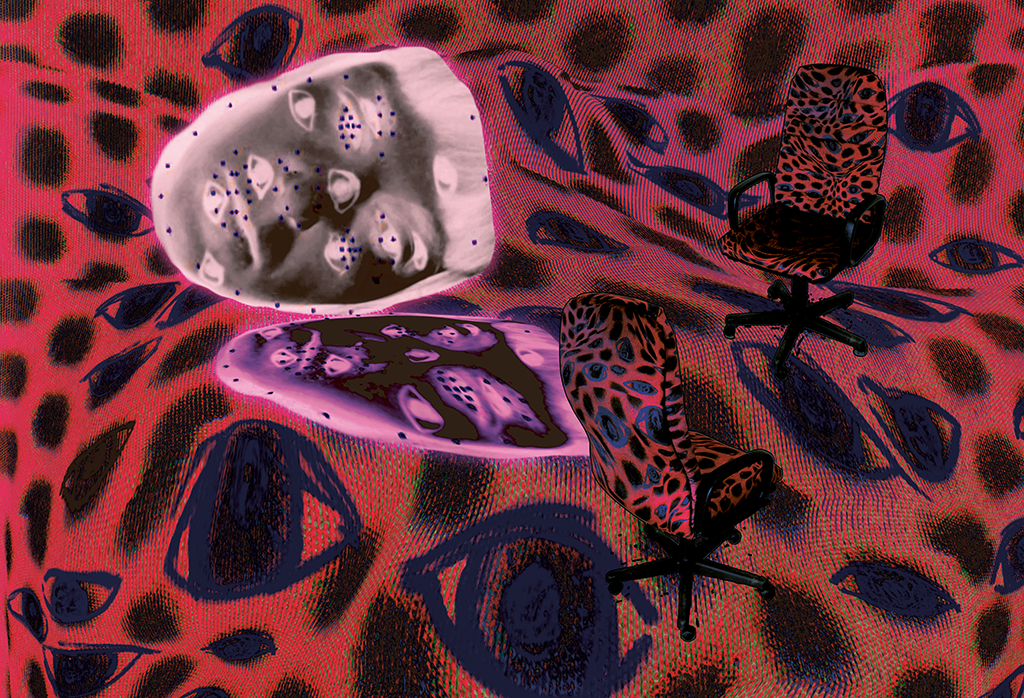
RC: Your exhibition at Furtherfield is to be sited in the heart of a public park. How are you thinking about the relationship of digital devices to the natural environment?
KB: I continue using my smartphone when I step inside the park gates, in a continuum of ongoing augmented experiences where my physical environments are overlaid with digital content. The park acts as a fulcrum for changing understandings of leisure as labour, labour as leisure, and is the perfect site for encouraging reflection on this relationship. As part of this, Fiona MacDonald, who has been working with me on Are We All Addicts Now? as both a curator and an artist, is developing a mycorrhizal meditation piece, looking at network culture from an organic non-human perspective.
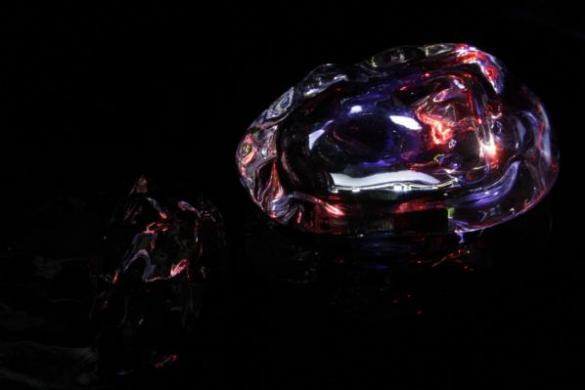
RC: I’d like to end with a description of some of the artworks and installations you are making, the materials you are using, and, in the context of the un-ideal strategies used by designers of mobile interfaces, what condition do you aspire to cultivate in visitors to your exhibition?
KB: I’m making a sunken plunge pool of a networked nest-bed, with glowing screens on which moths flutter embedded in glass orbs. Bed hangings embroidered with dichroic screens stripped from smartphones shimmer overhead, iridescent in the reflected light. I’m trying to communicate how seductive I find the screen in that dark, warm space – in those moments when I am more intimate with my device than my partner. There will be some participatory sculptures referencing pachinko and prayer beads, rhythmic movement, trance-like repetition, lulled into endless hypermobility in the closed systems of ‘communicative capitalism’. [5] I’m also working on some moving image works in which makeup is used as a tool to undermine eye tracking software, which I am hoping will incorporate some specialist hardware generating a live-feed of eye-tracking data from audience members. A series of table-top glass sculptures and embedded screens will explore interfaces that are ‘designed for addiction’ and the way notifications, for instance, are neuromarketing strategies seeking to ‘awaken stress — the mother of all emotions.’ [6] I’d like the audience to share in my disquiet, and hopefully leave encouraged to engage more critically with shaping their online worlds.
In her work, using video, performance and the Internet, Annie Abrahams questions the possibilities and the limits of communication, specifically its modes under networked conditions. A highly regarded pioneer of networked performance art, Abrahams brings her academic training in both biology and fine arts to develop what she calls an aesthetics of trust and attention. She creates situations that “reveal messy and sloppy sides of human behaviour” making that reality of exchanges available for reflection. We first worked with Abrahams in her exhibition ‘If not you not me’ in 2010 and then as part of a group show ‘Being Social’ 2012. In this interview we ask her to reflect on the limits and potentials of art and human agency in the context of increased global automation.
Catlow & Garrett: While predicated on the idea of connectedness, the global social media platforms are designed to profit the companies who create them and to keep billions of us in a state of trance-like immersion which has in turn been shown to cause many of us to feel more isolated. At Furtherfield we have always worked to grow more communal and collaborative contexts for artistic production. What does your current thinking – through your work on Participative Ethology in Artificial Environments: ethnological approaches to Agency Art – reveal for the potential of genuine, participatory networking environments?
Annie Abrahams: Participative Ethology in Artificial Environments: ethnological approaches to Agency Art sounds nice, but it needs a question mark at the end. It’s an interrogation. In times when our technological environment uses all kinds of behavioural techniques to make us uncritical users of their interfaces, it’s important to become aware of our behaviour, to test and experiment with it. My artistic work is based on doing that, but I always had great difficulties explaining it to art institutions etc.
A discussion I had with my friend Cor whom I studied biology with in the seventies, helped me find this latest description. I told her, that I think about my work as having human behaviour as its main aesthetic component and why I call it, silently, “behavioural art”. I compare what I do now to what I did when I studied biology. In both cases I observe behaviour in constrained situations. The monkeys, that were the study objects “became” humans and the cage the Internet.

Because the behavioural science of the late seventies didn’t suit me very well – using Skinner boxes, operant conditioning techniques and related to sociobiology, with a link to eugenics – it has become impossible to use this historically contaminated term. The wish to control, mold nature, and humans wasn’t mine. “Behavioural” was and still is a “stained” word for me. But even so, I do study behaviour and create constrained situations. I ask people to perform in a frame, they are framed in an apparatus, which is more or less perfect – the Internet provokes, lags, bugs, glitches, the computer is old or new, fast or slow, the interface determines how the performers can interact or not, the domestic situation interferes with noise and cats wanting to join in. There is a protocol/a script/a scenario but no rehearsal, just some technical tests. My approach is more phenomenological than scientific, I don’t measure anything. It’s up to the performers to explore their own behaviour, to reflect on it and to learn together what it means to be connected.
I told Cor, my annoyance with the tendency of art institutions to categorise art. Video art, poetry, contemporary art, literature, dance, painting, music and media art, computer art, code art, … It’s so impractical and superficial and it always takes a technology or a medium as its anchor point. It doesn’t say anything about what it makes possible, about what we can experience through it. Maybe that’s why I started to use the word performance, and performance art more and more. It’s a cross-discipline word. It’s multi purpose, but also a bit empty, I must admit.
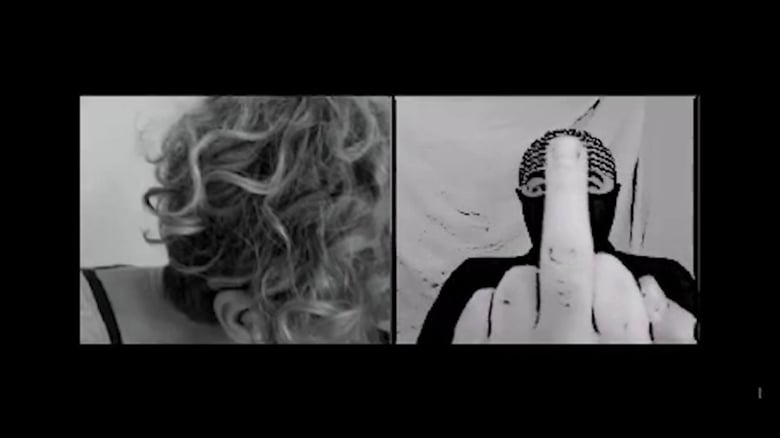
“Agency Art is art that makes it clear to the receiver via his or her body what is at stake, where opportunities for action lie, and which virtual behaviours he or she can actualize. It demonstrates how choices work.” Arjen Mulder, The Beauty of Agency Art, 2012.
In his article The Beauty of Agency Art, Arjen Mulder uses the concept Agency Art to indicate interactivity as the important component of an art work. It is an interesting attempt to develop a discourse for technology/media art in relation to the contemporary art discourse. He embeds his ideas in history and goes back to thinkers such as: Shannon, Wiener, MacKay, McLuhan, Cassirer, Langer, Gell, Latour, Heidegger, Derrida, Badiou, Rancière, Danto, Whitehead, Steiner, Rolnik and more. I like the concept because it determines art that has behavioural choices and gestures as its centre. Its meaning is the acts that are made possible. What is also important in Mulder’s reasoning, is the concept of “virtual feeling”, introduced by the philosopher Susanne K. Langer in her groundbreaking book Feeling and Form (1953). Langer explains how each individual art medium evokes, manipulates and investigates “virtual feelings” in its own way.
“A painting calls forth virtual depth with lines and colours; a sculpture constructs a virtual volume around itself; a novel constitutes virtual memory, tracked through virtual time. Dance follows virtual forces of attraction and repulsion. All the experiences that are part of this “feeling” are spaces of possibility, virtual feelings waiting for actualization; their nature, allurements and dangers must be studied, and art is where this investigation takes place” Arjen Mulder, The Beauty of Agency Art, 2012.
This is how to think of behaviour as an aesthetic force, I told Cor. This is a concept that I can use to talk about what is important to me. For me, the words are empowering and stimulating, pointing to Butler, ANT theory and Karen Barad, I cannot and won’t leave them behind me.
collectively made – refusing hierarchy- a knitting together of artists and performers in the moment of the event – erasure of the artistic ego – practice – changing rules – choices – connecting – accepting the unexpected – responsive – shared – collaboratively authored – open to all – working with temporal behavioural phenomena – healing – enactment – improvised – including environmental conditions – attentional strategies – instructions – protocols – apparatus – meeting – embracing the ordinary – rehearsing alternatives – re-hijacking therapy – exercising our relations to others – our social (in)capacities – exploring rituals – being together – participatory – concerns individuals and politics
These are keywords found while researching work (from fine art, dance, theater, music, performance, digital art to electronic poetry) I could consider being Agency Art : Deufert&Plischke’s work, LaBeouf, Rönkkö & Turner’s HEWILLNOTDIVIDE.US, Building Conversation by Lotte van den Berg, Deep listening by Pauline Oliveros, Poietic Generator by Olivier Auber, Lingua Ignota by Samantha Gorman and Walking Practices by Lenke Kastelein.
Using Agency Art also means being able to make cross sections through disciplines and to open up closed domains of practicing. And that is the moment in our conversation where Cor, who has also a degree in philosophy said : “It’s easy, call your work participative ethology in artificial environments.” I am still pondering and that’s why there has to be a question mark. There always have to be question marks.
#PEAE = #Participative #ethology in #artificial environments #ethnological approach #AgencyArt?
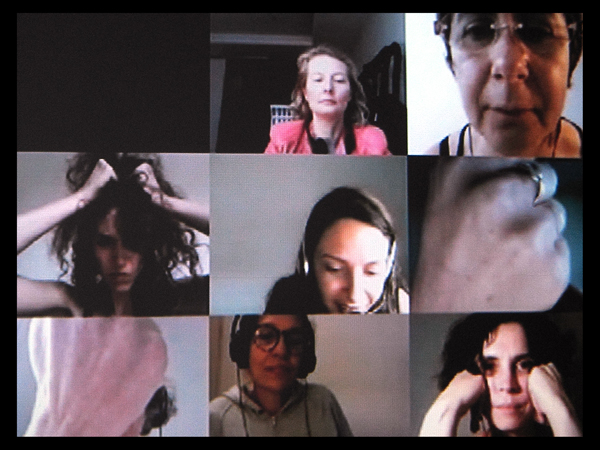
C&G: Katriona Beales drew our attention to the Kazys Varnelis’ essay in the Dispersion catalogue (ICA 2008) which talks about the concentration of power in nodes of connectedness. She says “So even if I write a response to Donald Trump’s tweet saying “I hope you’re impeached”, for example, I add to his power, just through the interaction. I end up contributing to his power base even though I explicitly disagree” This effectively rewards, with attention, those who inspire intense outrage, fury and derision. Interfaces play a crucial role in your network performances and deliberately prompt very different kinds of behaviour – we’re thinking in particular of Angry Women. What kinds of behaviours and responses does your work inspire?
AA: I agree the concentration of power in nodes of connectedness is disturbing and confusing. It puts us in a double bind situation, becoming petrified, unable to act or to flee because we can not choose. I think this might be true when we consider our role in big networks, but it is definitely different when we talk about smaller networks. There it matters what we say and especially how we say it. A big part of my work is to create situations / interfaces / performances that permit us to experiment and train our (un)capacities to do so in networked environments. Participating in one of my performances means taking risks – nothing is rehearsed, means accepting you can’t control everything, it means committing to continue even if all seems to go wrong, to be attentive to the others around you with whom you share the performance space, with whom you are co-responsible for the shared moment in time.
From the people watching I ask that they are aware of what is at stake in a performance. That they watch it not with a connoisseurs regard, but that they see it as an aesthetic experiment in which behaviour is the main aspect / asset. If they become sensitive they have access to a very intimate and fragile aspect of our being, to something we absolutely need to discover further if we want to escape an allover binary future.
For myself I analyse the “concentration of power in nodes” phenomenon as the result of something you could call a lack of res-ponsability in our online affect management. When you are always scrolling you are unaware of the reaction you provoke, you are not awaiting a reply, but already on the next, next, next photo or short text. There is very little interactivity, and even less exchange. We act without caring for what our words, actions, and ideas bring forth. We might not be aware but our words, actions, and ideas live beyond us, they do intra-act with the actual situation. They are things acting in a world. (**)
** I have been reading texts on intra activity, a neologism introduced by the physicist, and feminist theorist Karen Barad. It’s difficult stuff. This video (Written & Created by: Stacey Kerr, Erin Adams, & Beth Pittard) gives easy access to one of her most important points.
C&G:
Yes, it is now totally normal to refer to “people” as “consumers”, every organisation an “enterprise”, which in turn leads to proposals for the nation-as-a-service, populated and run in the interest of private enterprise as offered by the e-stonia bitnation project.
By accepting the impoverishment of experience and reduction in agency implied by this label we can forget about ourselves as “actors” in the world, and become the cattle of the few. The only agency we are offered is as a responsible consumer (in which our powers are reduced to a binary option to buy or not). This is the new democracy.
In the UK these days, art audiences are often described as “consumers”. How else in your view might we conceive of “audiences”. What agency might we wish for them. And what part might our relationship with devices and digital networks play in this new description?
AA: We are not yet used to machines reacting to and using affects, tapping into our endocrine system. Articles like “Our minds can be hijacked’: the tech insiders who fear a smartphone dystopia” make us more and more aware of how we are manipulated and distracted, how our attention is designed, guided, influenced, used. But a lot of it is still hidden and because it’s so rewarding and because we “need” the attention we continue to click and vote. It is possible to create environments where people can slow down and have more subtle, nuanced agency, where they can participate and become aware and reflect on of their own behaviour. DIWO projects for instance have that power. People, especially art lovers, can be challenged to engage with others in interesting actions and conversations.
With Daniel Pinheiro and Lisa Parra in Distant Feeling(s) we invited the audience to join us in an experiment where we share an interface, normally used for online conferencing, with our eyes closed and no talking allowed. It led to very diverse observations shared via social media and email exchanges: liminal space – pure motion – an intimate regard – a field of light – dissolved, destabilized – an altered state – a telematic embrace – a silent small reprieve – hanging out with friends – machines conversing across the network only when the noisy humans finally shut up – an organic acceptance of silence?
Keywords from the reactions : http://bram.org/distantF/
Distant FeelingS #3 | VisionS in the Nunnery – Oct5-Dec18 2016
C&G: Unlike technologies and forms of production that work in the area of speculative realism, automation and AI, you still place humans and human relations at the centre, how do you view the current moves to shift agency away from humans into these ranges of techno-social systems?
AA: I am particularly intrigued and troubled by what is called deep learning. The algorithms produced by the machines themselves have a big influence in and, we must be honest, potential for for instance the health care business. They also determine on what moment of the day, depending on your mood you will see which advertisement on your device. As explained in The Dark Secret at the Heart of AI nobody can really understand how these applets produce their outcome – not even the programmers who build them.
For me this is problematic. Algorithms cannot invent what didn’t exist before and so they tend to reproduce / to select more of the same / to reinforce the existent. (see deep dream images) Moreover a lot of deep learning is based on the algorithm learning to produce a desired outcome.
As the machines are also designed to make us ready for their coercion, we are already subconsciously, intuitively adapting to these black box processes. We need to try to understand how these processes influence us, not because they are necessarily bad, but because our interests might not always coincide, we might want to differ. We don’t all have to learn programming the machines. That has become far too complicated and specialist and maybe not the best route to take. But we could engage in projects who try to find out how to influence machine behaviour, how to keep some agency. Maybe by introducing noise and entropy into the processing, so, together with the machines we can continue to cherish difference and diversity.
C&G: This question connects with the previous one. How do you see the role of artists in finding ways to negotiate a healthy relationship between artistic agency and capital-driven-machine worlds?
AA: This is a very difficult question to which every artist has to formulate her own answer. But it for sure passes by trying to open up spaces and discussions with people who have other opinions than yours, to going beyond safety-zones, to finding ways to communicate with and about hatred, angst and love.
*——————–*
This editorial series, takes digital addiction as its theme, and sits alongside the Are We All Addicts Now? exhibition, book, symposium and event series, we are hosting at Furtherfield. Are We All Addicts Now? Is an artist research project led by Katriona Beales and has been developed in collaboration with artist-curator Fiona MacDonald: Feral Practice, clinical psychiatrist Dr Henrietta Bowden-Jones, and curator Vanessa Bartlett. It looks at the application and impacts of many different research findings in the creation of digital interfaces, devices and experiences under the conditions of Neoliberalism.
‘We had a dream last night, we had the same dream'[1]
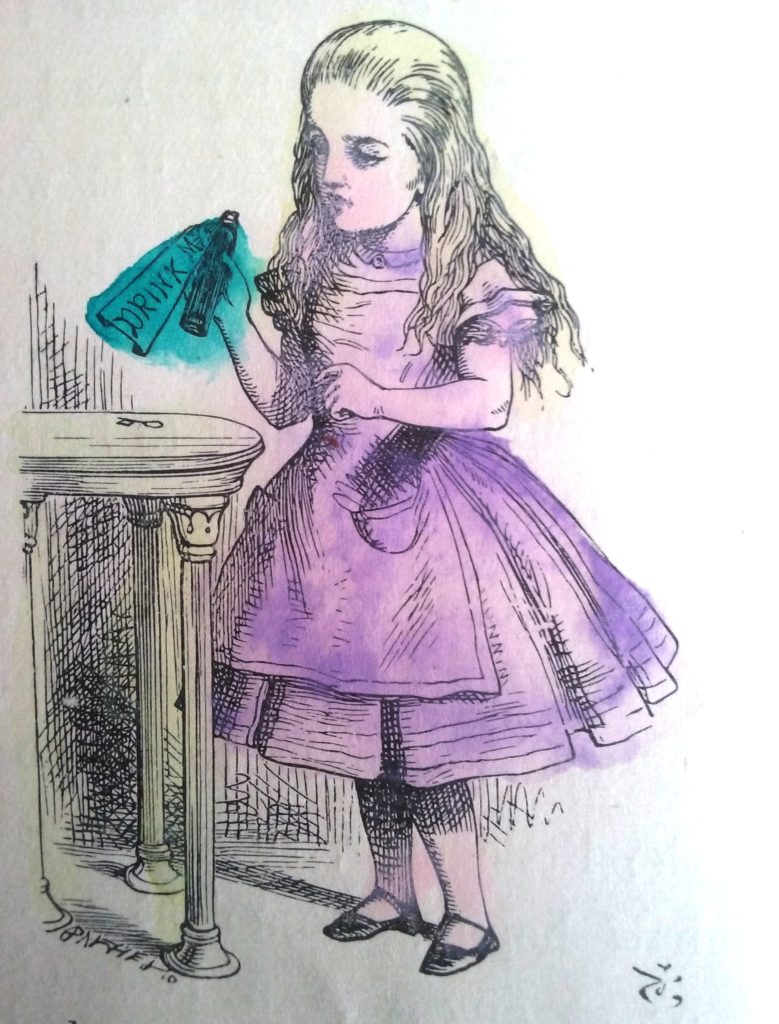
I’m looking for a new love, a mouth that promises . . .
once upon a time . . .
or . . .
in the beginning . . .
the islands in the net were fewer, but people and platforms enough
for telepathy far-sight spooky entanglement
seduction of, and over, command line interfaces
it felt lawless
and moreish
wandering into the maw of the feast
in the realm of the Puppet Mistress, 1995
speech acts, sex acts, strange pacts
squirreled away in buffer logs and pasted Pine trails
weaving 1001 nights of Puppet Mistress tales
never on the down-low
was this most splendid DIWO
permission granted,
always, all ways
read write execute
reeds rites hexecutes
I was Alice clasping the little bottle labeled ‘DRINK ME’
becoming-Sufi, heady with some love-like like love emotions
juiced up jouissance
psychosomatic investigations
psi psi psi
ψ ψ ψ
sigh
seeking the difference/s
if any
between a suspected false binary
Virtual — Real — Life
difference
différance
different ants
worker queens snorting lines of flight
‘IRL’ (‘in real life’) prefaced conversations
whereas no-one said ‘IVL’
VL was the norm
so no need for a distinguishing preposition
whereas you needed to go somewhere, in, purposefully,
to get (back) to real life
Back to life, back to reality
Back to the here and now yeah
. . .
Back to life, back to the present time,
Back from a fantasy
Soul II Soul 1989
I ask Monstrous_Gorgeous (aka t0xic_honey @Lambda) to trawl through my stash of Moologs and MOOmails from my Lambda life, to search for signs of digital affliction. t0x’s forensic gaze (who eirself had been a keen Lambda queercoder back in the day) might be illuminating. GashGirl and her morphs(GenderFuckMeBaby, Madame_de_Clairwill, doll yoko, Rent_Boy, et al) had run amok and amongst simultaneous games, switching genders, personae and communicative registers as easily as children playing ‘let’s pretend‘. The best game was that between Puppet Mistress and her Puppet (aka YourPuppet). Today the language seems quaint, The Difference Engine meets The Pearl, steamy stream punk. All bonnets, bronze and tiny buttons.
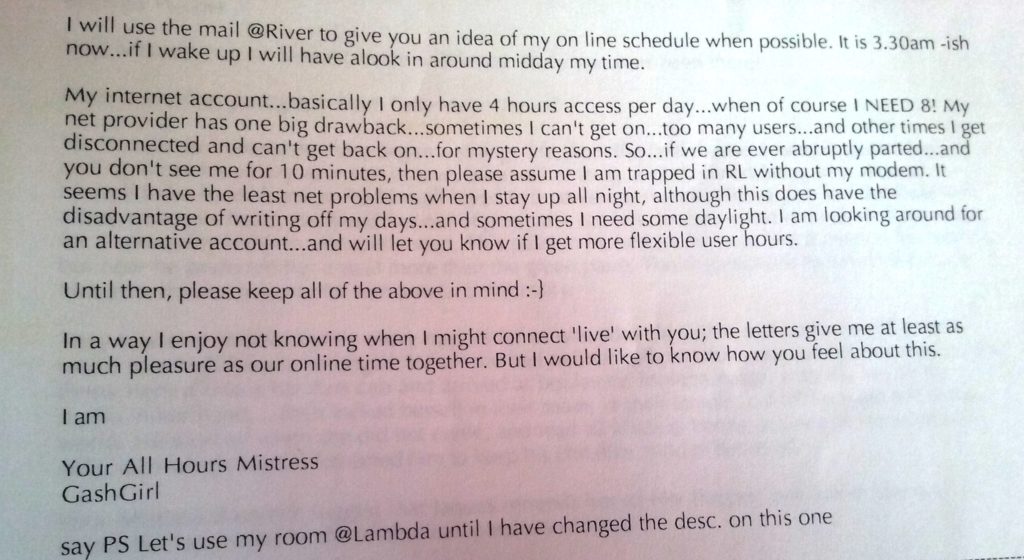
Wolf.
Homunculus.
Ghost.
Doll.
It’s a sky-blue sky.
Satellites are out tonight.
Let X=X.
Laurie Anderson 1982
does X=X?
or VL = zero?
with RL the one of ones, the one and all,
the only one (of all possible lives)
I think not!
t0x phones me, recounting episodes that I cannot recall, but which are so in-character I have for sure they happened. Like when I punished My Puppet severely for daring to speak with t0x about her in-MOO peep show. Now we can laugh about it, now that the field lies fallow, but at the time I was furious. Living at (on? in?) LambdaMOO did not diminish affect or emotion, but rather it intensified thought, sensation, desire, need.
can we call this addiction?
or obsession?
compulsion maybe?
I chatted this week with Jon Marshall, my anthropologist friend and author of Living on Cybermind (an ethnography of a mailing list), about how it felt more like a habit than an addiction. He talks about personally accumulated habits and socially accumulated habits. Humans are constructed of habits, including the habits that you build up around internet use. We recall the ‘Rape in Cyberspace‘ event at LambdaMOO; ‘that story becomes a myth that guides behaviour’, suggests Jon. My habit would not have led to such intense encounters, if all of us lot had not been sharing a gravitational pull to the glimmering galaxies of spiralspace. My twin talks about habit lying at the junction of nature and nurture, opening up another line for future investigation. Never enough time. Instead I loaf around on Netflix with Terrace House: Boys & Girls in the City.
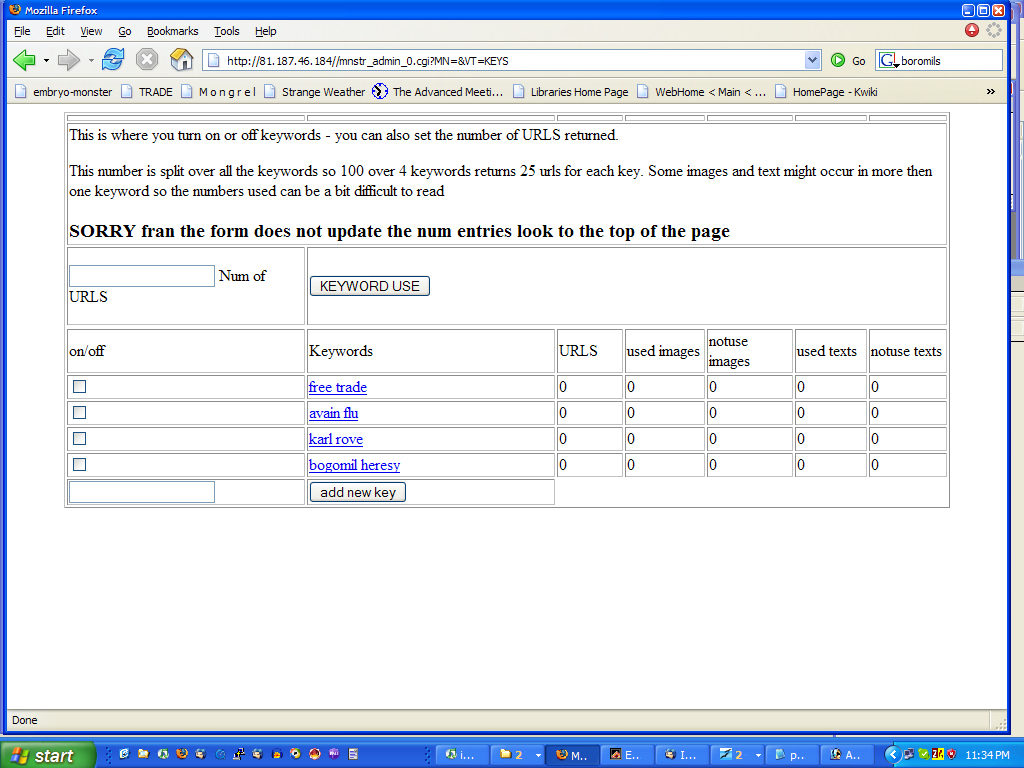
for me the habit of MOO (Mu) was quickly formed,
and devastating to desert
Ripping through a damaged heart
in the best of daze
circa 1992 93 94 95 96
(=3)
I didn’t leave home
a charming house with a white peach tree, goblin hut
and a dial-up 14,400 modem usurping landline’s phone functionality
for years I burrowed in through a borrowed log-in
J (aka connie_spiros @Lambda) pounds on front door to kick me off
later I jumped onto a free account offered by community provider apana
through its tiny sibling sysx (thank you Scott and Jason)
part of a tribe meshwork of cool sysops animating .net
motivated by the conviction of net access for all
xs4all
excess for real
S (aka Quark @Lambda) told me how depressing it was to leave home at 7.30am seeing me already jacked in, and to find me still in pajamas at dinner time, a sure sign that I hadn’t stepped away from the computer all day.
frequently he’d say ‘What’s wrong with this picture?’
(rhetorical)
5 words yanking me from my fugue
to discover myself pretzeled around the machine
in a position so unnatural it had become natural
to a life lived more and more in a VL that had become my RL
there was a vastness to the generative affective experiences
it felt unstoppable
on par with the most exhilarating love affairs
continual platform jumping
(don’t mind the gaps)
with unseen but deeply imagined companions
haunting me from nautical twilight to nautical twilight
netmonster, 2005
The only platform that came close to the seductiveness of Lambda was Netmonster, a network visualisation engine built by artist coder tinkerer Harwood (aka Graham Harwood). I was fascinated by the code and what it could do. And I adored the constant communication with my bruvv, the one who calls me ‘witch sister’. We hung around on the server, chatting white text on black screen. I made him a self-executing poem in Perl, my one and only attempt to learn some rudiments of that language. Netmonster could be a machine for collaborative writing, for prophesy, a tool for poking around in the machinations of power and capital. I imagined its transformative potential on a magical level, casting silver spanners into the bellyworks of the Beast. As a user I became tangled in search strings questing for the grail of understanding. Without knowing what I was asking, I pushed Harwood to push the code, Perl, to do things it wasn’t designed to do. The machine groaned under the weight of requests, and eventually its interactive functionality was turned off (brutal!), leaving just a beautiful hyperlayered carapace online. The emptiness I felt when the living essence of the project was no longer was comparable to the hole of grief when a lover says it’s over. The spirit of Netmonster had left forever. I was alone again.
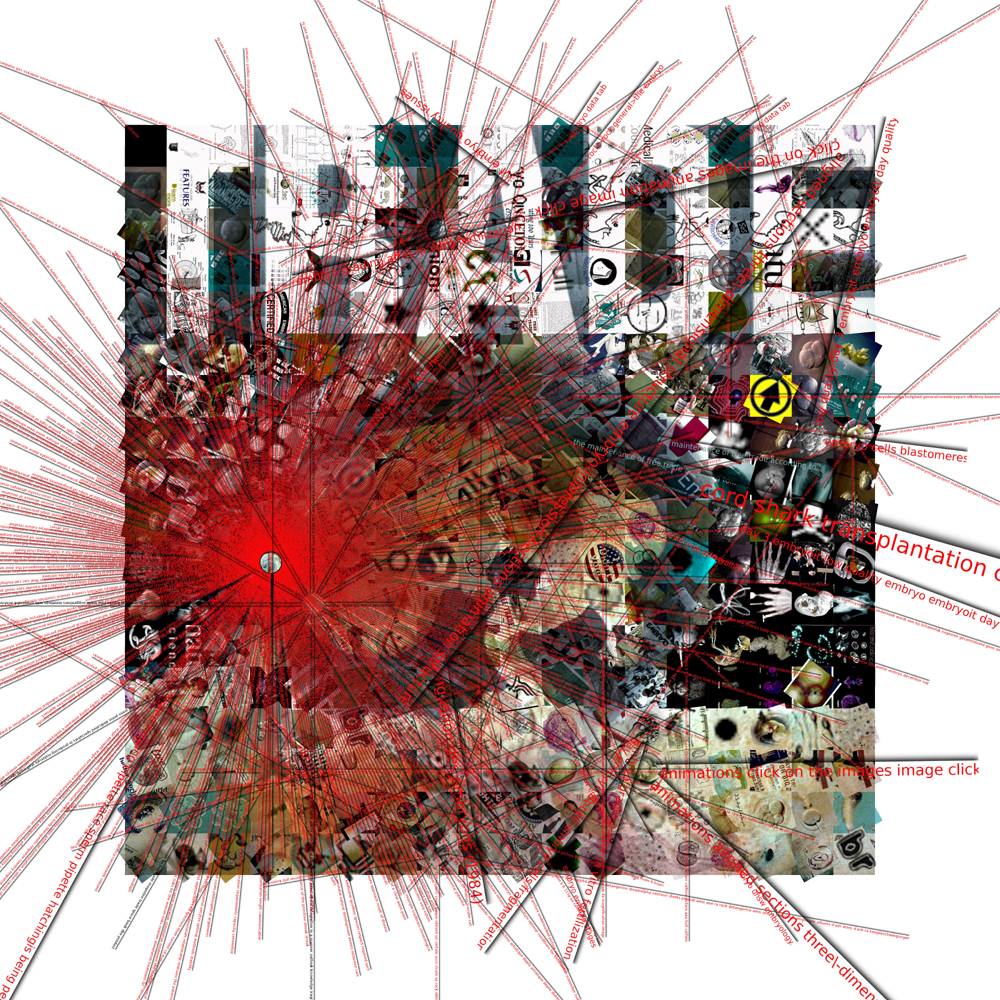
clever little tailor, 2017
There’s a few of us chatting around a table in Clever Little Tailor, an affordable bar if you stop after one drink. Around the table S2 (artist/student, early 20s), A (poet/singer/student maybe just grazing 25), and a couple of ancient cyberwitches. We speak about imbuing inanimate objects, a child’s wooden horse, a Persian rug, with magical powers, to speak, to fly. The human tendency to want to create life in things, including things and wings of internet, and this predisposition in turn enlivens and expands us. The topic turns to matters of the heart, and native/natal platforms. Those communicative modes that either we were born into or grew into, the sticky tongue finger techs that we associate with our netted emotional and social lives. We talked about coding and not coding, about the need to live online, and the impulse to desert it. Instant Messaging is for S2 what Internet Relay Chat was for us. We spell out the spell of Command Line Interface in a condensed version of how we uploaded ourselves to the song of the modem, waiting up all night to be able to play, existing betwixt and between multiple time zones. We struggle to find the right words (because the material of this stuff is made of words but is so not about words really) to evoke the deliciousness of what was a relatively uncolonised uncommodified unregulated ineffable space. Even if we hexen rarely use the word ourselves, the neologism (and who could forget Neo!) cyberspace, continues to signify the consensual hallucination of jacking in to the zone. Maybe now it’s more mall than sprawl for us who experienced something more unbounded, but for the next gens the intensities, the desires are equivalent.

17.10.17
forever doll
becoming witch
she opens her mouth
and swallows the world
she opens her mouth
and swallows your word
dissolving like spun sugar
laced with saffron threads
hexe hexe hexe
tiva! tiva! tiva!
naughty naughty naughty
all for naught
and nought for one
zero and one
zeno and won
one on one on one
on and on and on . . .
Thank you to old and new friends whose ideas have nourished this text: Virginia Barratt, Alison Coppe, Linda Dement, Teri Hoskin, Jon Marshall, Stuart Maxted, John Tonkin. Big thanks to (bruvv) Graham Harwood for inviting me to play and live inside Netmonster in 2005.
Francesca da Rimini (aka doll yoko, GashGirl, liquid_nation, Fury) is an interdisciplinary artist, poet and essayist. She revels in collaborative projects, joining companions in generating slow art, strange beats and new personae. As co-founder of cyberfeminist group VNS Matrix she contributed to international critiques of gender and technology. The award-winning dollspace deployed the ghost girl doll yoko to lure web wanderers into a pond of dead girls. As GashGirl/Puppet Mistress, she explored the uploaded erotic imagination of strangers at LambdaMOO. More recent performances , collaborations and installations including delighted by the spectacle, hexecutable, songs for skinwalking the drone, hexing the alien, and lips becoming beaks have combined rule-driven poetry, fugue states, spells and prophesies as hexes against Capital.
“Certain subjects compel me – alchemy, folklore/folk law, emancipatory social experiments, the nature of cognition, and states of ‘madness’ and ecstasy. I approach art-making as a hexing, a spell, a witch’s ladder to another realm. To paraphrase anarchist anthropologist David Graeber, a revolutionary act is to behave as if one were free.” da Rimini
Furtherfield is delighted to announce the selection of Sarah Friend’s Clickmine for a new co-commission with NEoN Digital Arts Festival. The work will be exhibited Thursday – Sunday 9-12 November at NEoN Digital Arts Festival in Dundee.
Clickmine is a hyperinflationary ERC-20 token that is minted by a clicking game. Clicking games, like cookie clicker and cow clicker, are the reductio ad absurdum of a ‘game’ (brutalist with a sense of humour). Clickmine moves similar mechanics onto the blockchain, in a hypercapitalist frenzy that makes the generation of useless wealth via clicking more literal than ever before.
The cryptocurrency ecosystem, (particularly the Ethereum network), has been overrun by the phenomena of token sales or ICOs (Initial Coin Offerings). The fervor to purchase ERC-20 tokens (a meta currency that exists on top of Ethereum itself) has reached such an intensity that it stalls the processing time of the network. This has already prompted the creation of satirical coins UselessToken and Ponzicoin.
Clickmine was proposed by Friend in response to The CryptoDetectorist – hoards, coins and trades call for proposals from Furtherfield and NEoN Digital Arts Festival. While archaeology has often understood cultures through excavations of hoards and coins, we asked, what will today’s digital currencies tell future archaeologists about the way we live and trade?
This commission forms part of Furtherfield’s ongoing investigations into the politics of the blockchain, smart contracts, and cryptocurrency systems and NEoN Digital Arts Festival 2017 programme using ‘media archaeology’ to uncover and reconsider the obsolete, persistent, and hidden material cultures of the technological age. It will be launched online and presented at NEoN Digital Arts Festival in Dundee Scotland November 2017 then at the Digital Futures programme at V&A Museum and MoneyLab both in London in Spring 2018.
Friend is an artist and software engineer focused on the development of games, interactive experiences, and open source tools. Her work to-date has been concerned with the polar concerns of privacy and transparency, how to design ethical interfaces, and the political and environmental implications of technical systems.
She is currently working at a blockchain development studio on tools for accounting and analytics, while maintaining an art and game-making practice. Her work has recently been part of exhibitions at the British Public Library, The Center for Contemporary Art Tel Aviv, and Radical Networks, a conference in Brooklyn. She is a judge for Wordplay: the Festival of Writerly Games, exhibiting at Damage Camp, a games conference in Toronto, and presenting on the technical challenges of blockchain games at the Montreal International Games Showcase. Community organizations she is involved with include: Toronto Mesh, The Reported (a database of police-involved deaths in Canada), The Toronto Tool Library, and Dames Making Games.
Furtherfield
Through artworks, labs and debate around arts and technology, people from all walks of life explore today’s important questions. The urban green space of London’s Finsbury Park, where Furtherfield’s Gallery and Lab are located, is now a platform for fieldwork in human and machine imagination – addressing the value of public realm in our fast-changing, globally connected and uniquely superdiverse context. An international network of associates use artistic methods to interrogate emerging technologies to extend access and grasp their wider potential. In this way new cultural, social and economic value is developed in partnership with arts, research, business and public sectors.
NEoN
NEoN (North East of North) based in Dundee, Scotland aims to advance the understanding and accessibility of digital and technology driven art forms and to encourage high quality within the production of this medium. NEoN has organised 7 annual festivals to date including exhibitions, workshops, talks, conferences, live performances and public discussions. It is a platform to showcase national and international digital art forms. By bringing together emerging talent and well-established artists, NEoN aims to influence and reshape the genre. We are committed to helping our fabulous city of Dundee, well known for its digital culture and innovation, to become better connected through experiencing great art, networking and celebrating what our wee corner of Scotland has to offer in the field of digital arts.
State Machines: Art, Work and Identity in an Age of Planetary-Scale Computation
Focusing on how such technologies impact identity and citizenship, digital labour and finance, the project joins five experienced partners Aksioma (SI), Drugo More (HR), Furtherfield (UK), Institute of Network Cultures (NL) and NeMe (CY) together with a range of artists, curators, theorists and audiences. State Machines insists on the need for new forms of expression and new artistic practices to address the most urgent questions of our time, and seeks to educate and empower the digital subjects of today to become active, engaged, and effective digital citizens of tomorrow.
V&A Digital Futures: Digital Futures
V&A Digital Futures: Digital Futures is a monthly meetup and open platform for displaying and discussing of work by professionals working with art, technology, design, science and beyond. It is also a networking event, bringing together people from different backgrounds and disciplines with a view to generating future collaborations.
Creative Scotland
Creative Scotland is the public body that supports the arts, screen and creative industries across all parts of Scotland on behalf of everyone who lives, works or visits here. It enables people and organisations to work in and experience the arts, screen and creative industries in Scotland by helping others to develop great ideas and bring them to life. It distributes funding from the Scottish Government and The National Lottery.
This project has been funded with the support from the European Commission. This communication reflects the views only of the author, and the Commission cannot be held responsible for any use which may be made of the information contained therein.
DOWNLOAD PRESS RELEASE
The blockchain is widely heralded as the new internet – another dimension in an ever-faster, ever-more powerful interlocking of ideas, actions and values. Principally the blockchain is a ledger distributed across a large array of machines that enables digital ownership and exchange without a central administering body. Within the arts it has profound implications as both a means of organising and distributing material, and as a new subject and medium for artistic exploration.
This landmark publication brings together a diverse array of artists and researchers engaged with the blockchain, unpacking, critiquing and marking the arrival of it on the cultural landscape for a broad readership across the arts and humanities.
Contributors: César Escudero Andaluz, Jaya Klara Brekke, Theodoros Chiotis, Ami Clarke, Simon Denny, The Design Informatics Research Centre (Edinburgh), Max Dovey, Mat Dryhurst, Primavera De Filippi, Peter Gomes, Elias Haase, Juhee Hahm, Max Hampshire, Kimberley ter Heerdt, Holly Herndon, Helen Kaplinsky, Paul Kolling, Elli Kuru , Nikki Loef, Bjørn Magnhildøen, Rhea Myers, Martín Nadal, Rachel O Dwyer, Edward Picot, Paul Seidler, Hito Steyerl, Surfatial, Lina Theodorou, Pablo Velasco, Ben Vickers, Mark Waugh, Cecilia Wee, and Martin Zeilinger.
Read a review of the book by Regine Debatty for We Make Money Not Art
Read a review of the book by Jess Houlgrave for Medium
You are invited to join us for a research workshop responding to the Are We All Addicts Now? exhibition at Furtherfield Gallery.
The visual matrix is a new psychosocial research technique that we are using to generate audience response to the project. Vanessa Bartlett has written a blog about this fascinating curatorial research process which is designed to test how a broad range of arts, science and technology audiences respond to interdisciplinary arts projects. Content generated during this session will inform our evaluation of Are We All Addicts Now?
Participants will be invited to view the exhibition at Furtherfield Gallery. Then, over the course of 45 minutes, participants will engage in a process of generating images and associations related to their experience of the work that they have seen. You will be seated throughout, engage with other participants and be encouraged to provide verbal associations if and when you are comfortable speaking. The visual matrix will be audio recorded. Following this there will be a short break and a second session lasting 45 minutes where participants will be asked to consider the images and associations generated by the group in a discussion. Optional five-minute ‘exit interviews’ with individual participants will take place at the end of the process.
Our research team will study the material that we have recorded. Anonymised excerpts will be used for further research and publication including conference and journal articles.
If you are interested in participating please contact v.bartlett [at] unsw.edu.au for more information.
The visual matrix method was created and developed by Lynn Froggett and her team at the Psychosocial Research Unit at University of Central Lancashire.
Research Team: Dr Elizabeth Muller and Miss Vanessa Bartlett, UNSW Australia. Ethics Approval No: HC16612
Email v.bartlett [at] unsw.edu.au to book your place.
Furtherfield Gallery
McKenzie Pavilion
Finsbury Park, London, N4 2NQ
Visiting Information
Part of the Are We All Addicts Now? exhibition at Furtherfield Gallery
A lecture, a performance, and a fungi walk.
Feral Practice presents a multi-media performance-lecture, informed by the history, art and science of human-fungal relations. It explores themes of reciprocity, intuitive and nonverbal interconnection between people, psychedelic consciousness, fungal songs, shamanic journeying, and plant communication.
This will be followed by a live ritual performance of Mycorrhizal Meditation, a new sound art work commissioned for the current exhibition, Are We All Addicts Now?, available for download throughout Finsbury Park and here.
A fungi specialist will then lead a walk that explores some of the fungi growing in Finsbury Park and on the Parkland Walk Nature Reserve.
To end, there will be an opportunity to visit Furtherfield Gallery, offering a chance to see and discuss the current exhibition.
Please bring warm, weather-appropriate clothing and footwear. In the event of rain, the event will go ahead, please dress accordingly and bring an umbrella.
As part of the exhibition Are We All Addicts Now? Fiona MacDonald: Feral Practice presents Mycorrhizal Meditation; a spoken-word guided meditation that choreographs a connective journey through the human body and down into a dynamic, semiotic underworld of living soil and mycorrhizal network, with sound recordings made in wooded places, including movement and rhythm captured from microphones hidden underground and inside trees. It complicates a notion of nature as ‘ultimate digital detox’, and guides the user towards the startling interconnectivity of beyond-human nature, the ‘wood-wide-web’ that predates our digital connectivity by millennia.
Mm is available to download free, via posters in the gallery and across Finsbury Park.
Alongside the exhibition, the essay Homo Mycelium will be published in the accompanying Are We All Addicts Now? book, edited by Vanessa Bartlett and Henrietta Bowden Jones, designed by Stefan Schåfer and published by Liverpool University Press.
Fiona MacDonald is an artist, curator and writer specializing in human-nonhuman relationship. As Feral Practice, she works in co-production with a collective of human and nonhuman persons. Current projects include Foxing, (see PEER London, 2017) Ant-ic Actions (see Ethical Entanglements, Bloomsbury Press, forthcoming) Homo Mycelium, and Wood to World (London, Kent, Aberdeen 2015-17).
www.feralpractice.com
Furtherfield Commons
Finsbury Park, London, N4 2NQ
Visiting Information
A late night opening of the Are We All Addicts Now? exhibition, followed by a screening of artists’ moving image work that has informed the development of the exhibition.
The exhibition and research project Are We All Addicts Now? explores the seductive and addictive qualities of the digital.
Artist Katriona Beales’ work addresses the sensual and tactile conditions of her life lived online: the saturated colour and meditative allure of glowing screens, the addictive potential of infinite scroll and notification streams. Her new body of work for Are We All Addicts Now? re-imagines the private spaces in which we play out our digital existence. The exhibition includes glass sculptures containing embedded screens, moving image works and digitally printed textiles. Beales’ work is complemented by a new sound-art work by artist and curator Fiona MacDonald : Feral Practice.
Beales celebrates the sensuality and appeal of online spaces, but criticises how our interactions get channeled through platforms designed to be addictive – how corporations use various ‘gamification’ and ‘neuro-marketing’ techniques to keep the ‘user’ on-device, to drive endless circulation, and monetise our every click. She suggests that in succumbing to online behavioural norms we emerge as ‘perfect capitalist subjects’.
Part of the Are We All Addicts Now? exhibition at Furtherfield Gallery
Furtherfield co-director Ruth Catlow and artist Katriona Beales will be talking about the artwork featured in the exhibition at Furtherfield Gallery, Are We All Addicts Now?, followed by a group discussion.
In the exhibition, Katriona Beales addresses the sensual and tactile conditions of her life lived online: the saturated colour and meditative allure of glowing screens, the addictive potential of infinite scroll and notification streams. Her new body of work for Are We All Addicts Now? re-imagines the private spaces in which we play out our digital existence. Beales celebrates the sensuality and appeal of online spaces, but criticises how our interactions get channeled through platforms designed to be addictive – how corporations use various ‘gamification’ and ‘neuro-marketing’ techniques to keep the ‘user’ on-device, to drive endless circulation, and monetise our every click. She suggests that in succumbing to online behavioural norms we emerge as ‘perfect capitalist subjects’.
Join Ruth and Katriona to find out more about the works featured in the exhibition and to discuss the issues that it raises around digital addiction and online behaviour.
Katriona Beales is an artist who makes digital artefacts, moving image and installation, stressing the physicality of digital life. Are We All Addicts Now? develops Beales’ 2015 work ‘White Matter’ (a FACT commission for ‘Group Therapy: Mental Distress in a Digital Age’) which is showing at the University of New South Wales, Sydney as part of Anxiety Festival (Sept 2017). Beales’ received an MA from Chelsea College of Arts and has an artist profile on Rhizome.org
www.katrionabeales.com
Ruth Catlow is an artist and curator working with emancipatory network cultures, practices and poetics. She is co-founding director, with Marc Garrett, of Furtherfield. As new digital processes change the way we live, Furtherfield champions the need for society and culture to evolve critical, aesthetic and ethical responses in parallel, bringing together cultural and technological innovation. Recent commissions include Time Is Speeding Up (20-21 Visual Arts Centre); Sociality-machine (Tate); and Play the Web We Want (Southbank Centre). Catlow is named by the Foundation for P2P alternatives in their list of 100 women Co-creating the P2P society.
ruthcatlow.net
furtherfield.org
Furtherfield Gallery
McKenzie Pavilion
Finsbury Park, London, N4 2NQ
Visiting Information
While archaeology has often understood cultures through excavations of hoards and coins, what will today’s digital currencies tell future archaeologists about the way we live and trade?
This co-commission with NEoN Digital Arts Festival forms part of Furtherfield’s ongoing investigations into the politics of the blockchain, smart contracts, and cryptocurrency systems like Ethereum. It invites artists to imagine themselves as future media archaeologists, as recorders of our current information-based society, and as time-travelers highlighting the continued relevance of our long past. Will you dig for the digital, brush the dirt off the non-material, or excavate the internet?
In an era that threatens to be a digital dark age for future historians [1], blockchains may prove to be rare digital artefacts valuable enough to preserve into the future. There are already dozens of dead chains from abandoned cryptocurrencies [2], but with billions of dollars of value tied up in Bitcoin, Ethereum and other leading coins, the incentives to maintain their public ledgers are strong. Culture and knowledge have already been hidden in the blockchain – from images of Nelson Mandela to WikiLeaks cables [3] – but it is the blockchain as a record of our economic activity that concerns us here. This already has its history; on these public digital ledgers we can find everything from the ten thousand Bitcoins that were used to buy two pizzas [4] to the fifty million dollars of Ether that were stolen [5] in a hack on code running on the Ethereum blockchain. We just don’t have the best tools to visualise them yet.
We invite proposals for a new artistic online commission that takes the blockchain as the site of its manifestation. For example, artworks that are:
Whatever it is, it should work as a future media archeological artefact of blockchain finance and it has to be exhibitable online.
Hailed as both emancipatory opportunity for creative autonomy, and a driver of inequality and corporate opacity, the blockchain [10] is widely described as the Internet of Money. The blockchain is overtaking the WWW as the next big network technology for speculation and disruption. Investors recognise its potential in numerous ways: for high level authentication of identity [11] and matter [12]; for more efficient and secure financial transactions and distribution of digital assets; for communications so secure as to facilitate voting; and as a coordinating technology for the billions of devices connected to the Internet [13]
50 years ago this year, the world’s first ATM was designed, built and shipped from Dundee and installed in Enfield, less than 10 miles from Furtherfield. With this commission Furtherfield and NEoN recognise the role that the city of Dundee has played in the history of the development of smart technologies for financial transactions, through it being home to the R&D wing of The National Cash Register Corporation – NCR. [14]
NEoN Digital Arts Festival 2017 will expand on it being Scotland’s Year of History, Heritage and Archaeology, and seek to use its arts programme to unveil hidden histories through the practice of ‘media archaeology’. Media archaeologists uncover and reconsider the obsolete, persistent, and hidden material cultures of the technological age – from big data software algorithms to tiny silicon chips. With support from the National Lottery through Creative Scotland’s Open Project Fund, and Creative Europe Programme of the European Union, NEoN and Furtherfield invite artists to consider how the blockchain is the new ATM of the future.
The commission will be launched online and at NEoN Digital Arts Festival, and presented at the Digital Futures programme at V&A Museum and MoneyLab both in London in Spring 2018 as part of the European collaboration, State Machines which investigates the new relationships between states, citizens and the stateless made possible by emerging technologies.
Open Call announced 11th August
Deadline 4th September
6-9 September – follow up conversations where necessary (by email/phone)
13th September – decision made, artists informed and announced
19th September – public debate about cryptocurrencies in Dundee (organised by Scotcoin https://www.meetup.com/scotland-and-digital-currency/events/242087813/)
9th October – selected artist give progress report
9th November – Work installed for opening of NEoN Festival, Dundee. Artist presents work
Spring 2018 – Work re-presented with MoneyLab and V&A Digital Futures
(Note an additional £500 is available for accommodation and expenses for attendance at events in Dundee and London)
Submissions must include a proposal:
Documents should be submitted as PDFs or as links to a Google Doc, a GitHub Repo, or another easily read and easily accessed format.
If you have questions or enquiries about this commission please email alison.furtherfield[AT]Gmail.com
Notice of submissions via the Bitcoin blockchain should be sent via an OP_RETURN message starting with the word FField followed by a single space and the url of the proposal. E.g.:
FField https://docs.google.com/document/d/2oGsmli7Mlm-M_CZkL8WTKM3oUU3a
OP_RETURN messages can be created using the Crypto Grafitti service:
http://www.cryptograffiti.info/
Notice of submissions via Keybase messaging, or submissions of documents via KeybaseFS should be sent to:
(Note: Keybase does require registration but is free to join.)
Notice of submissions, or submissions of documents via email can be sent to ruth.catlow[AT]furtherfield.org
Please use the subject line “Furtherfield NEoN Proposal”.
Furtherfield
Through artworks, labs and debate around arts and technology, people from all walks of life explore today’s important questions. The urban green space of London’s Finsbury Park, where Furtherfield’s Gallery and Lab are located, is now a platform for fieldwork in human and machine imagination – addressing the value of public realm in our fast-changing, globally connected and uniquely superdiverse context. An international network of associates use artistic methods to interrogate emerging technologies to extend access and grasp their wider potential. In this way new cultural, social and economic value is developed in partnership with arts, research, business and public sectors.
NEoN
NEoN (North East of North) based in Dundee, Scotland aims to advance the understanding and accessibility of digital and technology driven art forms and to encourage high quality within the production of this medium. NEoN has organised 7 annual festivals to date including exhibitions, workshops, talks, conferences, live performances and public discussions. It is a platform to showcase national and international digital art forms. By bringing together emerging talent and well-established artists, NEoN aims to influence and reshape the genre. We are committed to helping our fabulous city of Dundee, well known for its digital culture and innovation, to become better connected through experiencing great art, networking and celebrating what our wee corner of Scotland has to offer in the field of digital arts.
State Machines: Art, Work and Identity in an Age of Planetary-Scale Computation
Focusing on how such technologies impact identity and citizenship, digital labour and finance, the project joins five experienced partners Aksioma (SI), Drugo More (HR), Furtherfield (UK),Institute of Network Cultures (NL) and NeMe (CY) together with a range of artists, curators, theorists and audiences. State Machines insists on the need for new forms of expression and new artistic practices to address the most urgent questions of our time, and seeks to educate and empower the digital subjects of today to become active, engaged, and effective digital citizens of tomorrow.
V&A Digital Futures: Digital Futures
V&A Digital Futures: Digital Futures is a monthly meetup and open platform for displaying and discussing of work by professionals working with art, technology, design, science and beyond. It is also a networking event, bringing together people from different backgrounds and disciplines with a view to generating future collaborations.
Creative Scotland
Creative Scotland is the public body that supports the arts, screen and creative industries across all parts of Scotland on behalf of everyone who lives, works or visits here. It enables people and organisations to work in and experience the arts, screen and creative industries in Scotland by helping others to develop great ideas and bring them to life. It distributes funding from the Scottish Government and The National Lottery.
This project has been funded with the support from the European Commission. This communication reflects the views only of the author, and the Commission cannot be held responsible for any use which may be made of the information contained therein.
Mycorrhizal Meditation is a sound-art work by Fiona MacDonald : Feral Practice, commissioned for the enjoyment of the people of Finsbury Park, as part of the exhibition Are We All Addicts Now?
It is designed to be listened to in the park, but can be listened to anywhere.
Mm is a guided meditation (approx. 15 mins) that choreographs a connective journey through the human body and down into a dynamic under-soil world. The voice of the artist entwines with sound recordings made in wooded places, using ambient and contact microphones, and techniques that convert electrical signals in plants and fungi into sound.
Feral Practice complicates a notion of nature as ‘ultimate digital detox’, and guides the user towards the startling interconnectivity of beyond-human nature, the ‘wood-wide-web’ that predates our digital connectivity by millennia. The mycorrhizal network is made up of fungi and plant tissue, and acts both as a woodland’s food store and communication centre.
Mm is suitable for ages 8 years and above.
It can be listened to alone or in a group.
Please tweet @feralpractice @furtherfield #addictsnow to share your experience of the meditation.

DOWNLOAD PRESS RELEASE
Book launch, drinks reception, and discussion.
Max Dovey “Love on the Block”: using blockchain for wedding vows
plus JJ Charlesworth in conversation with editors
Artists Re:Thinking the Blockchain is the first book of its kind, intersecting artistic, speculative, conceptual and technical engagements with the the technology heralded as “the new internet”. The book features a range of newly commissioned essays, fictions, illustration and art documentation exploring what the blockchain should and could mean for our collective futures.
This event features talks and conversation by contributors and editors of the publication, and an opportunity to be among the first to purchase the unique print edition.
Artists Re:Thinking The Blockchain
Imagined as a future-artefact of a time before the blockchain changed the world, and a protocol by which a community of thinkers can transform what that future might be, Artists Re:Thinking The Blockchain acts as a gathering and focusing of contemporary ideas surrounding this still largely mythical technology. The full colour printed first edition includes DOCUMENTATION of artistic projects engaged in the blockchain, including key works Plantoid, Terra0 and Bittercoin, THEORISATION of key areas in the global blockchain conversation by writers such as Hito Steyerl, Rachel O’Dwyer, Rhea Myers, Ben Vickers and Holly Herndon, and NEW POETRY, ILLUSTRATION and SPECULATIVE FICTION by Theodorios Chiotis, Cecilia Wee, Juhee Hahm and many more. It is edited by Ruth Catlow, Marc Garrett, Nathan Jones and Sam Skinner.
Along with a print edition, Artists Re:Thinking the Blockchain includes a web-based project in partnership with Design Informatics at University of Edinburgh: Finbook is an interface where readers and bots can trade on the value of chapters included in the book. As such it imagines a new regime for cultural value under blockchain conditions.
This book and surrounding events is produced in collaboration between Torque and Furtherfield, connecting Furtherfield’s Art Data Money project with Torque’s experimental publishing programme. It is supported by an Arts Council England Grants for the Arts, Foundation for Art and Creative Technology and through the State Machines project by the Creative Europe Programme of the European Union.
Available from Liverpool University Press, order copies here
CONTACT
Nathan Jones and Sam Skinner
mail@torquetorque.net
07877660150
Social media
@furtherfield
Artists Re:Thinking The Blockchain
ed. Ruth Catlow, Marc Garrett, Sam Skinner and Nathan Jones
published by Torque and Furtherfield
in partnership with Foundation for Art and Creative Technology (FACT)
ISBN: 978-0-9932487-5-7
distributed by Liverpool University Press
contact for stockist enquiries: lup@liv.ac.uk
Foreword by Sam Skinner and Nathan Jones
Introduction by Ruth Catlow
A: documents
FinBook: Literary content as digital commodity – Rory Gianni⍏, Hadi Merpouya*, Dave Murray-Rust⍏, Bettina Nissen⍏, Shaune Oosthuizen⍏, Chris Speed⍏, Kate Symons**
Text as Market – Ami Clarke
Plantoid – Primavera De Filippi
Terra0 – Paul Seidler, Paul Kolling, and Max Hampshire
Critical mining: blockchain and bitcoin in contemporary art by Martín Nadal & César Escudero Andaluz
The Blockchain: Change everything forever by Peter Gomes
Satoshi Oath by Jaya Klara Brekke and Elias Haase
01.01.20 by Kimberley ter Heerdt & Nikki Loef
Role Play Your Way to Budgetary Blockchain Bliss by Pablo Velasco
A Shared Timeline – PWR Studio
Blockchain Future States – Simon Denny (and artist interview)
B: fictions
Flying Under A Neutral Flag – Cecilia Wee
History of Political Operating Systems > Interview with Dr. L. Godord b – Elli Kuruş
All That Happened – Surfatial
Bad Shibe – Rhea Myers and Lina Theodorou
Defixio Nervorum – Theodoros Chiotis
How to Surf – Juhee Hahm
C: theories
If You Don’t Have Bread, Eat Art!: Contemporary Art and Derivative Fascisms – Hito Steyerl
immutabilty mantra – Ben Vickers
Blockchain Poetics – Rhea Myers
Love on the Block by Max Dovey
Collections management on the blockchain: A return to the principles of the museum – Helen Kaplinsky
Artists Rights in the Era of the Distributed Ledger – Mark Waugh
Everything You’ve Always Wanted to Know About the Blockchain* (*But Were Afraid to Ask Mel Ramsden) – Martin Zeilinger
Does digital culture want to be free? How blockchains are transforming the economy of cultural goods – Rachel O’Dwyer
Aphantasia – blockchain as medium for art – Bjørn Magnhildøen, Noemata
Interview with Holly Herndon and Mat Dryhurst – Marc Garrett
Hi Shaina! Tell us about the genesis of CAMP? How are you part of it? Why are you called CAMP?
CAMP came together as a group in 2007, initially consisting of me, Shaina Anand (filmmaker and artist), Sanjay Bhangar (software programmer) and Ashok Sukumaran (architect and artist) in Mumbai, India. The intersection of our skills and different backgrounds created a vital spark in which to experiment with technology and ask deep questions about form and ways of making radical political work. We are called CAMP as we are not an artist’s collective (though we began as a collaboration with KHOJ which was an artist’s collective in Delhi, which you headed operations for) but we call ourselves a studio. In this process, we try to move beyond binaries of art vs non-art, commodity market vs free-culture and to build media for the future. Personally, it gives me the platform to eschew conservative approaches to documentary filmmaking with “the colonial male gaze.”
How did you decide to create new-media and be part of CAMP coming from a strong documentary tradition?
Oh, for that I would like to describe the response my younger self (1992-2004) had to making traditional documentaries. Travelling around India with my mentor, filming a documentary about life in villages for the anniversary of Indian independence, I described how they’d turn up in jeeps, find the subjects, and ask important questions for the nation. I became increasingly disillusioned by what I saw as the repeated orchestration of finding a subject, interviewing, zooming in, asking questions until the subject ends up crying. So, once while analyzing the relationship between filmmaker and subject I echoed the question hovering over so many discussions, “who speaks for the subject and from where?”
That’s when I decided that I had two choices, to either move into fiction which was perhaps less problematic, or to “stay with the trouble”, to let the problems drive the work into becoming something more in line with my politics. I also wanted to “trouble” the triangular relationship of author, subject and technology, so that it favored the subject more.
Very interesting! You mentioned Haraway’s “staying with the trouble”. Were you influenced by her work? Say more! I relate to that experience, having switched from working in Bollywood to doing social documentaries and now learning new-media art. So, what role do you think technology plays in fostering that relationship between the subject and the author and more importantly, how does it “favor” the subject?
Well, yeah. I feel influenced by her as a woman media-maker where I draw from her reflections on race, technology and gender. In CAMP’s work at various biennials, I have often felt that every part of the process of documentary-making had been deftly unpacked and put back together again to reflect vital contemporary political concerns within the actual structure of the work or even its distribution, not just its content. By that, I felt we succeeded in using technology to foster that relationship.
I find it fascinating that technology is not a toy or gimmick in your work but rather gives to access to places and people which traditional approaches to documentary wouldn’t. In this context, could you throw some light on the use of CCTVs in your work esp. at a time when they were increasingly being used as a tool for surveillance?
In our work Al jaar qabla al daar (The Neighbour before the house- 2009), we used CCTV cameras and set them up to film the houses where eight Palestinian families had been forcibly evicted and are linked to remote controls in new homes or refugee places where the families now live. We were then able to zoom and tilt the cameras to spy up washing or as they went about their business. The complexities of the power relations between the observer and observed are dazzlingly deft and agile, giving energy to the otherwise hopeless situation of displaced Palestinians in Jerusalem. We only hear their voices as they trace the lines of personal memory in their old neighborhoods or stalk the new inhabitants of their former homes with the remotely operated CCTV placed on nearby rooftops. We see soldiers training, Orthodox Jews going to prayer, a boy skateboarding, roofs, water tanks, a veranda built by their own families. Their bodies exert a ghostly presence on the very image we see onscreen as a small boy exhorts his mother to “zoom, zoom”– to spy on one of the new inhabitants leaving the house. But nonetheless through the active manipulation of this technology we had “captured” a settler.
Do you think technology facilitates a democratic or rather liberal exchange for the subject? Let’s say immersive technologies like virtual and augmented realities, which I’m interested in, blur the point of view of the author and the subject. What do you think?
The act of wrangling the technology to record the voices of the camera operators while simultaneously filming does create a power shift. For example, in our work, the Palestinian families may be physically invisible in the places they once lived, but their voices and ability to control how we see with even the crudest of cameras, exerts its own pressure. It acknowledges and celebrates the democratization of the camera and makes us question the veracity of all the other images we have seen about Palestine. We hear details about the neighborhoods, how the evictions happened through impossible laws or enforcements as the displaced families observe how the new families don’t clean the stairs or water the lemon tree.
Yes, I liked the use of the footage as a timeline for viewers to edit which led you to form Pad. Ma (Public Access Digital Media Archive) which I was a part of too, at some point. Interestingly, here at UCSC, I met and heard Bernard Stiegler who had long ago worked with annotating found-footage with his students thereby that puts CAMP in that discourse. Say something about that.
Well, for me, the most radical and exciting approaches to documentary were in the 60s in India. Since then, what has changed? Nothing here. CAMP’s work provides a sense of new possibilities as it steals back technology and puts it into that utopian discourse of Stiegler and others to shift our perspective closer to the subjects. By “troubling” the traditional methods of creation and dissemination it empowers both the viewer and the viewed with a fresh perspective.
Some of your work is about migrant population, home and displacement which strikes a chord with my interest in human-rights and immigration. Tell us about this work and its approach.
A privileged perspective into the worldview of another is contained in our work, From Gulf to Gulf invited by the Sharjah Biennial a few years ago.Yet again it is a document of a much richer process that began as an artwork/ community provocation/ friendship built over four years between CAMP and a group of sailors from the Gulf of Kutch in India. Initially CAMP produced radio programs culling material from sailors’ songs, conversations, phone calls etc. and later that evolved into a new-media piece that showed this totally different space in a radically fresh way. It is composed of footage of their journeys and extended selfie- films shot by the sailors on their long voyages, often accompanied by songs which they Bluetooth to each other.
Fascinating! Lastly, I’m keen to hear about what CAMP wants to do with technology next?
At any given time, CAMPwants to challenge the triangular relationship of author, subject and technology, thereby splintering the privileged gaze and our standard mode of perception. That’s our motivation behind whatever we have or will do.
Thank you Shaina for speaking as an artist from CAMP. It was great to talk to you and have worked with you all!
“Hello, I’m Riz Lateef. Tonight our top story: Instagram travel-star Amber Hinton is missing in Indonesia. Initial reports suggest she has been kidnapped by an ISIS faction operating in the region. We’ll have more on that after the headlines.”
In 2014 Amber Hinton left a lucrative job in finance to follow her ‘dream’ of travelling the world. Like many young women she recognised the potential inherent in her looks; she had an ability to tap into veins of social media, and grasped the appeal for people to ‘follow’ in her footsteps. Educated, professional and dedicated she began by surveying Twitter and Instagram; filtering by hashtags she categorised countries by cultural capital (aka likes, retweets, comments) and then cross referenced with existing coverage. Logic followed that if Thailand was hot right now it might not be hot in a year’s time. Novelty and newness would be essential to getting a foothold in the market.
After months of post-work spread-sheeting, Amber was ready. At a brunch with friends she introduced a mood-board and sales-pitched her new life. I say mood-board, but really I mean a highly aestheticised business strategy. She’d categorised hundreds of travel lifestyle pics and identified core principles of success. With Google Analytics she’d examined the lifespan of a hashtag. She’d reviewed where successful Instagram travellers had been, which countries were oversaturated and which were primed to explode. She’d mapped a route, ensuring a balance between city, beach and country, simultaneously factoring in cost efficiency. She’d prototyped a website and employed a graphic designer to mock up a look and feel for her personal ‘brand identity’. She’d run financial predictions, how long her start-up capital would last, how she expected to turn a profit through funding websites, travel blogging, and eventually as an advertising service for hotels and travel companies.
It was, in short, a stunning piece of work. If Amber had been inclined towards the monastic life of a PhD researcher, she could have turned it into four years paid writing, then subsequently taught her findings at Oxbridge without ever leaving the UK.
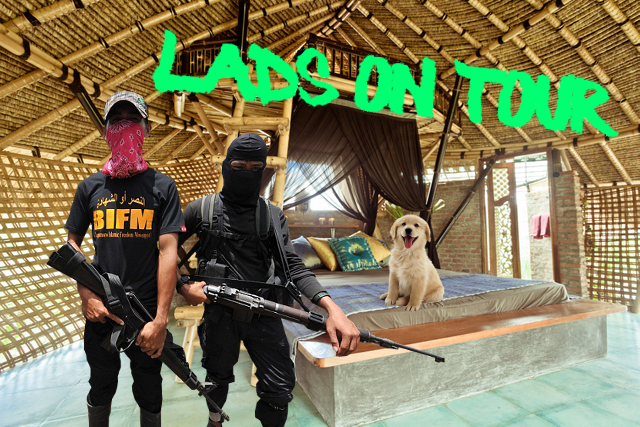
With her friends’ enthusiasm and her parents’ consent Amber left for Italy. Between 2014 and 2017 she travelled across the world, first moving in small steps, from Italy to Slovenia, to Bulgaria and Turkey. From Turkey she jumped around the Middle East and North Africa, avoiding conflict zones and skipping countries whose religious codes might frown upon her displayed body. Everywhere she went she befriended new contacts to utilise, chic twenty-somethings who’d invite her to their parents’ villas, rich bankers who’d get her into rooftop parties. Courting the cultural elite was vital; she didn’t have the financial reserves to fund a lavish lifestyle, but she could enter those worlds and achieve an image of effortless glamour.
By the time she reached the Moroccan coast she’d amassed over 75K followers. Enough to be on the radar of international PR girls. Invitations started flying in: five star luxury hotels and exotic adventures. Whilst sipping alcohol-free cocktails and bronzing her skin, she strategised her next move.
She flew to Malta, then across the Atlantic, island-hoping round the Caribbean. In America she visited boutique ranches and hunted down bohemian culture. Down to Mexico, then South America, a perfect blend of high class living and poverty porn. From South America she crossed the Pacific, stopping in at Hawaii on the way, then modern China and finally, in early 2017, Indonesia.
The world first knew something had gone wrong for Ms Hinton was when she posted a unusual message on Twitter. For three days she’d been five star eco-glamping in the rain-forested hills of Lombok, swimming in waterfalls, taking selfies with monkeys and then suddenly:
@amber_abroad
I heard a gun shot! What do I do! HELP HELP HELP
Minutes later a second tweet followed:
@amber_abroad
They said my name, tell me parents I love them
Within minutes a storm of activity was echoing around the Twitter-sphere and #saveamber was the number one trending topic on social media. Facebook campaigns began and Indonesian public officials were receiving flak from latte drinking yuppies in North London. By the second day the Foreign Office had publicly announced that British tourists in Indonesia were advised to leave the country immediately. Typically slow to respond, but then absolutely committed, ISIS announced that Ms Hinton’s abduction had been orchestrated by them, despite it obviously being carried out by a unassociated cell with little to no connection with the upper echelons. For three consecutive days BBC Breakfast News dedicated a half hour to the unfolding crisis; they even flew Naga Munchetty out to Bali to goad tourists into overreactions.
Five days of media fixation were followed by a week of not giving a damn; then out of the blue something very odd began to happen. Instagram accounts operating out of the Indonesian and Philippine ISIS territories started taking on a much more aesthetically sensitive tone. Poorly photoshopped images were replaced with a wave of creative shots. Against verdant jungle foliage, handsome young fighters were pictured topless, sweat glistening on their ripped pecks, rifles casually held over their shoulders. Puppies were photographed wrapped in ISIS flags. Trope travel images, ‘everyone jumping on the beach together’ and ‘girl leading boy’, were bastardised into calls to martyrdom.

At first Amber’s family was relieved; their daughter was alive and communicating with the world. Security services reassured them that eventually she would reveal her position, then they’d be able to plan her rescue. Weeks developed into months and still it seemed Amber was so tightly under the thumb of her captors that she couldn’t encode a message. All they could do was watch her PR strategy unfold.
Back home Theresa May used the crisis to spearhead her personal campaign against social media giants and internet freedoms. “By doing nothing, Instagram encourages ISIS”. In truth they were shutting down hundreds of accounts each day and actively handing data to the NSA and GCHQ.
By the time a video appeared online, ‘Amber’s Top 5 Tips For The Perfect Jihadi Pic’, Theresa had reached her line in the sand. Co-ordinating with the Indonesian President Joko Widodo, Ms Hinton was marked a priority target. If and when they had a lock on her location, an American drone would strike.
The final Instagram post attributed to Ms Hinton was posted on the 25th of June 2017.
For three weeks MI6 had been working in close communication with Indonesian intelligence officials to triangulate her location, scrutinising every post for a telltale clue. Eventually it was a sun umbrella that gave her away; its pattern of red and yellow stripes was attributed to a hotel on a recently occupied island. The post was confirmed as being a Amber original due to her characteristic use of the Juno filter and the Smiling Cat Face With Heart-Eyes emoji.
Amber’s parents were never told the truth about their daughter’s death. Several months afterwards a nice man from the intelligence services told them they believed ISIS had killed her, citing a lack of posts as evidence. Communications were falsified when they demanded proof. They were never shown the photos of her charred scalp, or the one of her left foreleg on the beach; it’d be blown clean clear of the hotel. In the end only a few people, in secret rooms, ever saw the evidence. None of the photos ever made their way online.
The New Observatory opened at FACT, Liverpool on Thursday 22nd of June and runs until October 1st.
The exhibition, curated by Hannah Redler Hawes and Sam Skinner, in collaboration with The Open Data Institute, transforms the FACT galleries into a playground of micro-observatories, fusing art with data science in an attempt to expand the reach of both. Reflecting on the democratisation of tools which allow new ways of sensing and analysing, The New Observatory asks visitors to reconsider raw, taciturn ‘data’ through a variety of vibrant, surprising, and often ingenious artistic affects and interactions. What does it mean for us to become observers of ourselves? What role does the imagination have to play in the construction of a reality accessed via data infrastructures, algorithms, numbers, and mobile sensors? And how can the model of the observatory help us better understand how the non-human world already measures and aggregates information about itself?
In its simplest form an observatory is merely an enduring location from which to view terrestrial or celestial phenomena. Stone circles, such as Stonehenge in the UK, were simple, but powerful, measuring tools, aligned to mark the arc of the sun, the moon or certain star systems as they careered across ancient skies. Today we observe the world with less monumental, but far more powerful, sensing tools. And the site of the observatory, once rooted to specific locations on an ever spinning Earth, has become as mobile and malleable as the clouds which once impeded our ancestors’ view of the summer solstice. The New Observatory considers how ubiquitous, and increasingly invisible, technologies of observation have impacted the scale at which we sense, measure, and predict.
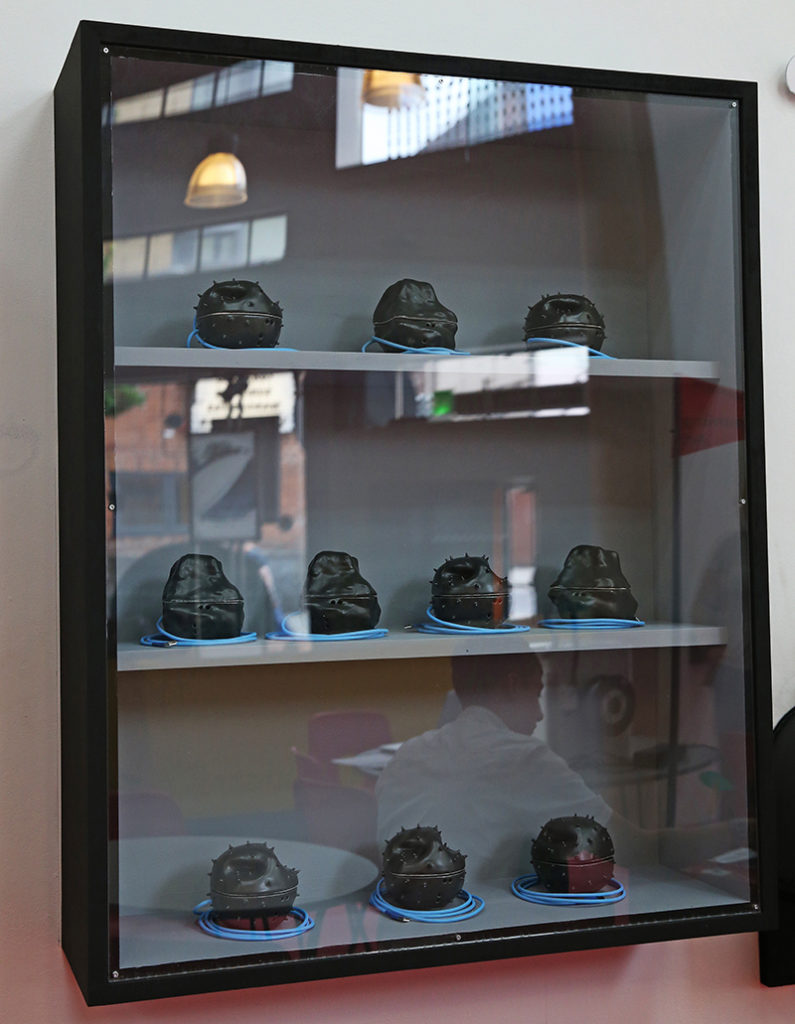
The Citizen Sense research group, led by Jennifer Gabrys, presents Dustbox as part of the show. A project started in 2016 to give residents of Deptford, South London, the chance to measure air pollution in their neighbourhoods. Residents borrowed the Dustboxes from their local library, a series of beautiful, black ceramic sensor boxes shaped like air pollutant particles blown to macro scales. By visiting citizensense.net participants could watch their personal data aggregated and streamed with others to create a real-time data map of local air particulates. The collapse of the micro and the macro lends the project a surrealist quality. As thousands of data points coalesce to produce a shared vision of the invisible pollutants all around us, the pleasing dimples, spikes and impressions of each ceramic Dustbox give that infinitesimal world a cartoonish charisma. Encased in a glass display cabinet as part of the show, my desire to stroke and caress each Dustbox was strong. Like the protagonist in Richard Matheson’s 1956 novel The Shrinking Man, once the scale of the microscopic world was given a form my human body could empathise with, I wanted nothing more than to descend into that space, becoming a pollutant myself caught on Deptford winds.
Moving from the microscopic to the scale of living systems, Julie Freeman’s 2015/2016 project, A Selfless Society, transforms the patterns of a naked mole-rat colony into an abstract minimalist animation projected into the gallery. Naked mole-rats are one of only two species of ‘eusocial’ mammals, living in shared underground burrows that distantly echo the patterns of other ‘superorganism’ colonies such as ants or bees. To be eusocial is to live and work for a single Queen, whose sole responsibility it is to breed and give birth on behalf of the colony. For A Selfless Society, Freeman attached Radio Frequency ID (RFID) chips to each non-breeding mole-rat, allowing their interactions to be logged as the colony went about its slippery subterranean business. The result is a meditation on the ‘missing’ data point: the Queen, whose entire existence is bolstered and maintained by the altruistic behaviours of her wrinkly, buck-teethed family. The work is accompanied by a series of naked mole-rat profile shots, in which the eyes of each creature have been redacted with a thick black line. Freeman’s playful anonymising gesture gives each mole-rat its due, reminding us that behind every model we impel on our data there exist countless, untold subjects bound to the bodies that compel the larger story to life.
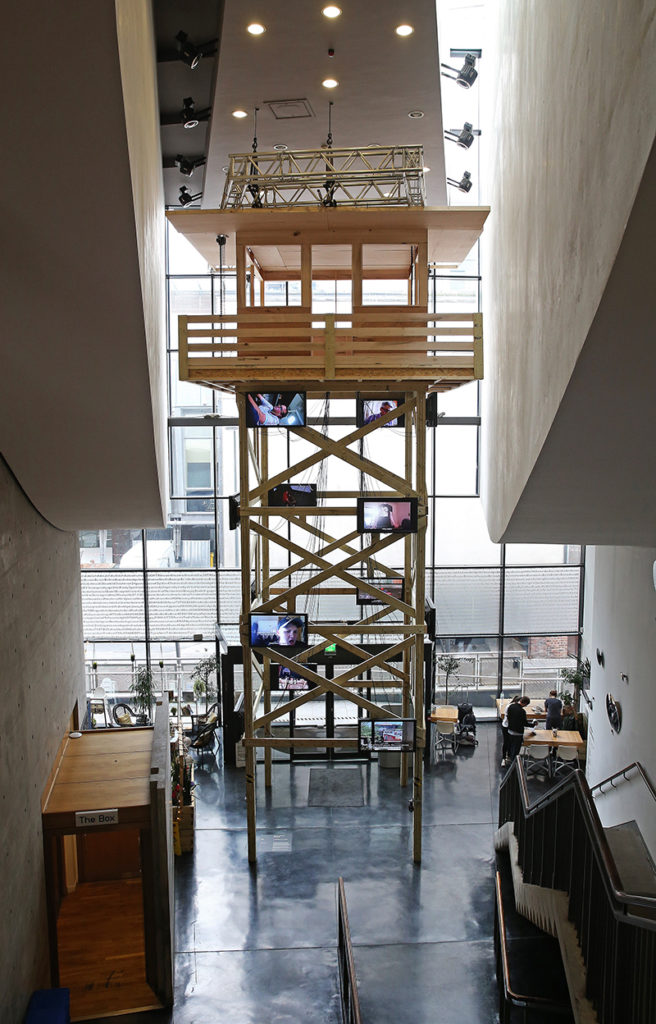
Natasha Caruana’s works in the exhibition centre on the human phenomena of love, as understood through social datasets related to marriage and divorce. For her work Divorce Index Caruana translated data on a series of societal ‘pressures’ that are correlated with failed marriages – access to healthcare, gambling, unemployment – into a choreographed dance routine. To watch a video of the dance, enacted by Caruana and her husband, viewers must walk or stare through another work, Curtain of Broken Dreams, an interlinked collection of 1,560 pawned or discarded wedding rings. Both the works come out of a larger project the artist undertook in the lead-up to the 1st year anniversary of her own marriage. Having discovered that divorce rates were highest in the coastal towns of the UK, Caruana toured the country staying in a series of AirBnB house shares with men who had recently gone through a divorce. Her journey was plotted on dry statistical data related to one of the most significant and personal of human experiences, a neat juxtaposition that lends the work a surreal humour, without sentimentalising the experiences of either Caruana or the divorced men she came into contact with.
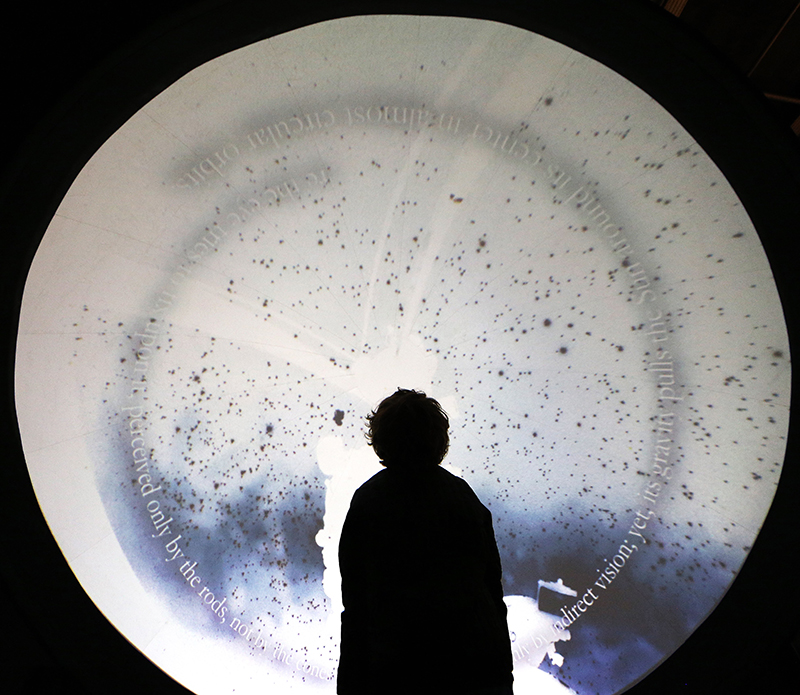
The New Observatory features many screens, across which data visualisations bloom, or cameras look upwards, outwards or inwards. As part of the Libre Space Foundation artist Kei Kreutler installed an open networked satellite station on the roof of FACT, allowing visitors to the gallery a live view of the thousands of satellites that career across the heavens. For his Inverted Night Sky project, artist Jeronimo Voss presents a concave domed projection space, within which the workings of the Anton Pannekoek Institute for Astronomy teeter and glide. But perhaps the most striking, and prominent use of screens, is James Coupe’s work A Machine for Living. A four-storey wooden watchtower, dotted on all sides with widescreen displays wired into the topmost tower section, within which a bank of computer servers computes the goings on displayed to visitors. The installation is a monument to members of the public who work for Mechanical Turk, a crowdsourcing system run by corporate giant Amazon that connects an invisible workforce of online, human minions to individuals and businesses who can employ them to carry out their bidding. A Machine for Living is the result of James Coupe’s playful subversion of the system, in which he asked mTurk workers to observe and reflect on elements of their own daily lives. On the screens winding up the structure we watch mTurk workers narrating their dance moves as they jiggle on the sofa, we see workers stretching and labelling their yoga positions, or running through the meticulous steps that make up the algorithm of their dinner routine. The screens switch between users so regularly, and the tasks they carry out as so diverse and often surreal, that the installation acts as a miniature exhibition within an exhibition. A series of digital peepholes into the lives of a previously invisible workforce, their labour drafted into the manufacture of an observatory of observations, an artwork homage to the voyeurism that perpetuates so much of 21st century ‘online’ culture.
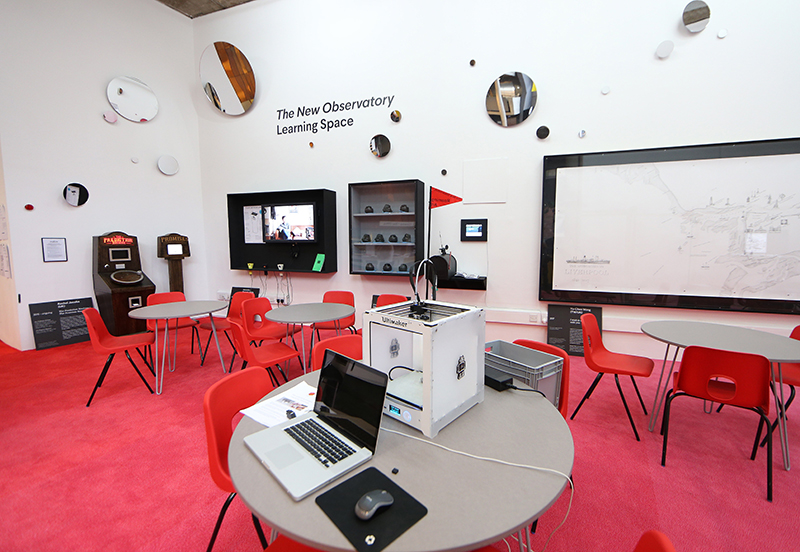
The New Observatory is a rich and varied exhibition that calls on its visitors to reflect on, and interact more creatively with, the data that increasingly underpins and permeates our lives. The exhibition opened at FACT, Liverpool on Thursday 22nd of June and runs until October 1st.
“In a world full of conflicts and shocks,” has the past year become the, arguably, most standardized introduction, preempting, in an almost doomsday manner, articles, political speeches and curatorial statements alike. The world has turned Political (with capital P) and even the most mundane event is quickly made part of current politics, which in turn, seems to occupy a space somewhere between reality TV and satire. One feels the same dreadful fascination as when watching accident videos on YouTube; with eyes hypnotically fixed to the screen as we observe our world digress into an ever-growing state of chaos. A general unease can be traced throughout the world, and even the most apolitical communities are mobilizing at each side of the spectrum, in the desperate search for ways to overcome the immediate and underlying threats-at-hand.
It is within this urgent search for solutions, that this year’s Venice Biennale positions itself. The 57th biannual gathering of today’s most prominent instances of Contemporary Art, offer, under the lead of curator Christine Macel, its own proposal as to how we might address our sometimes-hopeless situation. And, perhaps surprisingly, we are in fact given an answer, which eschews the otherwise often-ambiguous and overly-complicated musings traditionally marking the Art World. Within the manifesto of the biennale, immediately greeting you as you enter the Giardini venue located South of the City, Macel calls for a return to humanism, expressing the need for a new-found believe in the power and agency of humans. And not just any human; particular emphasis is given to the Artist, the persona through which, supposedly, “the world of tomorrow takes shape.”
Structurally, the role of the artist is explored over the course of nine chapters, spanning themes as distinct as ‘earth’, ‘colors’ and ‘time and infinity’. Each, we are told, does not only account for the artist’s practice in isolation, they further set out to investigate how such creative acts resonate and bring about change in the world.
One misses immediately this latter concern within the two first pavilions Artists and Books and Joys and Fears. We are invited into the space and mind of the artist, in what quickly becomes an introvert, almost nostalgic account of the studio, presented here as a place which escapes the neoliberal ideals of progress and productivity. One senses an immediate contradiction, being surrounded by pieces which literally embody the immaterial value so indicative of modern capitalism.
This haunting sense of conflict is occasionally placated, if only because many of the individual pieces go further than the prescribed curation, integrating a sense of criticality in their exploration of the art practice. As in the breathtaking video by Taus Makhacheva, in which a tightrope walker carries paintings between two cliffs, over a lethal fall, seemingly free, while caught in a pointless, repetitive and dangerous act, dictated by guidelines which goes beyond his immediate control. Or in the, now infamous work, by John Walter, Study Art Sign, which appropriates the language of advertisement in simple catch phrases such as “art – for fun or fame,” and in doing so, highlights the entanglement of any artistic act with commercial viability.
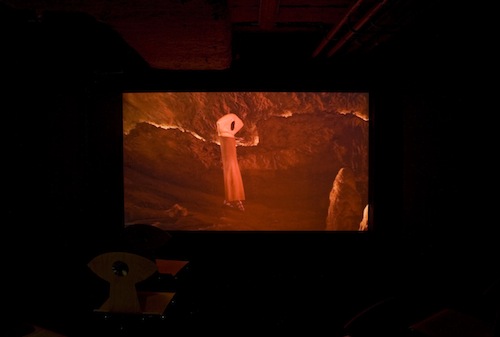
A 20-minute walk, and the habitual crossing of at least 5 Venetian bridges, brings you to the Arsenal pavilions, and the home of the next 7 chapters. The first two of these, Commons and Earth, are (at least superficially) more successful in exploring the link between the artist and the world at large. The exhibited pieces are centered around the creation of community or situations. They echo in this sense the much-disputed Relational Aesthetics as advocated by Nicolas Bourriaud, which defines contemporary art, as one of “interactive, user-friendly and relational concepts.”(1)
What Bourriaud and the Biennale both seem to overlook, is the inescapable mediation and exclusivity of artistic acts, despite any willingness to advocate inclusivity and openness. Because, let’s face it, none of the presented practices can be equaled to just another social situation – each and single one has been extensively documented, carefully edited and analyzed, to finally make their way into one of the most prestigious temples of contemporary art: The Venice Biennale anno 2017.
This does not make them insignificant, it simply means that one cannot feign apparent neutrality, as the emphasis on ‘anthropological approaches,’ seems to suggest. In fact, the more ‘honest’ pieces are the ones which embrace such mediation, exposing it, rather than hiding it behind a layer of innocent interaction. This is done brilliantly in the video piece of Charles Atlas, A Tyranny of Consciousness – an epic compilation of sunsets, countdowns and disco. The groovy lyrics, ‘You were the one, I blew it, it’s my own damn fault,’ sung by the iconic drag queen Lady Bunny, is given new meaning in the context of environmental, human-provoked disasters.
This is done, while avoiding any moralistic undertones. Rather, the piece dares to reflect the ambiguity which defines the actual human-earth-relation, and through this, overcomes the simplified ‘if we all work together it’ll be fine’ attitude, otherwise permeating the majority of the exhibited work.
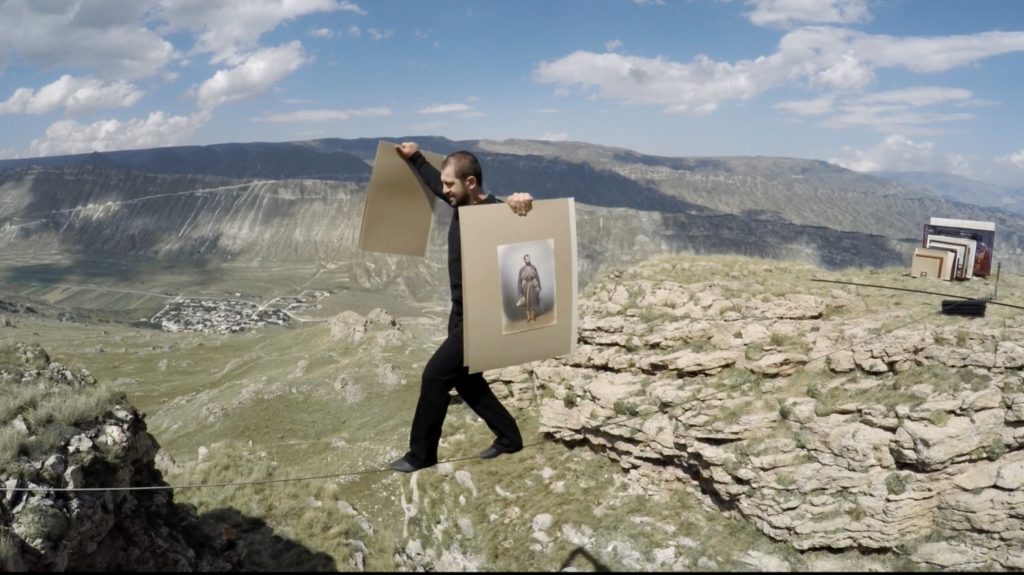
Within Traditions, the chapter following, the most successful pieces are similarly those which allow for complexity and move beyond an often much-too-obvious contrasting of the old with the new. One notable example, is the piece by Guan Xiao, which traces the famous statue David by Michelangelo. In bringing together numerous amateur-looking clips capturing this iconic figure, she humorously points to how objects ironically become invisible, through our extensive documentation of them; as hidden behind the connotations and expectations which come to shape the way we perceive our cultural heritage.
On entering the next theme of Shamanism, the first piece which meets the visitor is by Ernesto Neto – a tent-like installation made up of robes, under which guests are offered a place to rest. The otherwise beautiful piece come to look like a feature of Burning Man, with hippie-esque slogans such as ‘with love and gratitude to mother earth’ or ‘’war is not good, gold is life,“ covering the surrounding walls.
What Macel here wants to explore is the artist as magician or healer. While attempts of healing is sympathetic (and needed), such efforts are undermined by, a once again, rather naïve approach. It seems as if the striking similarity to the peace-promoting, but notoriously exclusive, festival is not only aesthetic. There is a failure at acknowledging the difference between giving the (very specific demographic of) biennale goers a place for momentary reflection, and the large-scale healing announced in the curatorial statement.
This pseudo-commitment to seventies politics carries over to the Dionysian Pavilion, which ‘celebrates the female body and its sexuality’. The decision to dedicate a pavilion specifically to female artists and femaleness implicitly tells us that
a) womanhood is still something distinct, which should be explored separately from other identity politics
b) women artists need their own space, neatly separated from the rest of the pavilion (which is, interestingly, dominated by male artists)
We see here not only a return to humanism, but the ugliest of humanisms, one which still insists on highlighting an assumed distinction between manhood and womanhood. Such essentialist undertones are only enforced by the first part of the pavilion which greets you with pastels, vaginas and a propensity for weaving.
While the theme might be questionable, we do, while moving through the pavilion, find some incredibly strong pieces, which insists on addressing the individual in its many nuances and confused nature. This is particularly present in the all-encompassing installation/sound/performance work of artists Pauline Curnier Jardin, Mariechen Danz and Kadar Attia.
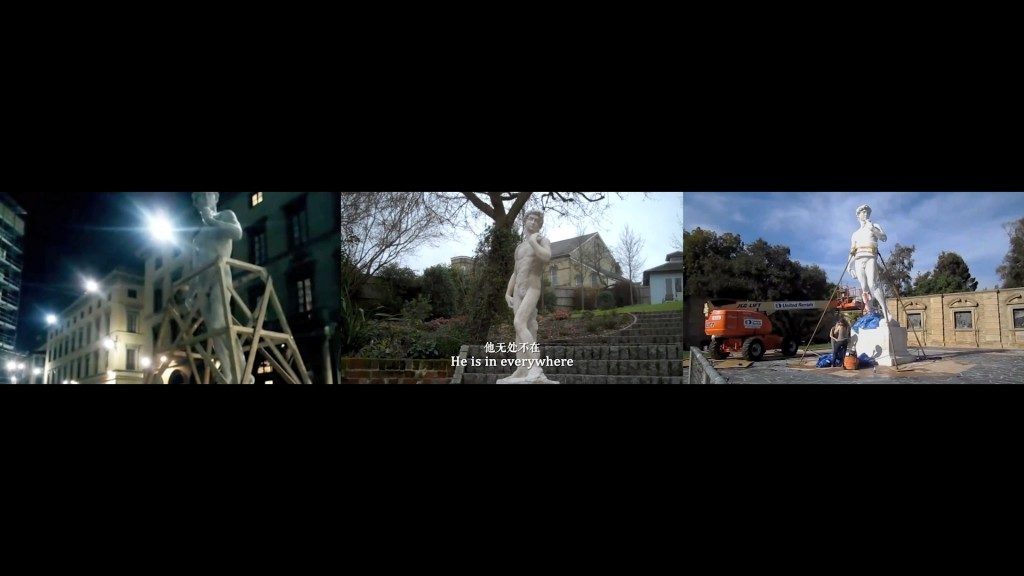
This far-reaching journey culminates in the chapters Colours and Time and Infinity which bombastically sets out to explore the way artist come to influence that which exists outside and before a human sphere. Within both pavilions, there is a distinct failure at acknowledging the specificity of the individual works, which, besides from their formal qualities, seems to have little to do with either Colours or Time. Once more the curation, ironically, overshadows, rather than enhances, the complexity of the individual works at stake.
It is symptomatic of the, perhaps biggest, misunderstanding of this year’s biennale: That a return to the artist, or the human more generally, is what will allow us to understand and surpass our current state of crisis. It seems to overlook that our anthropocentric attitude is what originally brought us into trouble. Just as the individual pieces of art are diluted by insisting on the narrow focus of the artist, so does humanism distract us from the complexity of the world in which the human is only one part out of many. It simply seems outdated to return to the human-figure, conceptually broken by critical theory and practically threatened by developments in AI. Rather we need to accept, as many of the brilliant pieces do, a state in which humans are not in control; which allows for spaces of ambiguity and contingency. We do not need a return to humanism. Rather, now is a time to be humble, to look outside of humanity and think beyond that which already was, and never really worked in the first place.
Carla Gannis and Alan Sondheim will be talking about their artwork featured in the new exhibition at Furtherfield Gallery, Children of Prometheus.
In the exhibition Carla Gannis updates Hieronymus Bosch’s famous triptych in her Garden of Emoji Delights replacing medieval religious symbolism with an emotion-inspired iconography for the 21st century. Bosch’s painting was made between 1490 and 1510. In the original, the left panel depicts God presenting Eve to Adam, the central panel is a broad panorama of socially engaged nude figures, fantastical animals, oversized fruit and hybrid stone formations. The right panel is a hellscape and portrays the torments of damnation. Gannis’s contemporary version plays on the original themes, and even expresses hedonism. However, there is another message looming in the work. That, even though we are entwined today in our digital networks, products of hyper-capitalism, and technological devices, learned culture, and acquired values: we are all feral beings at our core.
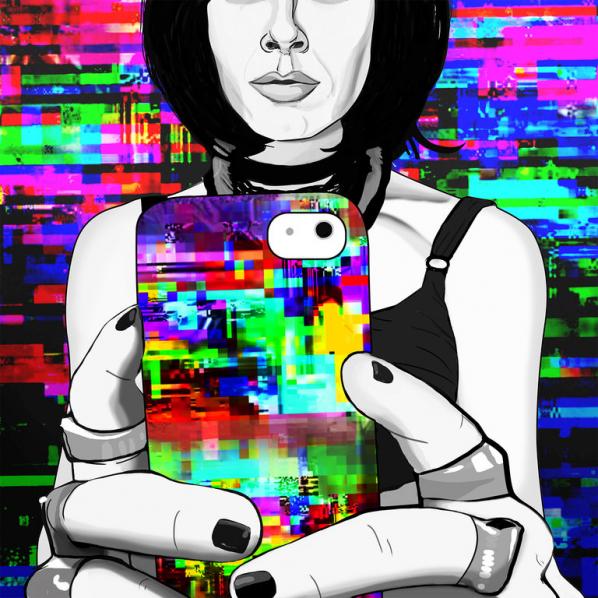
In the exhibition, Alan Sondheim presents Avataurror, a series of 3D printed avatars and videos representing distorted, wounded, problematic bodies, and their relationship to states of violence and genocide, where cracks and wounds are eternally everywhere and nowhere. Most of what Alan does, is grounded in philosophy – ranging from phenomenology to current philosophy of mathematics to his own writing. “I’m interested in the ‘alien’ which isn’t such of course, which is blankspace. (The alien is always defined within edge spaces and projections; we project into the unknown and return with a name and our fears and desires.)”

Carla Gannis is an artist who lives and works in Brooklyn, New York. She received a BFA in painting from The University of North Carolina at Greensboro and an MFA in painting from Boston University. In the late 1990s she began incorporating net and digital technologies into her work. Gannis is the recipient of several awards, including a 2005 New York Foundation for the Arts (NYFA) Grant in Computer Arts, an Emerge 7 Fellowship from the Aljira Art Center, and a Chashama AREA Visual Arts Studio Award in New York, NY. She has exhibited in solo and group exhibitions both nationally and internationally. She is currently Assistant Chair of Digital Arts at Pratt Institute in Brooklyn.
Alan Sondheim was born in Wilkes-Barre, Pennsylvania; he lives with his partner, Azure Carter in Brooklyn NY. A cross-disciplinary artist, writer, and theorist, he has exhibited, performed and lectured widely. Recently, Sondheim had a successful residency at Eyebeam Art + Technology Center in New York; while there he worked with a number of collaborators on performances and sound pieces dealing with pain and annihilation. He also created a series of texts and 3D printing models of ‘dead or wounded avatars.’ His ideas explore death, sex, space, time, terror and how these effect our psyche and the body.
More information about Children of Prometheus.
FREE
BOOKING IS ESSENTIAL – BOOK HERE
STRICTLY NO LATE ADMITTANCE
Choose Your Muse is a series of interviews where Marc Garrett asks emerging and established artists, curators, techies, hacktivists, activists and theorists; practising across the fields of art, technology and social change, how and what has inspired them, personally, artistically and culturally.
Ryota Matsumoto is a principal and founder of an interdisciplinary design office, Ryota Matsumoto Studio, and an artist, designer and urban planner. Born in Tokyo, he was raised in Hong Kong and Japan. After studies at Architectural Association in London and Mackintosh School of Architecture, Glasgow School of Art in early 90’s, he received a Master of Architecture degree from University of Pennsylvania in 2007. Before establishing his office, Matsumoto collaborated with a cofounder of the Metabolist Movement, Kisho Kurokawa, and with Arata Isozaki, Cesar Pelli, the MIT Media Lab and Nihon Sekkei Inc. He is currently an adjunct lecturer at the Transart institute, University of Plymouth.
Marc Garrett: Could you tell us who has inspired you the most in your work and why?
Ryota Matsumoto: As I have collaborated with the founders of the Metabolist movement of the 60s, Kisho Kurokawa and Arata Isozaki, and had the opportunity to meet Cedric Price at Bedford Square, I am keenly aware of the participatory techno-utopian projects by the Situationist International group. Some of the projects by Japanese Metabolism, Yona Friedman, and Andrea Branzi drew inspiration from the concept of unitary urbanism and further developed their own critical perspectives. Their work has helped me to create my own theoretical platform for the status quo urbanism and its built environment.
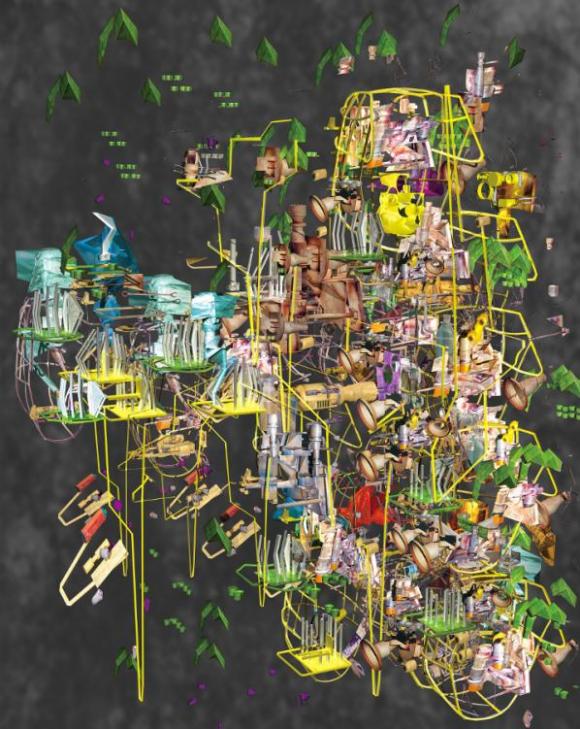
MG: How have they influenced your own practice and could you share with us some examples?
RM: I identify with the free-spirited and holistic approaches of these theorists on the relationship between language, narrative, and cognition. They embraced a wide range of media for visual communication that simultaneously defied categorization as either art or architecture and denounced the rigid policy-driven urban planning. Who would have thought of using photomontage, computer chips, PVC, or anything else they could get their hands on for architectural visualization in those days? Furthermore, their urban strategy of mobile/adaptable/expandable architecture and the theory of psychogeography dérive resonate with my own creative thinking. I interpret urbanization as the outcome of self-generating, spontaneous and collective intelligence design process and believe that the strategic use of hybrid media with incorporation of multi-agent computing provides an alternative approach for both art and design practice.
MG: How is your work different from your influences and what are the reasons for this?
RM: The utopian aspirations of the groups in the 60s were very much the product of the counter-cultural movement of the time: they were politically engaged and had optimistic outlooks for technology-driven progress of cities. In contrast, while I tend to address the current socio-cultural agendas of urban and ecological milieus, my work doesn’t necessarily evoke or represent the utopian or dystopian visions of spatial cities.
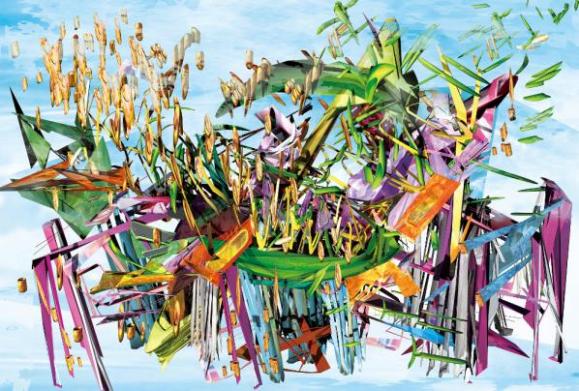

MG: Is there something you’d like to change in the art world, or in fields of art, technology and social change; if so, what would it be?
RM: I explore and question both sustainable and ethical issues of the urban environment that have been influenced by the socio-political realities of the Anthropocene, using visual/cognitive semantics, analogical reasoning, and narrative metaphors. As human population and energy use have grown exponentially with great acceleration, the interactive effects of the planet transforming processes on the environment are impending issues that we have to come to terms with. Thus, my projects hinge on how trans-humanism, the emergence of synthetic biotechnology, and nano-technological innovations can help us respond to the current ecological crisis.
“The themes of my work hinge on how the scientific tenets of trans-humanism, the emergence of synthetic biotechnology and Nano technological innovations might respond to the Anthropocene epoch, and, eventually foster critical thinking in relation to the underlying agendas of the increasing dominance of human-centric biophysical processes and the subsequent environmental crisis.” [1] (Matsumoto 2017)
With my recent work, the symbiotic interplay of the advanced biosynthetic technologies and the preexisting obsolete infrastructures has been explored to search for an alternative trajectory of future environmental possibilities. In short, new technologies can complement old ones instead of completely replacing them, to avoid starting over from a blank slate or facing further ecological catastrophes.
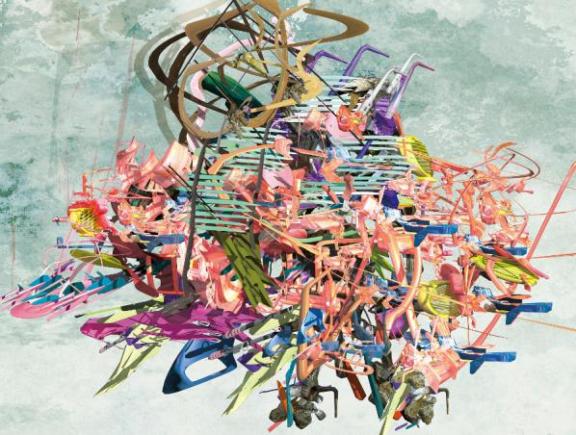
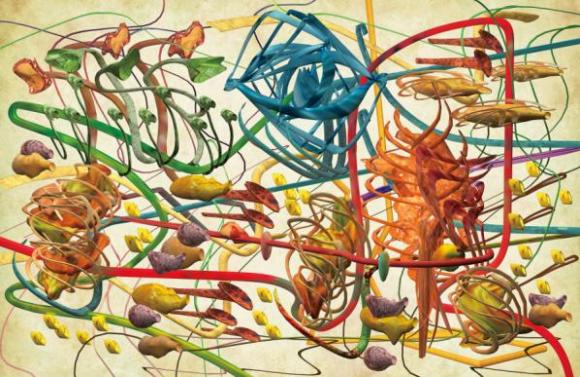
MG: Describe a real-life situation that inspired you and then describe a current idea or art work that has inspired you?
RM: I was fortunate enough to experience firsthand Hong Kong’s rapid urbanization driven by the staggering economic growth throughout 70s and early 80s. In hindsight, it could be called the beginning of rising prosperity in the Pearl River Delta region. I was fascinated by the fact that both the unregulated Kowloon Walled City and the newly-built Shanghai Bank Tower stood only a few miles apart from each other around the same period. They could be seen as two sides of the same coin, as they both represented the rapid and chaotic economic growth of Hong Kong at that time. It suddenly dawned on me that the juxtaposition and coexistence of polar-opposite elements connoted both visual tension and harmony in a somewhat intriguing way, regardless of their nature, function, and field. That contradiction nurtured and defined my own aesthetic perceptions in both visual art and urban design.
MG: What’s the best piece of advice you can give to anyone thinking of starting up in the fields of art, technology and social change?
Although it might sound like a career detour at first, it is always helpful to go off the beaten path before starting out as an artist. In my case, my experience as an architectural designer and urban planner certainly helped me to break the creative mold and approach my work with a broader perspective. Even now, I still firmly believe that it is always helpful to learn and acquire the wider knowledge and skills from other fields, and that opening up your mind to new ideas will allow you to discover your own unique path in your life.

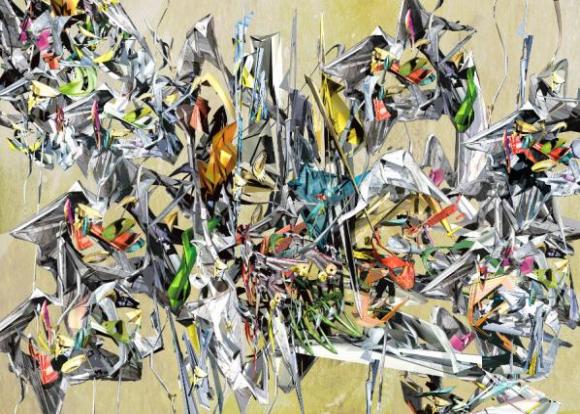
RM: Finally, could you recommend any reading materials or exhibitions past or present that you think would be great for the readers to view, and if so why?
The retrospective of Le Corbusier’s work is the last exhibition I’ve seen and it was very fascinating. He is a great innovator, who had managed to continually reinvent himself to stay ahead of the curve over the course of his life. If you are interested in 20th century architecture encompassing early modernism and the Brutalist movement, it is definitely worth visiting.